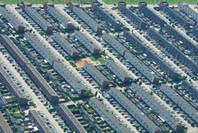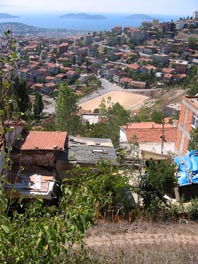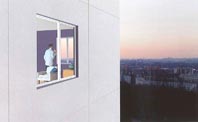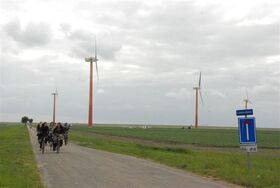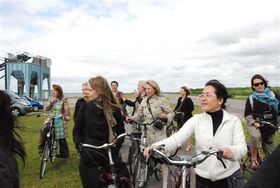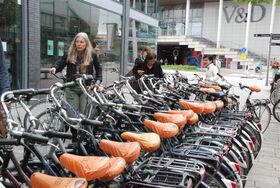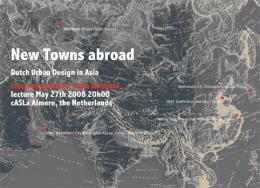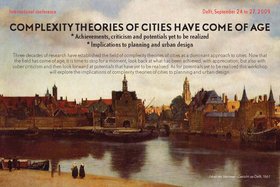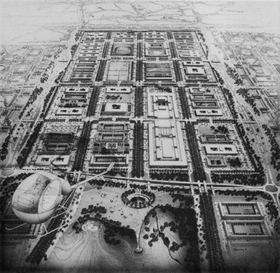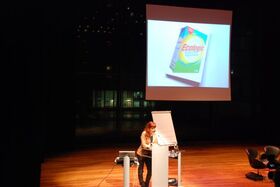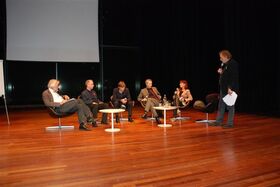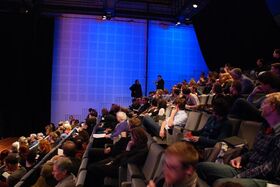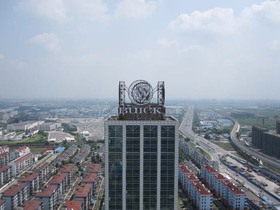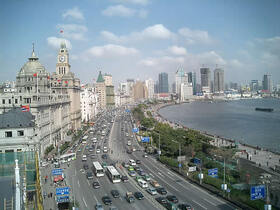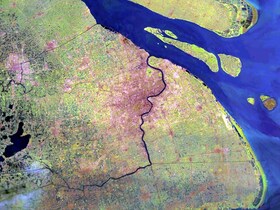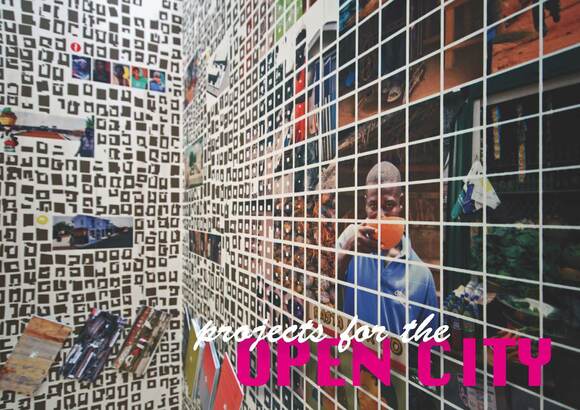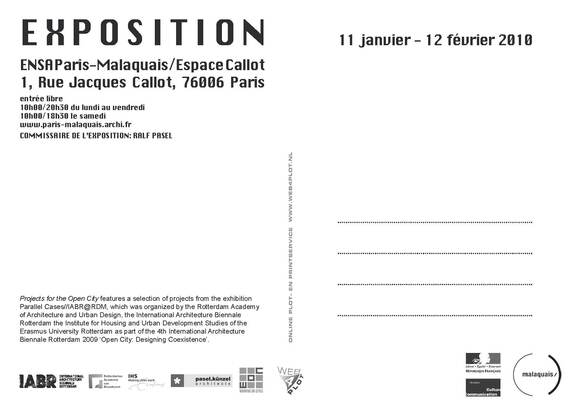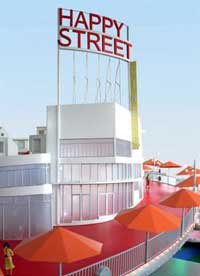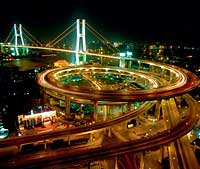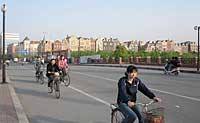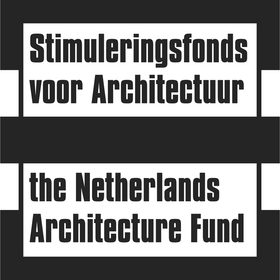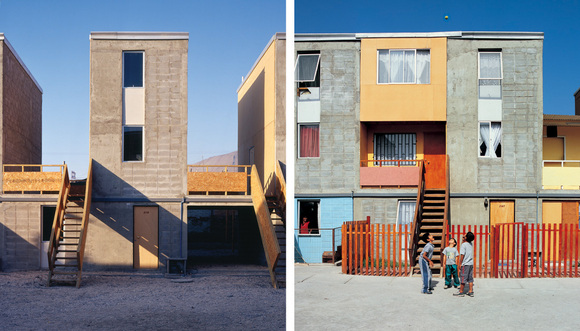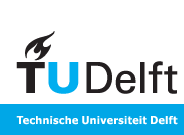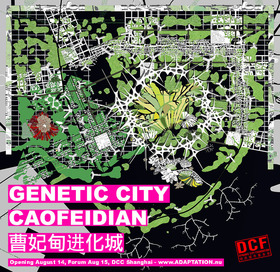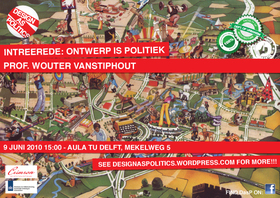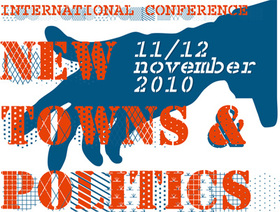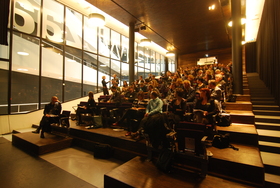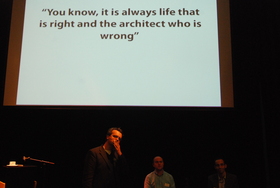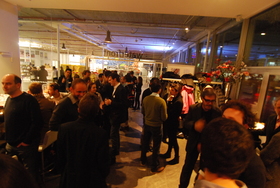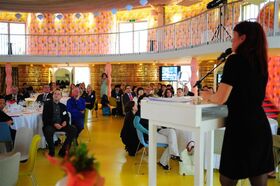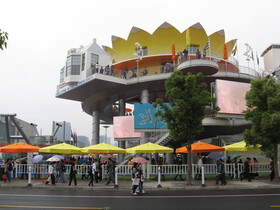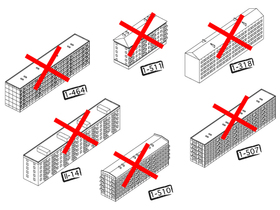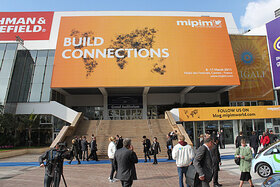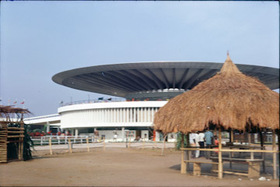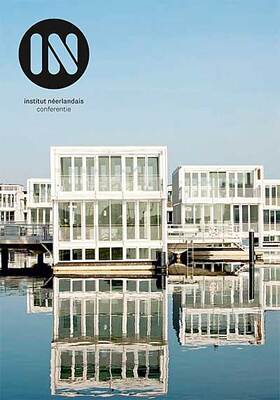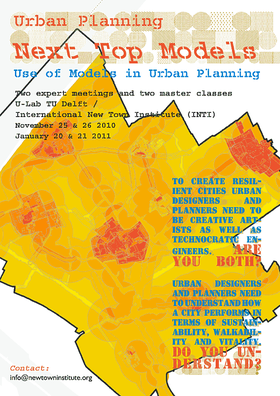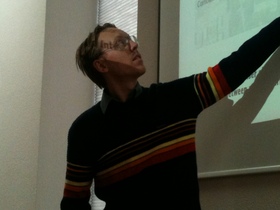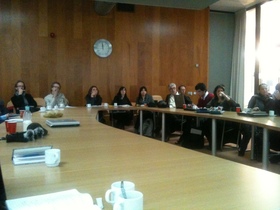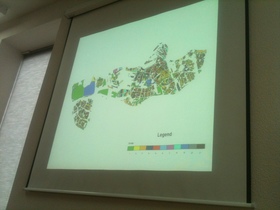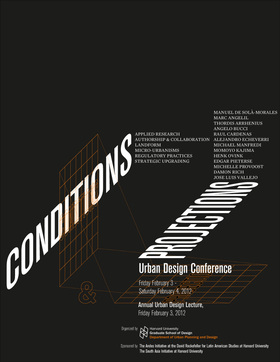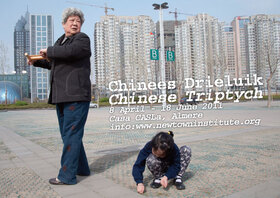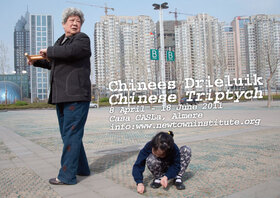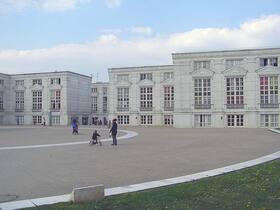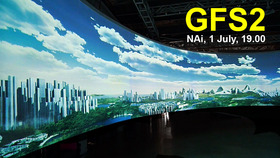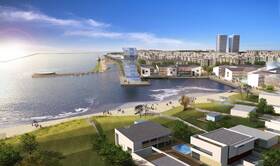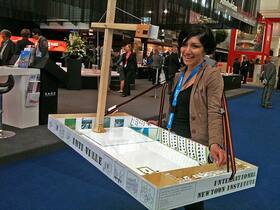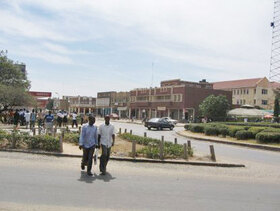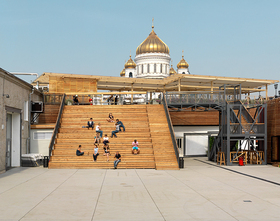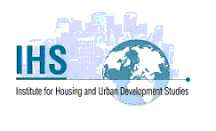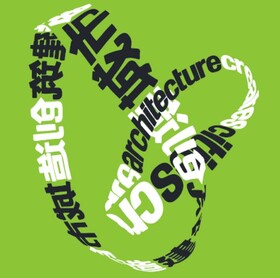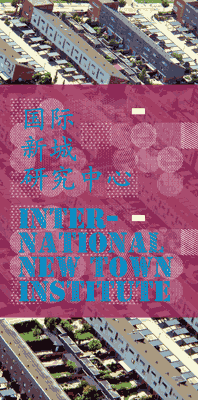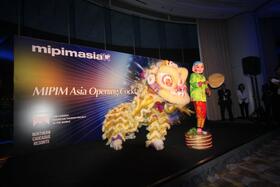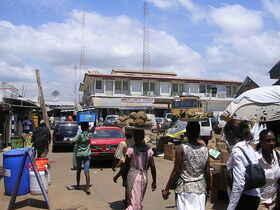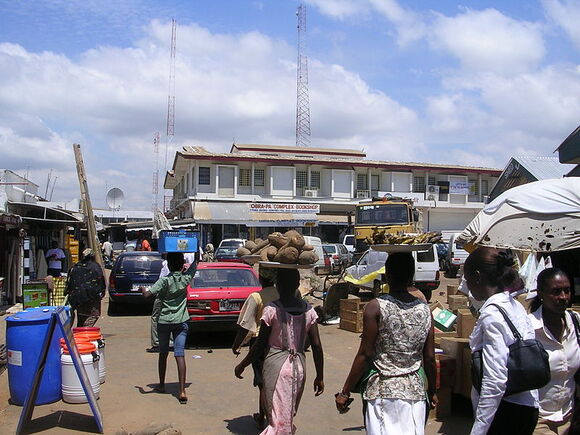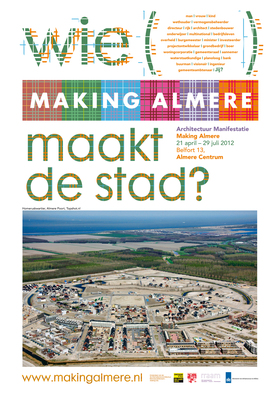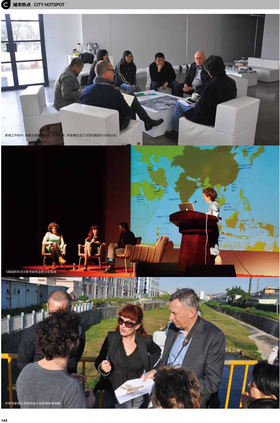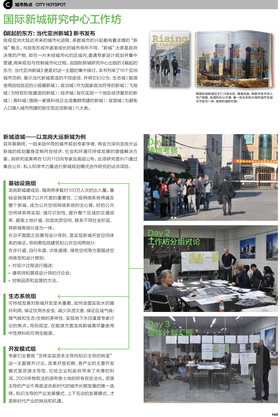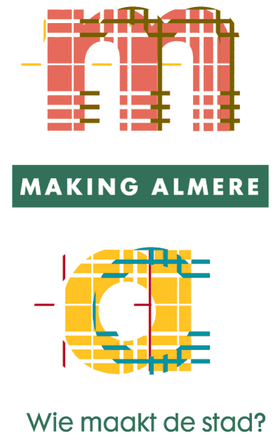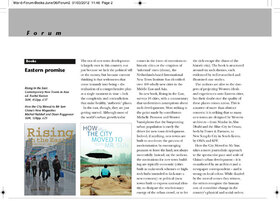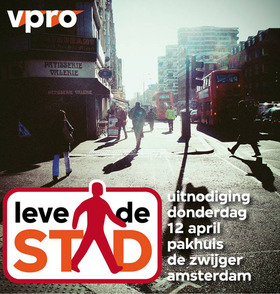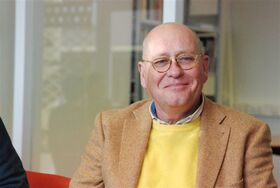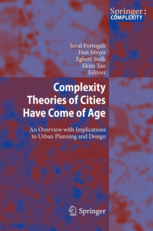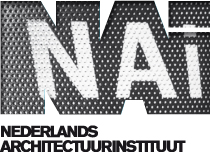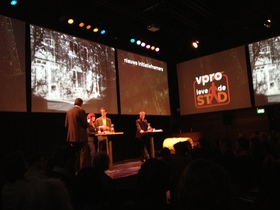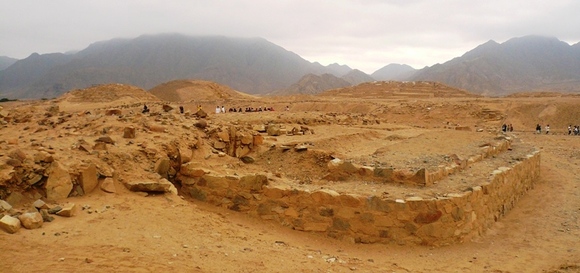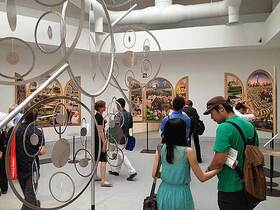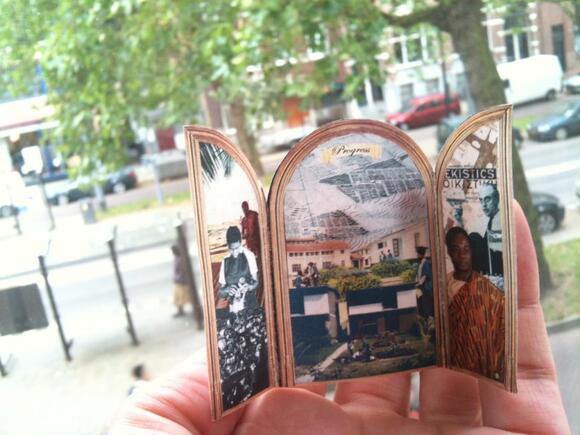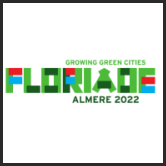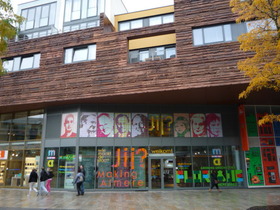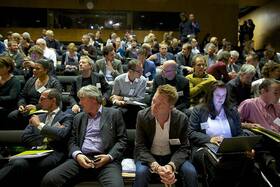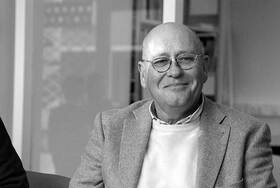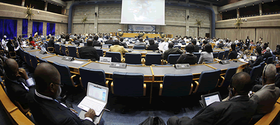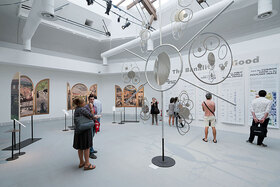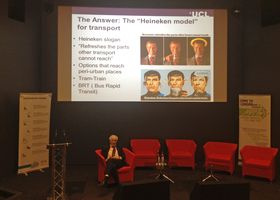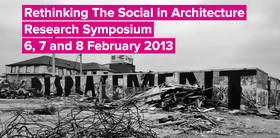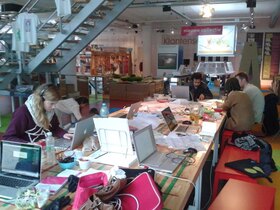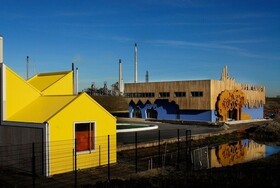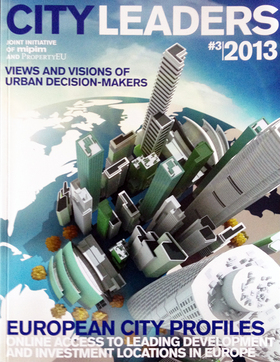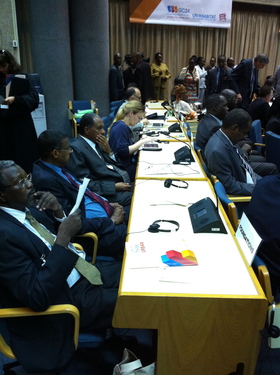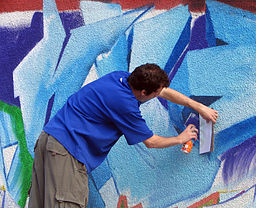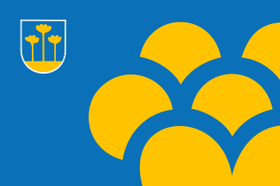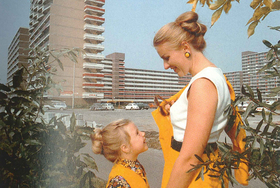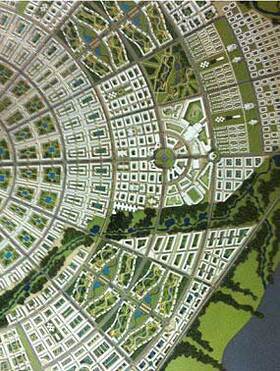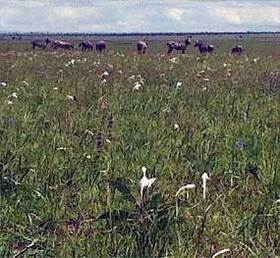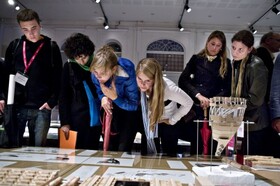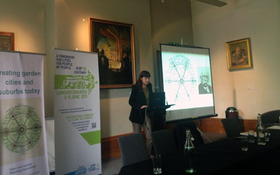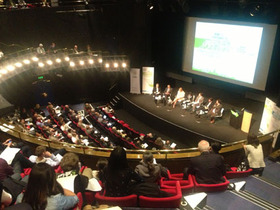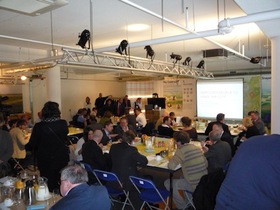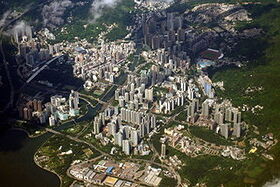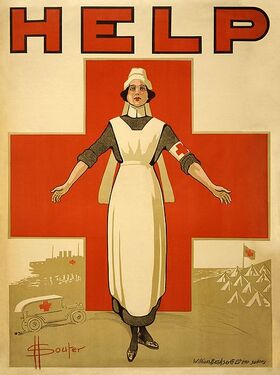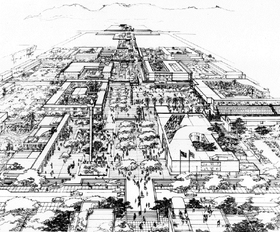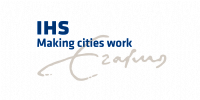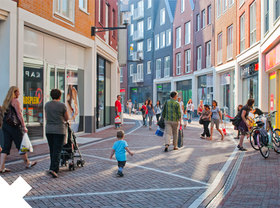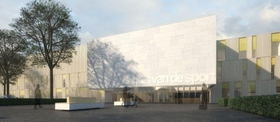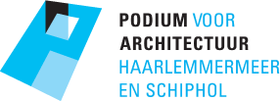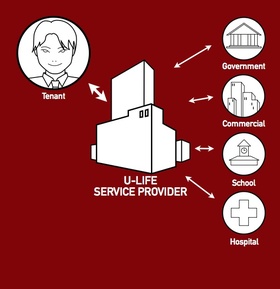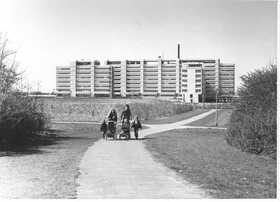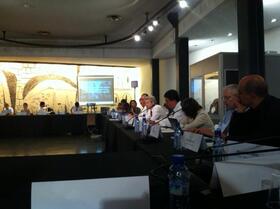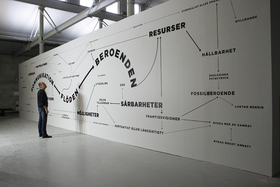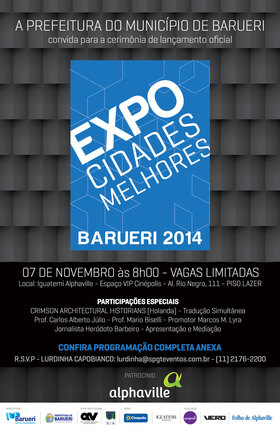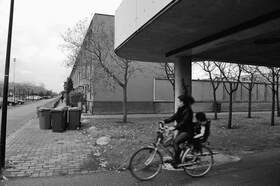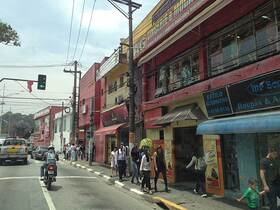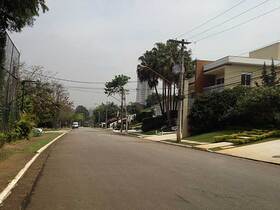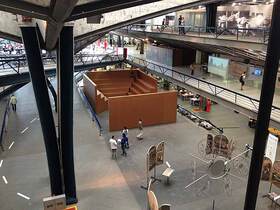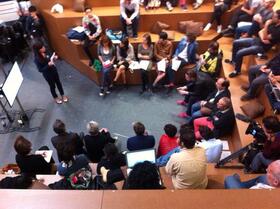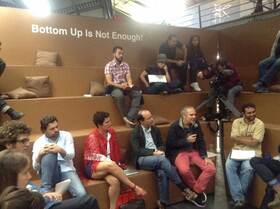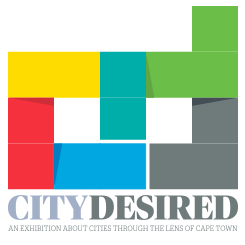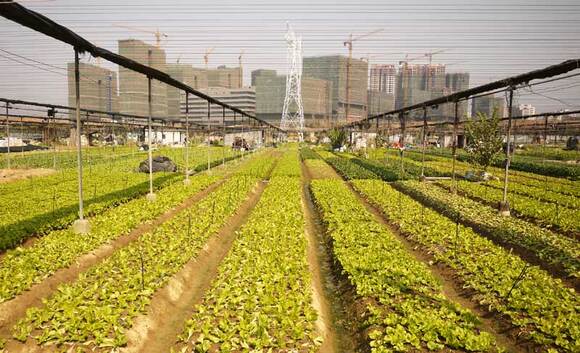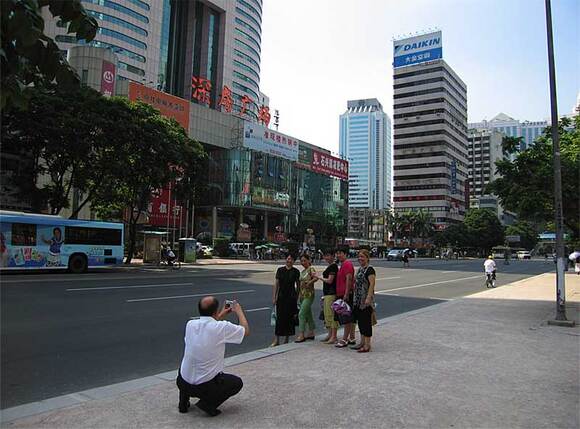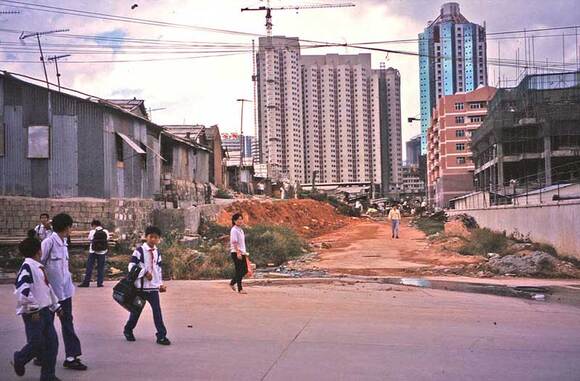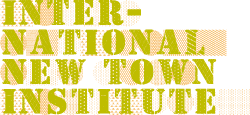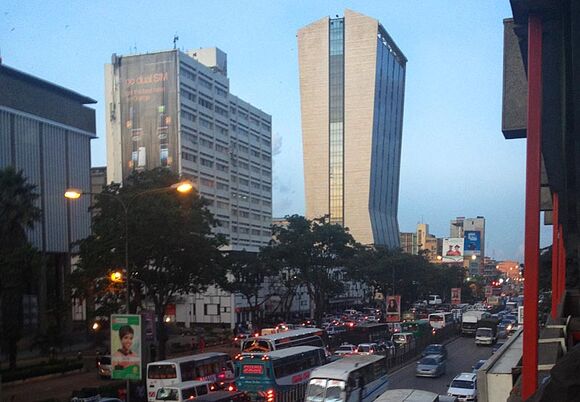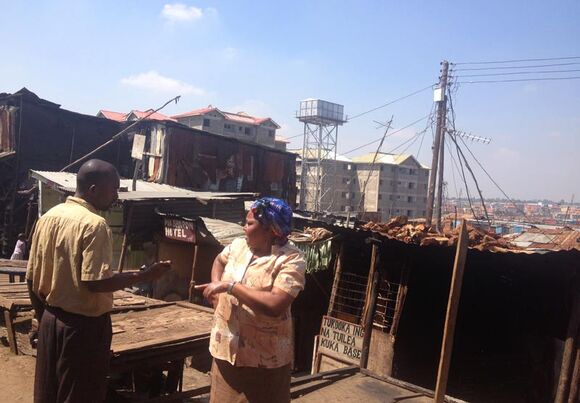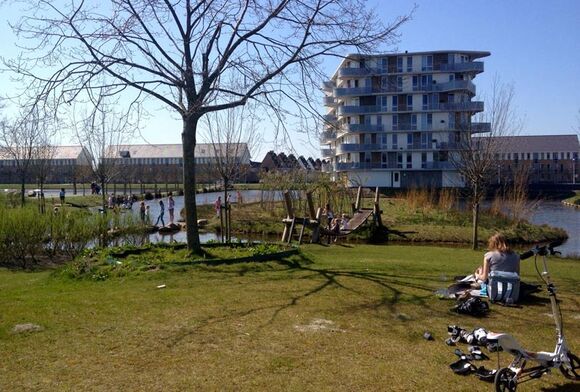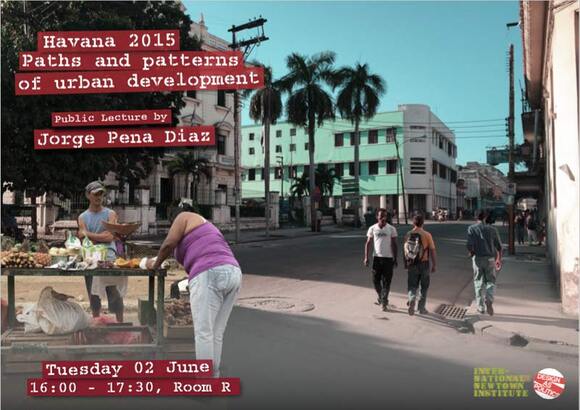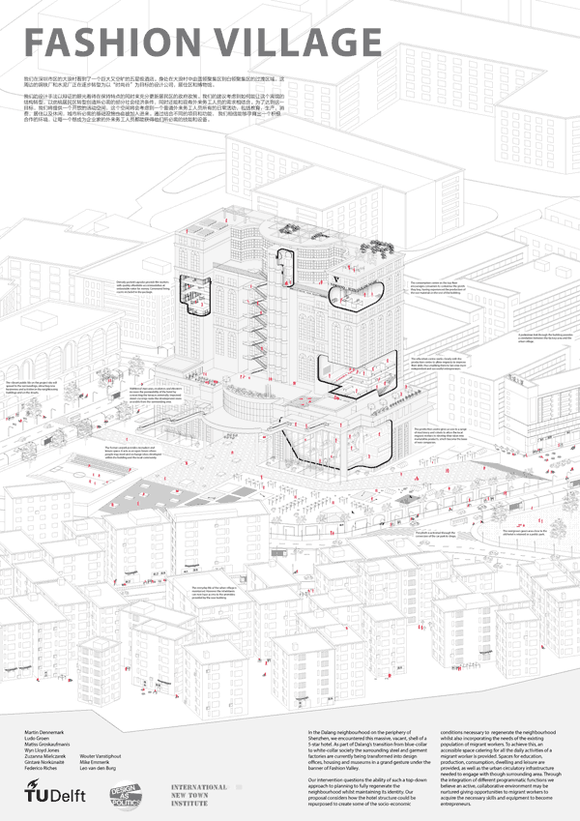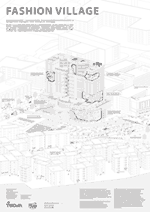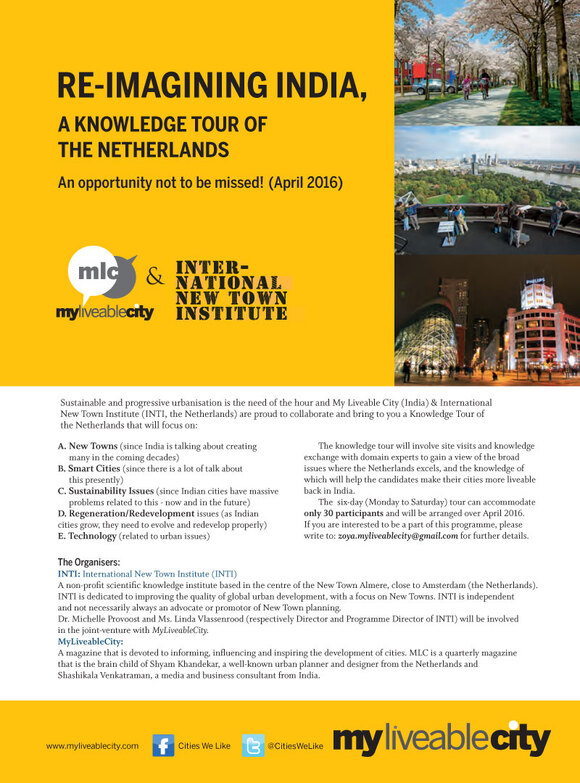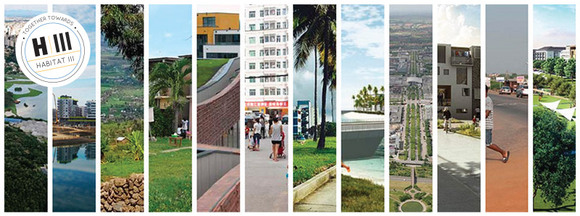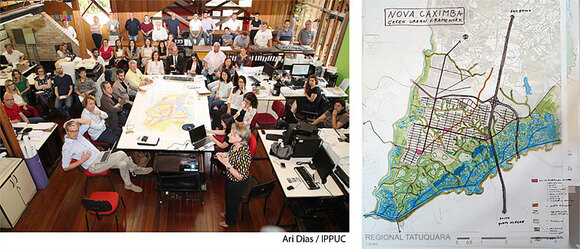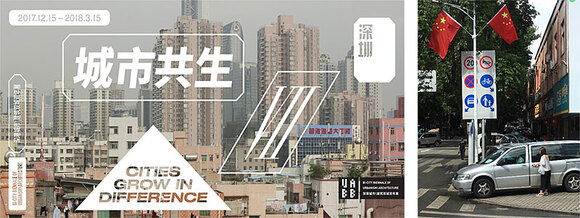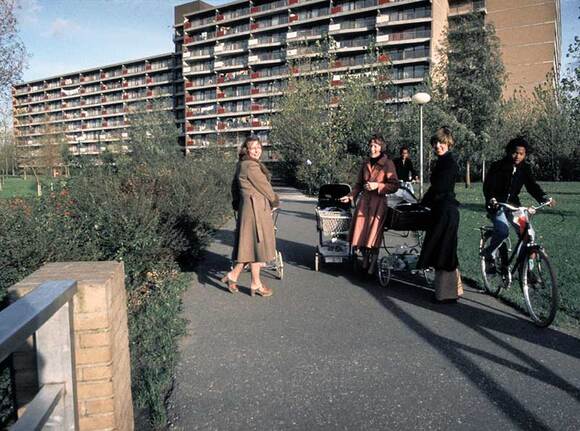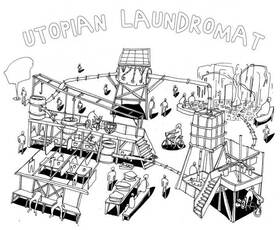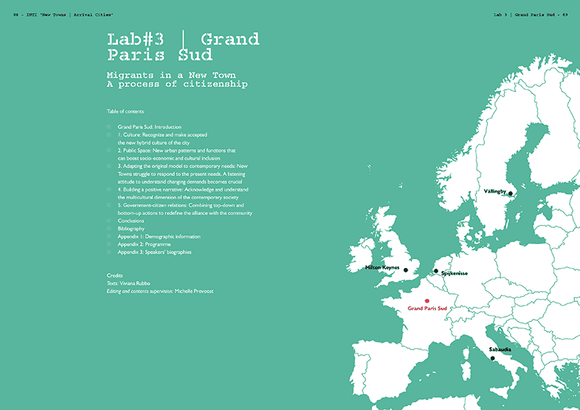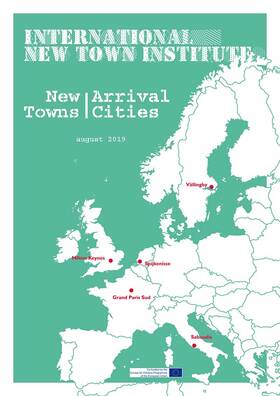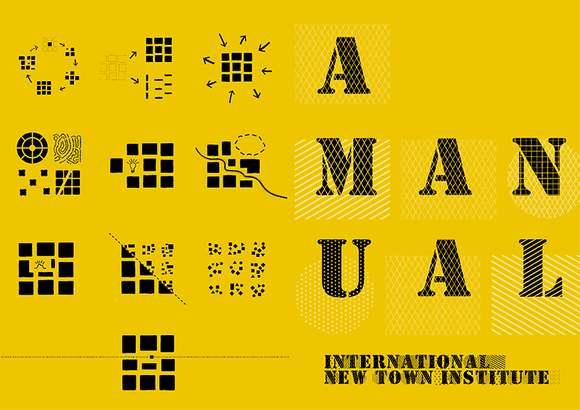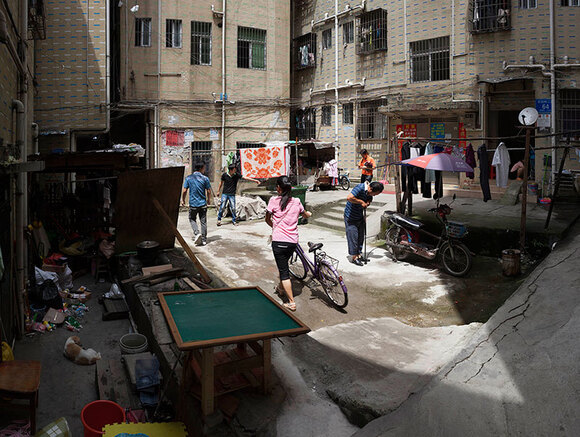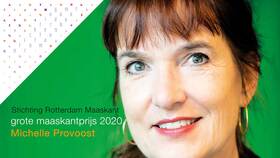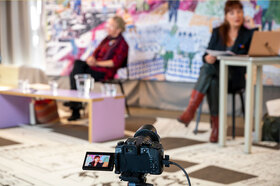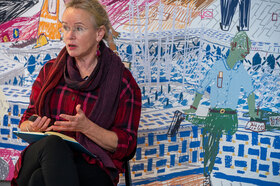The New Towns of the 20th Century were planned cities: they were built according to a blueprint designed by an architect or planner. From their inception, they were complete cities; rationally designed with a certain image of the city’s future in mind. They displayed a perfect equilibrium of infrastructure, housing, services and a social-economic and cultural identity. But what has happened after the planners departure? New plans are being made, the original design is being adjusted, inhabitants appropriate the city, and in short: the perfect equilibrium is shaken and the complexity of society takes over.
These initiatives after the planners have left are usually summarized as the ‘unplanned’, the ‘informal’ or the ‘self-organized’ city, definitions of varied phenomena which have, as a common denominator, the absence of professional planners. The unplanned city is made by inhabitants, entrepreneurs, developers, and immigrants. While the planned city corresponds roughly to a top-down approach, the unplanned city often displays a bottom-up approach.
Does this overruling of the planned city imply the failure of planning? Or is this appropriation, the so-called ‘unplanned’ additions and unforeseen use of the planned city actually the key to its success? Is it a sign of the maturation of the New Towns, of reaching the point where they become a normal and real city?
For the next generation of New Towns, which is presently on drawing boards from Western-Europe to China, to succeed and become whole, vital and socially sustainable cities it is of utmost importance to analyze the benefits both of the planned and the unplanned, of the top-down and the bottom-up, of the institutional and the self-organized. Is it possible to combine both sides in the planning of the New Towns for the 21th Century?
In this two-day conference INTI will explore the relationship between the planned city and the unplanned city in two ways: by looking at means of reanimation for existing New Towns and of anticipation for future New Towns to achieve programmatic, social and cultural change.
Thursday June 4th: Reanimation of old New Towns
On June 4th the conference will explore existing cities and analyse the ways in which New Towns have been taken by real life after the original plans have been built, and the unplanned city and self-organised building activities have decidedly changed and shaped the resulting city. Also, lecturers will analyze how these ‘old’ New Towns have been revitalized and regenerated in recent years and how the unplanned urban culture and inhabitants are included in this reanimation.
Plenary Session with Wolfgang Kil (Germany); Normalisation of planned communities and Urban Think Tank (Venezuela/USA); Rules and strategies of the informal city.
Friday June 5th: Anticipation of new New Towns
On June 5th the conference aims to acquire lessons for the future. This will be accomplished by speculating on how the planning of New Towns in the 21st Century can anticipate unplanned activities, be responsive to inhabitants’ input and to unexpected changes in political, economic or cultural context, thereby enriching both the planning profession and the city itself.
Plenary session with Margaret Crawford (USA); Everyday urbanism and Claudio Acioly (Kenya, Brazil); Informal Settlements & Brasilia.
Costs
Registration fee includes two-day conference participation with lunch and coffee breaks and a conference reader.
Participant fee is: € 200 for two days
Students/ PhD fee is: € 40 for two days, please include a copy of a valid student/ university card with your registration.
Click here for detailed program.
Click here for practical details (hotels, route, etc.).
Click for registration form.
– Program
– practical details
– registration form
The International New Town Institute organized a PhD meeting on Wednesday, June 3 2009. INTI invited researchers from all over the world who are currently doing a PhD on new towns and related topics. This event will occur annually in Almere, the Netherlands.
The purpose of this PhD meeting was to exchange knowledge and extend each others’ social and professional networks. The morning began with a series of presentations, followed by a city tour of Almere and dinner in the evening. The meeting was moderated by Wouter Vanstiphout of Crimson Architectural Historians, and the presentations included topics as diverse as an empirical study of pedestrian movement and a study of town planning in the USSR and GDR in the 1960s.
The PhD meeting was part of the conference on June 4-5: New Towns for the 21st Century: the Planned vs. the Unplanned City.
The day-long event was a great success and we look forward to organizing our next PhD day in 2010!
You can download a pdf of the PhD meeting reader here.
PhD students/researchers working on urban issues and informality were offered the opportunity to discuss their work with Hubert Klumpner of the Urban Think Tank. The Urban Think Tank (UTT) is a multi-disciplinary design practice located in Caracas, Venezuela. The working area of UTT is the informal city in all its divers aspects. The Urban Think Tank deliberately shifted their attention from the formal, planned city to the informal settlements, which in the case of Caracas touches more than four out of six million people who live in self-made houses. Although in Latin America informal development has been considered so irrelevant as to be entirely missing from local maps, UTT has shown the informal city to have an inventive richness and innovative opportunities, which can produce models for self-organised cities all over the world. This was also the reason to initiate the SLUM (Sustainable Living Urban Model) LAB, a cooperation of UTT with Columbia University Graduate School for Architecture, in which new developments and technologies in informal cities worldwide are being identified and researched. Alfredo Brillembourg and Hubert Klumpner work on an international scale and their ‘acupunctural’ bottom up approach in the urban context is being considered an important contribution to a new international form of informal urbanism. The Master class allows PhD students and researchers from different disciplines to discuss issues related to their research and to receive constructive feedback in a small group setting. The focus of the Master class will be on the urban issues that derive form the theme of informality and the relationship between informality and planned cities like New Towns. History, cultural identity, economical and social circumstances and politics on local and national level are all part of this multidisciplinary urban discussion.
The Masters during the meeting on January 30, 2009 at INTI in Almere are
Alfredo Brillembourg and Hubert Klumpner of the Urban Think Tank from Caracas, Venezuela.
The Urban Think Tank is a multi-disciplinary design practice led by the Venezuelan Alfredo Brillembourg and Austrian Hubert Klumpner. Their working area is the informal city.
"They have deliberately shifted their attention from the formal city of master plans, commissions, clients and international attention, to the informal city, with its slums, its millions of impoverished ‘clients’, its isolation from global capital and its illegal status UTT states that in ‘the global South’ this urban condition is ubiquitous and requires serious study and a different set of design tools in order to design meaningful things. UTT does not condemn the slums as illegal and dangerous, as do the official planning agencies and real estate entrepreneurs. Neither do they pity the slums as refugee camps for the disenfranchised that need to be replaced by something else, as do ngo’s and development-aid agencies. Instead, they describe the slums as another city: just as rich, exciting, sociologically and economically fertile as the formal one, and maybe more so. The informal city is not illegal, it is extra-legal, Klumpner and Brillembourg state; it falls outside of the main organizational networks and possesses no city hall, no post office and no telephone company."
"The Informal City makes up 50% of the main urban areas in the global south but has completely fallen outside of the architectural and urbanistic attention. It demands and produces another kind of urban design, whose process is the inverse of the formal city." (Crimson, ‘Facts on the Ground’, Harvard Design Magazine, 2006).
Brillembourg and Klumpner describe their work as ‘urban acupuncture’.
"We create pressure points - identifiable centres that will generate a nucleus of development, which will connect with the next nucleus and the next and the next." For example the Vertical Gym, a structure set on an existing sport field in a highly dens barrio, which has basketball courts, a swimming pool and gym over four levels. "The installation attracted in the first year a monthly average of 15.000 visitors and the crime rate in the area dropped by 35 percent over two years." (ICON 048, June 2007).
UTT believes in self-organisation and participation of the inhabitants in the urban agenda. In the restructuring of Hoograven a post-war neighbourhood in Utrecht, the Netherlands, they are invited to inspire the process of revitalisation. According to UTT the future of architecture and urbanism is rooted in a new engagement: a city build by his inhabitants. The main instrument in achieving this is the dialogue with all the participants, including the inhabitants.
In their publication Informal City: Caracas Case (Munich, New York, Prestel Verlag 2005) the results are presented of an extraordinary urban research project undertaken in the barrios of Caracas. In this publication first-hand observations and analyses are combined with the implementation of test programs and prototypes.
In 2008 UTT initiated in cooperation with Columbia University School of Architecture in New York the SLUM (Sustainable Living Urban Model) Lab in which all kind of tools for architectural technologies are being identified and developed for the informal city - spatial, material and informational. The publication The Informal Toolbox, Slum Lab Paraisopolis (Columbia University 2008), is one of the results of the SLUM Lab. It includes a series of ‘tactics’ for working in informal settlements.
INTI conference ‘New Towns for the 21st Century: the Planned vs. the Unplanned City’
Alfredo Brillembourg and Hubert Klumpner will be keynote speakers at the INTI conference ‘New Towns for the 21st Century: the Planned vs. the Unplanned City’ which will be held on the 4th and 5th June 2009. In January 2009 they will be in the Netherlands and PhD students/researchers working on urban issues and informality are being offered the opportunity to discuss their work with them. On the 30th of January the Master class will take place in Almere. The Master class allows PhD students/researchers from different disciplines to discuss issues related to their research and to receive constructive feedback in a small group setting. The focus of the Master class will be on the urban issues that derive form the theme of informality and the relationship between informality and planned cities like New Towns. History, cultural identity, economical and social circumstances and politics on local and national level are all part of this multidisciplinary urban discussion. PhD students and researchers of a variety of disciplines are invited to take part in the Master class.
Recommended study material/ literature
Alfredo Brillembourg, Kristin Feireiss, Hubert Klumpner (ed.), Informal City, Caracas Case, Munich, New York, Prestel Verlag 2005
Slumlab, The Informal Toolbox, Slum Lab Paraisopolis, Columbia University, 2008
Websites
The period from the end of the Second World War to the mid 1970s was a period of great political tension and exceptional creativity which touched all aspects of life, from everyday products to the highest arenas of human achievement in science and culture. Art and design were not peripheral symptoms of politics during the Cold War: they played a central role in representing and sometimes challenging the dominant political and social ideas of the age.
Na de eerste jaren van bouwactiviteiten, hebben de bewoners hun nieuwe, monofunctionele woonwijken in gebruik genomen. Waar speelt het collectieve, het ’stedelijke’ (of ‘dorpse’) leven zich af? Waar en wanneer ontmoeten bewoners elkaar? Hoe ontstaat sociale cohesie? Wat zijn de openbare (buiten)ruimten? Worden de ontmoetingsplekken gebruikt zoals ze door de ontwerpers worden bedacht? Hoe ziet het er uit op een zonnige middag in het weekeinde, of aan het begin van een cultureel avondprogramma?
Tijdens de dialoog zoeken we naar naar de essentiële onderdelen en de maakbaarheid van stedelijkheid zoals de bijwerkingen van de snelle groei van gemeentes, de herkenbare identiteit van een plek of de betrokkenheid van de bewoners bij hun stad.
"C-U-There" is een samenwerkingsproject van de drie "groeikerncentra" in Haarlemmermeer (Podium voor Architectuur Haarlemmermeer), Houten (Architectuurcentrum Makeblijde) en Almere (CASla).
Sprekers
Ivan Nio (stadssocioloog), Hans Oerlemans (OKRA landschapsarchitecten), Frans Driessen (Bureau Driessen; Sociaal Wetenschappelijk Onderzoek), Gijs Oenen (filosoof), Marjan van Gerwen (Vario mundo; culturele strategie), Arthur van Dijk (wethouder economische zaken Haarlemmermeer), Marit Geluk (International New Town Institute)
Moderator: JaapJan Berg (onafhankelijk curator, organisator en journalist op het gebied van architectuur en ruimtelijke ordening)
In the past decades, as the manufacturing and production center shifting to developing countries, the economy of Asian cities has been experiencing rapid growth. Overwhelming process of urbanization is the physical reflection of the economic prosperity. As the changes are taking place in such a speed, cities have become a complex and chaotic system that diverse urban forces and various urban actors intertwine. On the one hand, unpredictable and uncertain as cities become; conventional way of top-down planning has shown its incapability of controlling and guiding the urban growth and development. It is necessary to search for more flexible and effective planning approach. On the other hand, the study of ‘the city of daily routines’ from a bottom-up perspective has been missing in the urban studies of Asian cities. However in everyday life, people are operating in and creating the urban environment according to their daily and personal need all the time, e.g. self-organized market on the street, near station, self-built housing etc. Studying self-organized activities opens another angle for planners to understand the nature of cities, and inspirations for planning might be obtained as well.
On Tuesday May 27th the International New Town Institute in Almere organized an evening lecture on new towns in Asia, designed by Dutch firms. Where to start as urban designer when you get a commission for a new town in China or Dubai? How to deal with cultural differences, regulations and language? Is Dutch urban design an export product?
Adam Frampton, OMA, presented the desert cities Waterfront City & Rak Jebel Aljass in the United Arab Emirates. Rients Dijkstra, MAXWAN, presented Project A101 a city for 350.000 inhabitants near Moscow. DHV recently won the assignment for Caofeidian Eco-city, China, which provides space for one million inhabitants. Ton Venhoeven, Venhoeven CS, made a design for Chungcheongnam, the new capital of Korea. Moderator Rob van der Velden, Atelier Dutch, had experiences in China, designing Gaoqiao Holland Village.
The International New Town Institute initiated a meeting for PhD candidates doing research on new towns.
On June 16, 2009, Michelle Provoost, Director of the International New Town Institute, gave a lecture at the Berlage Institute on New Towns from the Cold War Era to Neoliberal Reality.
To watch the full lecture, click here.
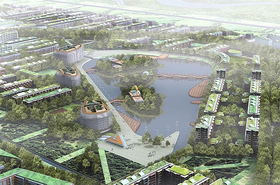
The unbuilt eco-city of Dongtan (China) by engineering firm ARUP, originally included housing for 500.000 residents.
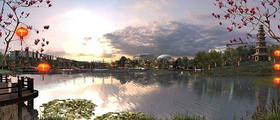
Dongtan earned ARUP the Ethical Corporation Magazine’s "Greenwasher of the Year" award for 2009.
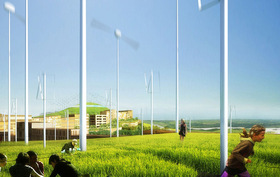 Logrono Eco-City
Logrono Eco-CityMVRDV’s Logrono Montecorvo Eco-City (Spain) is a daring carbon-neutral development.
Join us at an upcoming lecture evening on eco-cities organized by the International New Town Institute in Almere, The Netherlands. The lecture evening is scheduled for November 9, 2009 and will take place in Almere at the Schouwburg Theater. The evening will deal with the current generation of eco-cities.
The point of the evening is to establish lessons for designers, planners, ecologists working on sustainability issues in the urban environment,. We aim to focus not on the small scale of architecture and housing, but on sustainability and ecology at the large scale of urban planning. This approach is fuelled by the ambition of New Town Almere to use C2C and sustainable principles for the future ‘Schaalsprong’, the large extension Almere is undertaking. Can Almere and other Dutch cities learn from other experiences and other eco-cities, such as Masdar City?
Most definitions of “sustainability” connect the dots between society, economy and the environment. The complex interdependencies of these aspects are obvious. During this evening, the speakers will examine the objectives and realities of Eco-cities by examining their internal and external systems. How do truly sustainable cities deal with issues of energy, waste, transportation and social interaction? What are the qualities and challenges specific to Eco-cities? What are the relationships between Eco-cities and their surrounding contexts? With this lecture evening, INTI hopes to add depth to the current debate around sustainability, and offer alternative strategies for future Eco-New Towns. It is our hope that the presentations and discussion will reveal the challenges and opportunities that arise when one attempts to provide a sustainable habitat at the urban scale.
Confirmed speakers include Winy Maas (MVRDV, The Why? Factory), Brian Clegg (author of Ecologic: The Truth and Lies of Green Economies), Peter Mensinga (ARUP, AARDLAB), and Gideon Amos, (Chief Executive of the British Town and Country Planning Association - TCPA). The event will be moderated by Bert van Meggelen and introduced by Michelle Provoost (director INTI).
Time: 7pm-10pm November 9, 2009
Location: Schouwburg Theater, Esplanade 10, 1315 TA Almere, NL
Entrance: €7.50
Language: English
Speaker Biographies:
Winy Maas: The work of MVRDV/Maas has been exhibited internationally, received numerous awards and published widely. In 2009, Maas received the AIA Honorary Fellowship for "being one of the most influential architects of his generation". Winy Maas teaches and lectures at various institutions, and takes part in international juries; he teaches Architectural Design at the MIT as well as Architecture and Urban Design at the Technical University, Delft. Maas founded, in 2008, and directs the research institute for the future, The Why? Factory, connected to the Delft School of Design. Maas is also a widely published author.
Brian Clegg: Brian Clegg read Natural Sciences at Cambridge, specializing in experimental physics, and went on to study Operational Research at Lancaster University before taking up a position at British Airways. In 1994 he launched a new career providing creativity consultancy to corporations and writing for magazines and books. He is a fellow of Royal Society of Arts and edits the www.popularscience.co.uk website. Brian has written nine popular science books, including Ecologic; the truth and lies of green economics (2009), which won the 2009 IVCA Clarion Award for books, for best practice in communicating the importance of CSR, sustainable development, social inclusion and ethical debate.
Peter Mensinga: Peter Mensinga is the Senior Sustainability Designer at the Amsterdam ARUP office. Mensinga joined ARUP in 2006, after graduating in Mechanical Engineering and Technology Management from the Technical University Eindhoven and studying Architecture at the Academy of Architecture and Urban Design in Rotterdam. He is a multi-disciplinary engineer with particular interest in the interface between building, engineering and architecture. Mensinga has worked as an engineer for 15 years with a focus on sustainability and environmental issues, and has been involved in architectural design for 4 years. Some recent projects include work on the Schaalsprong Almere and Tianjin Eco-city, China, as well as Logroño Eco-city, Spain. Mensinga is also the Director of AardLab.
Gideon Amos: BA Dip.Arch(Oxford) DipUD MA RIBA MRTPI FRSA
Gideon is Chief Executive of the Town and Country Planning Association. A qualified urban designer and a chartered architect, he came to the TCPA in 2000, after four years as Director of Planning Aid for London. At the TCPA he co-authored “A Programme for Sustainable Communities” and edited the report “Connecting England – A Framework for Regional Development”. He is a member of the Planning Sounding Board at the Department for Communities and Local Government and a member of the Government’s 2016 Taskforce to achieve zero carbon homes. He is also a Fellow of the RSA, and in his spare time he a non-executive Board member of Swan Housing Association. In December 2008 Gideon received an OBE (Officer of the British Empire) for services to sustainable development.
Introduction:
Michelle Provoost is a partner in Crimson Architectural Historians, Rotterdam. With Crimson she engaged in a large number of research and design projects in the field of urban planning, architecture and art from 1994 on. From 1999-2007 Michelle Provoost has been a staff member and project leader of WiMBY!, an urban regeneration project in the New Town Rotterdam-Hoogvliet. In 2003 she wrote her PhD. publication on the Dutch modernist architect Hugh Maaskant: Hugh Maaskant, Architect of Progress.
Michelle Provoost is the author and co-author of many publications and articles in national and international magazines. From 2008 on she is the director of INTI (International New Town Institute) in Almere, an international knowledge institute on the history and design of new cities worldwide.
Moderator:
Bert van Meggelen: Bert Van Meggelen has been involved in architectural and urban development culture for the past two decades, including a period as Director at the Academy of Architecture R.A.G. (Rotterdam, Arnhem, Groningen). He was also the Director of Rotterdam Cultural Capital 2001. Van Meggelen is currently the Director of MAAT-werk, an office for urban and cultural programs. MAAT-werk develops concepts for new housing and tourism projects, and also supports urban transformation processes with cultural and artistic strategies. Van Meggelen studied Sociology in Rotterdam, and History, specialising in „the Sociology of Housing and Living“ in Utrecht. Between 1980 and 1998 he taught Architecture, and from 1988 to 1998 he served as Vice-Chancellor at the Academy for Architecture in Rotterdam.
For more information or to make reservations, send an email to info@newtowninstitute.org or call us at +31 (0) 36 534 4070.
Reservations are required for this event. For more information or to make reservations, send an email to info@newtowninstitute.org or call us at +31 (0) 36 534 4070.
Dinner is available before the event (at your own cost) at the Cafe Restaurant Waterfront, also located in the Schouwburg. For reservations, please call +31 036 84 55555.
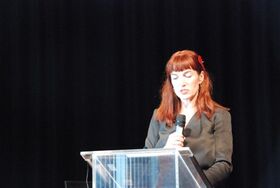
Michelle Provoost gives the introduction to the conference at the Schouwburg Almere.
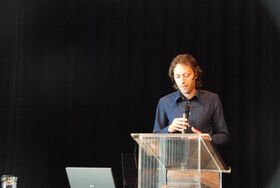
Joris van Casteren describes how Lelystad—a New Town in the Netherlands—reacted to his autobiographical book about growing up as a young vandal in the city.
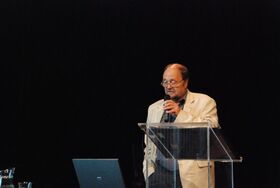
Wolfgang Kil gives a lecture on the normalisation of planned communities.
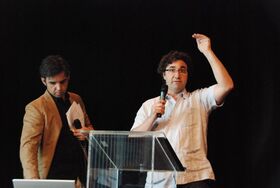
Urban Think Tank (Hubert Klumpner and Alfredo Brillembourg) present their research on "Rules and Strategies of the Informal City."
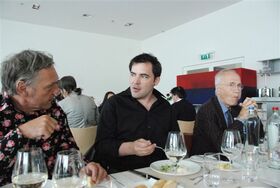
Filmmaker Jord den Hollander and architect Sam Jacob (FAT Architects) prepare for the lecture evening over dinner.
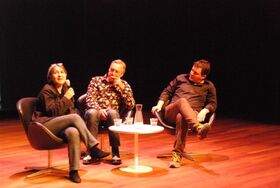
Anne Lacaton, Jord den Hollander and Sam Jacob discuss the issues of adaptation and flexibility in the New Town during the lecture evening Who’s Afraid of Planning?
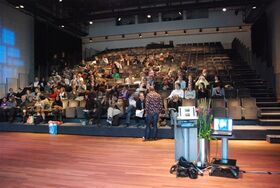
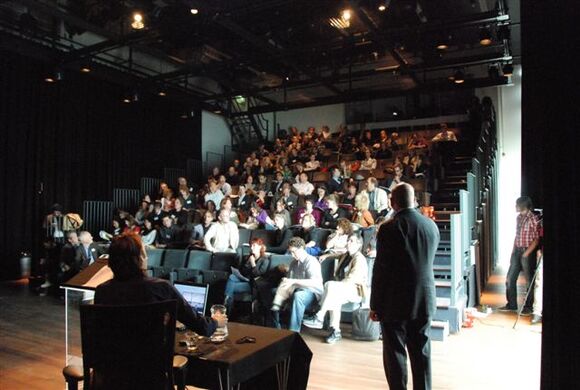
The conference on the Planned vs. the Unplanned City took place in Almere on June 4th and 5th. The two day event included lectures on many topics related to the subject of the planned and unplanned, including presentations by Urban Think Tank (Venezuela/USA), Claudio Acioly (Kenya/Brazil) and Anne Lacaton (France). Some of the presentations were more controversial than others, and the audience was always eager to debate the speakers during the discussions.
Many thanks to everyone who took part in this conference, and we look forward to seeing your next year!
Check back soon for individual reviews of the lectures and discussions.
Katharina Hagg’s review of the INTI conference “New Towns for the 21st century – the Planned versus the Unplanned City” was published on Archined.nl in July. Click here for the full review.
For Hans Teerds’ review of our lecture evening with Anne Lacaton, Jord den Hollander and Sam Jacobs, click here.
Crimson Architectural Historians will be subcurating the 4th International Architecture Biennale in Rotterdam, the Netherlands. The 4th IABR is being held at various locations in Rotterdam and Amsterdam. The Netherlands Architecture Institute (NAI) is the main venue, the heart of the biennale. The VPRO program will be presented on radio, television, and internet as well as in the NAI.
As subcurators of the theme "The Make-able City (Rotterdam: De Maakbare Stad)" Crimson Architectural Historians will offer a diptych consisting of a polemical exhibition showing the travails of the Open City in Rotterdam and the shifting positions of the architectural profession, and a pro-active project involving architects in coalitions with local stakeholders to (re)develop a number of urgent sites and programs in the city of Rotterdam. Informed by the complexity of Rotterdam as a collage of Open City types, we hope to create some facts on the ground, that will show the relevance of architectural and planning practices for the social, economic and cultural development of the City.
Click here for more information on the International Architecture Biennale Rotterdam.
Ekim Tan, INTI researcher and PhD candidate, will be lecturing on the responsive city at the INURA Conference 2009 in Istanbul.
The realms of both political and civil society are becoming space for struggle between the old and new accumulation regime, or small and corporate capital. Istanbul, through business as usual, is obviously on a secure track to create its new, more sustainable models and spheres of inequalities. Where is the space for intervention? How can Inura help to link with past and present lessons learned from other metropolises? How can the particular Istanbulite story help to understand processes going on elsewhere? … are among the other questions, which the 19th Inura Conference to be held between 26th June/3rd July in Istanbul will focus on.
Click here for more information.
Working on cities is a student initiative which has grown to a collaboration of the Rotterdam Academy of Architecture and Urban Design (AvBR) and the Institute of Housing and Urban Development Studies (IHS), which is affiliated with the Erasmus University Rotterdam, the Netherlands. The objective of WOC is to combine design, planning and research in order to come to broad and integral solutions for urban challenges - Working on Cities.
Ekim Tan will be a visiting critic for WOC in August 2009. For more information on these events click here.
The International New Town Institute will be contributing to the exhibition Parallel Cases (curated by Ralf Pasel) at the 4th International Architecture Biennale in Rotterdam between September 24, 2009 and January 10, 2010. Our two contributions are done in tandem with researchers from the TU Delft.
Responsive City Game
Delft University of Technology and International New Towns Institute (NL)
Sportpark de Wierden is currently planned as a new expansion for Almere Haven, the 30 year old new town of the Netherlands. Biggest ambition of the municipality is to develop the area in an organic fashion. The Responsive City game was designed as an alternative to traditional participation models. Game agents organized a city without preset rules, based on their individual visions. Negotiations took place all along the game ensuring a collective order for the new city.
Eurasian Informality
Delft University of Technology and International New Towns Institute (NL)
Turkey is at the doorstep of the EU and Istanbul is waiting to be crowned the Cultural Capital of Europe in 2010. New adaptation laws are passing through the parliament, and the future capital of culture needs to be cleaned up from the "embarrassing" informality. Gulensu, a 30 year ’gecekondu’ (informal city) with 50.000 inhabitants is confronted with topdown modernist transformation plans of the city. While residents resist to the city’s plans, they form collaborations with academics and NGOs to prepare their city for the changing socio-economic conditions.
For more information on the IABR click here.
The Biennale is located at the NAi (Netherlands Architecture Institute) which is at Museumpark 25 3015 CB Rotterdam. Opening times are Tuesday - Saturday: 10.00 - 17.00 and Sunday 11.00 - 17.00.
On September 16th, the International New Town Institute will address the case of cultural programs in New Towns such as Almere. Professor Arnold Reijndorp will be among the lecturers. He will look into detailed aspects such as: How does a public emerge in a new city? How does an urban cultural program develop? What are the relationships between investments in cultural hardware (theatres, cinema and museum) and the cultural software (public)?
Almere is a New Town, a young city that has grown over the last thirty years to an impressive size of 180.000 inhabitants. As such a new city, Almere stands out from the other ‘historic’ cities that are participating in the SICA/EUNIC-program. While in other cities urban culture has evolved over centuries, in Almere the interaction between cultural institutions, supporting groups and the general public is still fresh and undergoing constant development. Because Almere is set to become the 5th largest city in the Netherlands, the city has decided to develop its cultural profile and quality according to this projected growth. The main questions at hand are related to similar ones in other cities that deal with topics related to innovation and creativity. But Almere also has very unique goals and problems; most of them are related to the relative youthfulness of the city and the fact that most of the inhabitants were not born in Almere, but have migrated there by choice.
Adri Duivesteijn, alderman of Almere, will handle more quantifiable questions such as: In what way does the expected growth and development of the city influence the cultural task at hand? What cultural opportunities does the excepted growth bring about?
Two lecturers from abroad will be invited to explore the relation between New Town-developments and culture. How do other New Towns deal with their cultural program and goals? What options, expectations and developments exist? How can culture be stimulated in the context of a New Town, if at all?
This event is free and will begin at 14:00 at the Schouwburg Almere, Esplanade 10, 1315 TA Almere, NL.
To register, please send an email to post@sica.nl
For more information, click here.
This event will be in Dutch.
From the 24th of September until the 27th, TU Delft hosted the Complexity Theories of Cities conference. The conference was organized by U-Lab - Laboratory for Cities and Urban Landscapes - and presented the research of eighteen speakers in this field, including INTI researcher Ekim Tan.
“Three decades of research have established the field of complexity theories of cities as a dominant approach to cities. Now that the field has come of age, it is time to stop for a moment, look back at what has been achieved, with appreciation, but also with sober criticism and then look forward at potentials that have yet to be realized. As for potentials yet to be realized, this conference will explore the implications of complexity theories of cities to planning and urban design. As examples to what we have in mind consider, firstly, Mike Batty’s (2008) recent observation that “In the past 25 years, our understanding of cities has slowly begun to reflect Jacobs’s message. Cities are no longer regarded as being disordered systems. Beneath the apparent chaos and diversity of physical form, there is strong order …”. Secondly, Portugali’s (2008) criticism that “in their search for statistical data to feed their models practitioners of USM tend to overlook the non-quantifiable urban phenomena” and as a consequence, some of the central questions of 21st Century cities and urbanism”. As for potentials yet to be realized we would like to emphasis in this workshop the implications of CTC to planning and urban design.”
The conference was attended by INTI Director Michelle Provoost, who also took part in a round table discussion on the applications of complexity theory and urban simulation models. The Almere Schaalsprong project was introduced by Dr. Provoost and Schaalsprong Director Henk Meijer.
The experts present at the conference advised INTI and the Municipality of Almere on ways to move foreward with the Schaalsprong.
For more information on this event click here.
This autumn, the International New Town Institute will organize the masterclass ‘The New City’. Participants will include 15 employees from the Municipality of Almere, with various professional backgrounds. This diverse group of people will gain insights in themes such as Diversity, Sustainability and Economics. The group will visit the British New Town Milton Keynes and during their final gathering they will discuss their ideas during the debate game ‘The Making of’.
This Masterclass is intended to provide the group from the Municipality of Almere with an opportunity to enhance the quality of their work with direction from a group of relevant experts.
INTI intends to organize various other Masterclasses with a focus on different new towns in the future. For more information, please contact Marit Geluk at m.geluk@newtowninstitute.org.
A conversation on the capacity of large-scale urban extensions and new towns to sustainably accommodate coexistence between Michelle Provoost, partner, Crimson Architectural Historians, Rotterdam; and Lars Lerup, William Ward Watkin Professor of Architecture, Rice University, Houston.
This event took place from 19:00 to 21:00 on 7 October at the Berlage Institute, Botersloot 25, 3011 HE Rotterdam, T. 010-4030399
Click here to watch a video of the conversation.
On Wednesday, November 25 2009, INTI Director Michelle Provoost and Coordinator Marit Geluk will travel with a group of participants from the Gemeente Almere to the English new town Milton Keynes. The excursion is part of The New City Masterclass and will give the particpants the chance to learn about this exemplary new town first hand.
Milton Keynes is one of the most famous new towns from the UK goverment’s wave of building in the 1960s. It was constructed to relieve housing pressure on London and was puposefully situated was equidistant from London, Birmingham, Leicester, Oxford and Cambridge with the deliberate intention that it would be self-sustaining and eventually become a major regional centre in its own right.
Today Milton Keynes is regarded as one of the most successful new towns of its generation, with a strong focus on public art, cultural facilities, and well-connected public transport.
The INTI delegation will meet with the Milton Keynes Discovery Centre to look at the city’s existing situation and discuss future plans for expansion.
The lecture evening on eco-cities featured speakers Winy Maas, Brian Clegg, Gideon Amos and Peter Mensinga. They delivered their ideas about eco-cities from very diverse backgrounds. The audience of 150 was treated to four rousing lectures and a roundtable discussion with Almere Schaalsprong director Henk Meijer and INTI director Michelle Provoost—all smoothly moderated by Bert van Meggelen.
Winy Maas started the night with a plea for skepticism without negativity when considering the role of sustainability in our lives. He moved through some ideas and critiques from the upcoming T?F publication The Green Dream and on to MVRDV’s current project in Spain: Logrono Montecorvo Eco City.
Brian Clegg reminded us that a bit of recycling is not enough to tackle the problems of global warming, and helped clarify the differences between truly sustainable practice and greenwash. The audience was reminded to examine their actions rationally and resist the feel-good emotions of advertising words like "green" and "natural".
Gideon Amos brought a planning perspective to the evening and discussed TCPA’s role in establishing guidelines for sustainable practice in the British eco-towns.
Peter Mensinga wrapped things up with a look at different ARUP eco-city projects, including Dongtan, Tianjin and Masdar City. He closed with an examination of different sustainable ways forward for Almere Schaalsprong.
We were extremely pleased with the large turnout and the fascinating content. We are already looking forward to our next lecture evening!
Click here for video of the lecture evening.
The forthcoming book ’SHANGHAI NEW TOWNS - searching for community and identity in a sprawling metropolis’ documents and critically analyzes a number of recent New Towns in the urbanizing region around Shanghai. Most of those New Towns are partly based on western models. A decade ago, a selection of western architects and urban planners was invited to participate in design competitions for thematic core areas. The proposed designs were then translated into a Chinese context and partly realized. They make part of a bigger vision and planning strategy for one of the fastest urbanizing metropolitan regions on earth.
This book is also a coproduction of Chinese and western writers and photographers. It will be presented during the World Expo 2010 in Shanghai, from May 1 to October 31 with the promising theme ’Better City, Better Life’. This topic relates to the moment when almost half of China’s population is living in urban environments. In the coming years many more millions of people are expected to leave the rural areas. In the urgent need to give shelter to all these new citizens, new models are needed for mass accommodation.
Shanghai wants to be a model city, and promises, according to the municipality, to show how the city of the future should be shaped. This cosmopolitan port city is the most important ’bridge’ between China and the rest of the world since the late nineteenth century. It holds an exciting mix of oriental and western architectural styles. After the opium wars, different foreign concessions arose that are still recognizable within the urban fabric. Shanghai is a cosmopolitan mix of east and west, tradition and futurism, rich and poor. As a result of the economic boom many are attracted to this ’New York of the twenty-first century’ to try their luck.
To alleviate the city from the enormous pressure and also to bring benefits to the immediate surroundings of the city, the board of the city province implemented a new strategy in the eighties, based on a shift from the central city model to a poly-nuclear model. With this measure, the municipality wanted to alleviate the enormous pressure on the central city and prevent the countryside from experiencing urban sprawl and also allow the immediate surrounding countryside to benefit from economic growth. Since the end of last century this strategy made several shifts, due to changing policies. This resulted in a fascinating palette of finished and unfinished new towns, villages and satellites.
Probably the most striking example is the ’One City, Nine Towns’ plan, which was started in the year 2001. This "One City, Nine Towns" model displays a preference for Western culture, architecture and urbanism. As a response to the lack of identity that many New Towns are facing, this plan consists of a new medium-sized city (Song Jiang) and nine compact key cities, each one with a thematic blend as core. In consultation with architects and urban developers from represented countries, a Spanish Town, an Italian Town, a German Town, a Dutch Town, a Scandinavian Town, a North American town and a British Town have since been realized. These thematic cores are intended to be germs and become cities of several hundred thousand inhabitants each. The thematic sections are relatively small and include ’only’ a few tens of thousands of houses, designed as a sort of billboard. The rest of the cities are conventionally built up around it in the usual Chinese styles, at breakneck pace. A new modern, a new traditional Chinese town and a new Harbor town are also under construction. A planned ecological town has unhappily been cancelled.
The big question is how this decentralized planning model works out in Shanghai, what is learned from foreign examples and what can be learned from Shanghai? Analogous to the import of classical forms during the Golden Age in the Netherlands, Shanghai is importing postmodern architectural language on a large scale. The big question is why Shanghai, in this post-colonial era, is chosen for the voluntary import of Western urban models and architectural forms. What does this convey to the city? These new ’Chinese’ towns and cities show many common problems, as we know in the western world, such as social segregation, discontinuity of the cityscape and the lack of useful public spaces. The Shanghai model is searching for a balance between government-driven and market-driven urban development.
The economic and political landscape has changed rapidly. Today semi-private developers are involved in the design and implementation. Many Chinese developers appear to have little knowledge of project development. There is a lack of research, so the built houses often don’t match the demand. The extent to which the government is steering is sometimes also unclear. Because of the lacking implementation of public transport and even more because of speculation reasons, many houses, shops and offices remain empty. Some are already in decay and look like ghost towns. Others are very alive and pleasant.
The different conditions and different approaches of each new development result in an interesting palette that shows what can go wrong and what can become a success. Why does the one function better than the other? These new tows form an exciting new laboratory where very different influences are melted into a new reality.
Acknowledgements:
’SHANGHAI NEW TOWNS - searching for community and identity in a sprawling metropolis’ will be produced in close cooperation with The International New Town Institute (INTI), Delft University, Faculty of Architecture and Urbanism, FAR Architecture Center Shanghai, The Netherlands Foundation for Visual Arts, Design and Architecture, The Netherlands Architecture Fund, etc.
The book is assembled and edited by Harry den Hartog (Urban Language)
The Chongming research studio is an initiative from the Rotterdam Academy of Architecture (RAVB) and the International Institute of urban management (IHS-Erasmus University) and will be organized in collaboration with the International New Town Institute Almere (INTI) and Tongji University Shanghai. The aim of this multi-disciplinary research studio is to get a better understanding of contemporary Chinese urbanization processes and more specific to develop different scenarios for the future transformation of the rural island Chongming (Shanghai), while being aware of the bigger questions of the (Chinese) urbanization pressure on this rural landscape, the transformation of production landscapes and the contemporary discussion on ecological urbanism.
CONTEXT:
Chongming is a large fluvial island situated in the Yangtze River north of Shanghai. The island has a predominately agricultural land-use and is even mentioned as the ‘granary’ of Shanghai. Recently the rapidly expanding metropolis of Shanghai and new infrastructural connections have brought a radical and undeniable pressure to the island and make Chongming one of the next potential targets of Shanghai’s expansion thrift. Against the backdrop of the Shanghai World Expo 2010 entitled “Better Cities Better Life”, a research-study to the future development of Chongming will be very actual. Previous studies done by international architectural firms SOM and ARUP gave Chongming international fame and presented the island as the location of the first sustainable eco-city in China: Dongtan.. Until today however these proposals have not been implemented and most of this attention has since been lost.
STRUCTURE OF THE SEMESTER:
The studio aims to work as a research-lab that explores different development strategies for the island. Participating students from the RAVB / IHS will be divided into 3 groups of each 10 students. Every group will develop a different hypothetical model for the future transformation of Chongming Island. For this research we distinguish between 3 different development models:
– Urban development model
– Agricultural development Model
– Ecological development model
Beside these collective design projects the students will work on individual research theses which will support the designs and give specific insight in the characteristics, backgrounds, qualities and problems of the three different development scenarios.
COLLABORATION:
The collaboration between the RAVB, IHS, INTI and Shanghai Tongji University will hopefully lead to an intensification and elaboration of the proposed research study. Due to the mutual exchange of knowledge and expertise in the fields of architecture, urbanism and urban management we expect to be able to present a broadly based research-study that provides new insights into the complex conditions of contemporary Chinese urbanism.
SCHEDULE:
The Chongming studio will start in February 2010 and will end with public presentations in June 2010. In week 3 of the studio (26Feb-6March) a workshop week will be organized in Shanghai where students from the RAVB in collaboration with students and staff from Shanghai Tongji University will explore the characteristics of contemporary Chinese urbanization. In this intensive fieldwork week the students will have to define a framework for their design proposal and collect material for their individual thesis projects.
The exhibition from the IABR (International Architecture Biennale Rotterdam) Projects for the Open City will be travelling to Paris to take part in the exhibition Eurasian Informality.
INTI researcher Ekim Tan will be presenting her pavilion on The Responsive City, A Future Vision for Gulensu; an informal settlement in the Asian Wing of Istanbul.
The Exhibition
The exhibition, Projects for the Open City, will take place in the École Nationale Supérieur d’Architecture de Paris-Malaquais. The exhibition, curated by Ralf Pasel, features an inspiring selection of projects of the 4th International Architecture Biennale Rotterdam (IABR), Open City: Designing Coexistence.
Projects for the Open City displays an extract of projects originating from different universities all around the world, rendering a unique cross-section on how the Open City is perceived and discussed globally. Compared to so-called "best practice" projects the selection shows how Open City conditions are discovered and designed in an academic context, enhancing the situation of urban living and mutual coexistence.
Whilst some of the displayed projects refer directly to the Open City as such, others strive to overcome the closed character of an urban existence, relating to issues like Squat, Refuge, Diaspora, Community, or Collective.
However manifold and divers the projects, Projects for the Open City provides an astonishing collection in drawings, film, models and text on urban societies. It explores how coexistence can be designed and establishes links to specific urban contextualities.
Projects for the Open City allows a glance into the future of our cities, triggering curiosity in which direction urban life may develop over the generations to come.
All exhibited projects were originally produced for the Parallel Cases exhibition, a co-production of the International Architecture Biennale Rotterdam (IABR), the Rotterdam Academy for Architecture and Urban Design (RAvB) and the Institute for Housing and Urban Development Studies of Erasmus University Rotterdam (IHS).
Parallel Cases Paris was kindly supported by the IABR, pasel.künzel architects, Rotterdam and the Working on Cities Programme - WOC
Projects for the Open City
11 January - 12 February 2010
École Nationale Supérieur d’Architecture de Paris-Malaquais
1, Rue Jacques Callot
75006 Paris - France
For more information see:
www.ravb.nl, www.ihs.nl, www.paselkuenzel.com, www.workingoncities.com
The International New Town Institute organized the masterclass ‘The New City’ for civil servants working at the Municipality of Almere. This masterclass allowed professionals with various backgrounds to gain insights into themes connected to the development of Almere New Town, and to discuss themes such as Diversity, Sustainability and Economics.
Various speakers and scientists such as Ronald Wall, Simon Franke and Olaf van der Wal shared their insights on relevant topics with the group, under the guidance of moderator Arnold Reijndorp. The group visited the British New Town Milton Keynes and during their final gathering they discussed their ideas for the future of Almere during the debate game ‘The Making of’, developed by artist Hans Venhuizen.
The final presentations of the participants will mark the end of the masterclass de Nieuwe Stad, providing an opportunity to exchange ideas and lessons. Burgermeester Annemarie Jorritsma-Lebbink (VVD) will be present to discuss the proposals of the participants and the success of the masterclass with the group.
INTI intends to organize various other Masterclasses for civil servants in the future, with a focus on different new towns in the Netherlands. Each Masterclass provides the participants with an opportunity to enhance the quality of their work by learning from a group of relevant experts. For more information, or if you would like INTI to organize a masterclass to your specific wishes, please contact Ms. Marit Geluk at m.geluk@newtowninstitute.org.
The International New Town Institute (INTI) is pleased to invite its extended network to the New Town excursion to Shanghai and the World Expo in May 2010. The theme of the World Expo is ‘Better City, Better Life’—a well known and recognizable ambition of many New Towns. The impetus for New Towns is almost universally a dose of optimism and the drive for innovation. New Towns can also be seen as a controlling device in the world’s ongoing urbanisation. At this moment in history, the majority of the world’s population is living in cities, and a new wave of New Towns is quickly spreading across the Asian continent.
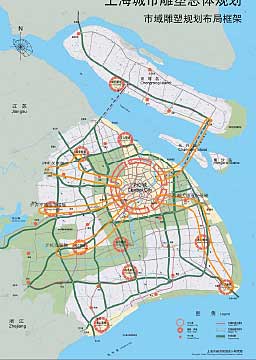
Since 2001, Shanghai has been host to a set of 10 satellite New Towns. These towns represent both confidence in an urban future, and the government’s desire to control Shanghai’s growth. The International New Town Institute is organizing excursions to these contemporary New Towns. The delegation will attend INTI’s dinner conference ‘New Towns for the 21st Century, from Almere to Qing Pu’ at the Holland Pavilion ‘Happystreet’. A Chinese delegation of local officials, researchers and designers will be invited for this evening. During the event the publication ‘Shanghai New Cities - searching for community and identity in a sprawling metropolis’ will be launched.
The delegation will consist of researchers, university representatives, local authorities of Dutch New Towns, urban designers, journalists, other authorities and (international) organizations in the field of New Towns.
This excursion is an initiative of INTI and a cooperation between INTI, the municipality of Almere and the Province of Flevoland, who is sponsor of the Holland Pavilion. ‘Urban Language’ is our foreign correspondent and local travel guide.
Preliminary program
| May 12 Wednesday | Departure Schiphol Amsterdam. |
|---|---|
| May 13 Thursday | Arrival Shanghai, transfer to hotel. |
| May 14 Friday | Visit World Expo.
17h00-21h00 INTI dinner conference ‘New Towns for the 21st Century, from Almere to Qing Pu’. Opening by mr Leen Verbeek, provincial governor Flevoland. Lectures by Michelle Provoost, Arnold Reijndorp and representatives of municipality of Almere and Tongji University. Book presentation ‘Shanghai New Cities - searching for community and identity in a sprawling metropolis’ (Harry den Hartog, ed.) at Holland Pavilion (VIP room ‘The Crown’). |
| May15 Saturday | Visit World Expo. |
| May 16 Sunday | Excursion to New Towns of Shanghai: city tour Songjiang University Town & Thames Town, visit Qingpu New Town & Zhujiajiao, including waterside dinner and canal cruise. |
| May 17 Monday | Excursion to New Towns of Shanghai: city tour Anting (German) New Town, Luodian (Scandinavian) New Town & Gaoqiao (Dutch Town), visit planning museum, walking tours and business meeting with local officials and planner, diner on special location. |
| May 18 Tuesday | Shanghai. |
| May 19 Wednesday | Free time in Shanghai & farewell party. |
| May 20 Thursday | Transfer to Shanghai Pudong Airport, departure. Arrival Schiphol Amsterdam. |
Price indication € 2.250,- including flight Amsterdam-Shanghai-Amsterdam, transfers, hotels, access World Expo, excursions, some dinners and lunches. Excl. visa.
Interested? Please send your application before April 1, 2010 to info@newtowninstitute.org
See INTI website for list of applicants.
More info:
www.newtowninstitute.org
www.happystreet.nl
www.archined.nl
In early March 2010, INTI will be presenting the book "New Towns for the 21st Century: The Planned vs. the Unplanned City". This publication is the result of the 2009 conference of the same title. INTI is very pleased to add "The Planned vs. the Unplanned" to our growing series of books on New Towns.
Chilean architect Alejandro Aravena has also been invited to give a lecture during the evening. Aravena is well known for the work of his office Elemental, based in Santiago. The housing project Quinta Monroy is one of the most widely published social housing solutions, providing a basic concrete block unit with available space for inhabitants to personalize and extend their homes.
Aravena’s work connects planned and unplanned architectural events in surprisingly elegant ways. INTI is very excited to combine our latest book presentation with the lecture of such a relevant architect.
More information on the date and location of the lecture and book presentation will follow shortly.
This publication was made possible by a generous grant from the Stimuleringsfonds voor Architectuur.
On Thursday, February 11 the Go West Project will give a presentation at De Balie in Amsterdam.
In this presentation the founders of the Go West Project will present results from their research on the cities in the Central and Western part of China. China-correspondent Michiel Hulshof and architect Daan Roggeveen will show redevelopment projects in Shijiazhuang, preservation projects in Kunming and the new business district in Wuhan. The evening will end with a panel discussion about several topics: How do these cities develop? Does China build a new type of city? What does the growth of these cities mean for China and the rest of the world?
The panel consists of China watchers, amongst whom Annette Nijs, director Global Initiative of the China Europe International Business School and author of the book ‘China with New Eyes’ and Michelle Provoost, founder of Crimson Architectural Historians and director of the International New Town Institute.
Also on February 11, De Balie will open a photo exhibition about the performance of the Go West Project at the Shenzhen / Hong Kong Architecture Biennale in December, where they asked 6 taxi drivers from 6 different Chinese cities to drive across the country to Shenzhen.
Time : February 11, 2010 at 20.30 pm
Location : De Balie
Address: Kleine Gartmanplantsoen 10, Amsterdam (near Leidseplein)
Admission : Free
The ultimate political act in town planning is the building of a New Town. Governments, developers and planners conspire to create out of nothing a brand new community, based on the latest models of social and economic behavior, and using architecture and urban design as symbolic vehicles for the power of the state to build the perfect environment for its citizens. Or is the idea to build a New Town from scratch just proof of a fatal misunderstanding of what makes a city a city? Is it a sign of a gross ignorance on the part of politicians, planners and all those involved in this process of the complexity and the unpredictabilty of the urban? The specialists have always been capable of accommodating the functions of the city, to house the workers of the new industry, to stop urban sprawl or to colonize the colony, but are they capable of predicting which kind of urban society they are actually building?
Apart from representing the most ideal image that political systems wish to project on society, New Towns have also become one of societies biggest political challenges. Starting from high ideals, their reality is often different, often even disappointing. Many New Towns have not fulfilled the economic task they were built for, the inhabitants have not gelled into the communities hoped for by the planners and architecturally their design has not proven to withstand the test of time. But is this really a problem for anyone but the founding fathers? Isn’t the unforeseen transformation of a planned community not just unavoidable, but even a condition to become truly urban? Shouldn’t we recognize that the planning and building of a New Town is but the first small step in the development of an urban community, and that the real work starts once the politicians and planners have done their job?
Whatever the situation might be, New Towns and Politics are closely related, even condemned to each other. When countries as disparate as China, the United Arab Emirates and Great Britain decide to build dozens, even hundreds of New Towns for the 21st century, politics becomes part of the story. How does the country wish to represent itself as the maker of communities? How do the architects deal with the representation of the very different political systems? Or is this question based on the fallacy of wanting to make a literal connection between politics and planning? Are politics and planning just two ships that pass each other in the night? Do they each have their separate agendas, ideologies and modes of expression; might they temporarily use each other for their separate goals, but are they on different trajectories all together? Could that explain the remarkable sameness of New Towns built in the communist block and the capitalist world, both products of diametrically opposed political ideologies? Does this make planning and architecture apolitical in its core? Or does it show that planning possesses its own political ideology, separate from the other ones?
Even when a country professes not to believe in social engineering anymore, and projects an idea of democratic and participatory urban politics, it will have to deal with the political problems posed by urban areas once built as shining new communities. Do we face the drifting apart of our cities in suburbs for the middle classes, gentrified inner cities and post war New Towns and satellite towns housing the poor immigrants? How can we involve citizens in the ‘rebuilding’ of their communities instead of solving the problems for them? Should we demolish and rebuild, renovate or just let things (d)evolve? Who’s in charge? Politicians, developers, the people, the architect, social institutions?
With the fourth INTI conference, New Towns & Politics, we wish to explore thoughts, analyses, projects, designs and political actions pertaining to the political dimension of New Towns, old and new. We invite researchers, writers, journalists, designers, artists, politicians and developers to send us ideas for papers and projects to be presented and discusses in the autumn of 2010 in a venue to be announced in The Netherlands. Authoritative and provocative keynote speakers will be invited to enliven the event with their presentations and a film program will open up unexpected vistas on the question of New Towns & Politics.
Three questions
We have formulated three main questions to further help along the flow of ideas, projects and papers.
How have political regimes influenced the design methods and outcomes for New Towns in the recent past? In what way have they been designed to represent the political regimes they were the product of? As New Towns are since long designed mostly by globally operating engineering and design forms, what body of knowledge took shape through the parallel engagement with contrasting political contexts? This theme is still very relevant with the latest generation of New Towns taking shape mainly in Asia. Is it so different to work for a totalitarian regime, as opposed to a democratic country? Where does the difference lie and how does it manifest itself? Is the difference moral? Technical? Organizational? Esthetic?
Democracy is widely regarded as the best - or least bad - form of government; at the same time democracy creates a complex and unpredictable context for the realization of long term projects like New Towns, or for the top down solution of urban problems often arising from New Towns. Democracy and large scale urban design and planning often seem at odds with each other. Are there forms or methods of planning and design that are democratic in themselves, that are tools for the community to help itself, or even to build itself? Is there an implicit conflict between planning and democracy?
Many New Towns, once build for the middle classes, especially in the western countries of Europe and the US face the influx of new groups, housing the poor and the immigrant part of the urban population. Does this explain the correlation between above average electoral results for anti-immigrations political parties in some of these New Towns? How should we judge these demographic processes: ghetto-ization as a result of a policy of gentrification of the inner city areas or - to the contrary - part of integrative and emancipatory processes based on the social ambitions of these groups? To what extent are social changes connected to problems of safety and criminality? How is this matter being dealt with in different countries and by different regimes? Which policies have been developed for and against it? Should we fear segregation or should we be more sensitive to the positive aspects of it? Are New Towns maybe the laboratories where new communities are arising, celebrating their differences, without frustrations about their separateness? Is the idea of a city as a collection of communities a viable option for their future development?
ABSTRACT FORMAT GUIDELINES
Please send your abstracts in English before June 1st 2010 to info@newtowninstitute.org.
The abstract submission should be on two pages, one page of text (max. 200 words) and one page of figures/images.
Don’t forget:
– Name, mailing address, phone, and e-mail of the author(s);
– CV and affiliation of the author(s)
– Explanation of the relation between abstract and the themes of the congress.
Please send your abstracts in English before June 1st 2010 to info@newtowninstitute.org.
The abstract submission should be on two pages, one page of text (max. 200 words) and one page of figures/images.
Urban China is booming…..but still without any real vision. Now the green city is on the agenda across the nation this must change. The project Caofeidian–Genetic City is China’s most ambitious response to the triple-challenge of explosive growth, environmental pressure, and healthy human desires for the future.
On Sunday the forum GREEN FROM SCRATCH will be held. A panel of 30 renowned speakers who will rotate in ongoing discussion on the future of green cities in China. Key topics: Defining green living, evolutionary planning and reshaping regulations to allow sustainability to take root. Reserved seats are available on request, Sunday 15/8, 9.45-18.00, Theater, Dutch Culture Centre.
click http://burb.tv/view/B.A.R.C._-_Greening_the_Metropolis for more info.
Wouter Vanstiphout, research advisor at the International New Town Institute, will be officially inaugurated as professor at the Delft University of Technology, the Netherlands on June 9, 2010.
In his inauguration speech he will address the relationship between the immaterial world of politics and the . The speech(in Dutch)is open to anybody who is interested: June 9th, 15:00, Aula TU Delft.
Click here for more info.
The ultimate political act in town planning is the building of a New Town. Governments, developers and planners conspire to create a brand new community on a tabula rasa, based on the latest models of social and economic behavior.
Or is the idea to build a New Town from scratch just proof of a fatal misunderstanding of what makes a city a city? Is it a sign of a gross ignorance on the part of politicians, planners and all those involved in this process of the complexity and the unpredictability of the urban?
Whatever the situation might be, New Towns and Politics are closely related, even condemned to each other.
With the fourth INTI conference, New Towns & Politics, we wish to explore thoughts, analyses, projects, designs and political actions pertaining to the political dimension of New Towns, old and new. Authoritative and provocative speakers as Sociologist Kenny Cupers (Buffalo NY), architects Zvi Efrat (Tel Aviv), Nathalie de Vries (MVRDV), Kees Christiaanse (KCAP) en Tobias Armborst (New York), architecture journalist Kieran Long (Londen), researcher Azadeh Mashayekhi (Tehran) en Aldermen Adri Duivesteijn (Almere) and many more will enliven the event with their presentations and a film program will open up unexpected vistas on the question of New Towns & Politics.
The Conference Reader is now online!
The videos of the conference are now online!
Read the review by Archined here!
Read the review by Ruimtevolk here!
PROGRAM
Thursday 11 november 2010, Library Almere
| 09.00-09.30 | Doors open & Coffee |
| 09.30-10.15 | Introduction
-René Peeters : Opening conference -Michelle Provoost :Introduction INTI |
| 10.15-11.45 | Theme 1: Participation and Community Power (moderator Wouter Vanstiphout)
-Tobias Armborst : The Dream of a Lifestyle: Marketing Master Planned Communities in America -Kenny Cupers : Cities in search of the user |
| 11.45-12.45 | Theme 2: The Architect and the Process -JaapJan Berg interviews Kees Christiaanse (KCAP) and Nathalie de Vries (MVRDV) on the role of the Architect in the development of New Towns in Russia and Asia |
| 13.00-14.30 | Lunch |
| 14.30-17.00 | Theme 3: New Towns as Political Instrument (moderator Wouter Vanstiphout) -Zvi Efrat : New Towns in Israel -Azadeh Mashayekhi : Revisiting Iranian New Towns -Dan Handel : Grid and Revelation: Cities of Zion in the American West -Vincent Lacovara : Specific Flexibility in Place-making - or - The Law of Unforseen Planning |
| 17.00-18.00 | Drinks |
| 18.30-21.00 | Dinner |
Friday 12 November 2010, Theatre Almere
| 09.00-09.30 | Doors open & Coffee |
| 09.30-09.40 | Introduction
-Michelle Provoost |
| 09.40-11.15 | Theme 4: Left and Right in Urban Planning (moderator Wouter Vanstiphout) -Jacqueline Tellinga : On Politics, Building and Almere -Kieran Long : Planning for the Big Society -Christian Salewski : Planning and Politics in an open society: scenarios for Almere, Markerwaard and New Netherlands 2050 (1970-1990) |
| 11.15-12.45 | Theme 5: Asia (moderator Michelle Provoost) -Victor Oldiges : Between Gropius and Mao -Laurence Liauw : New Town policies - sameness and differences in Hong Kong and Mainland China -Kyo Suk Lee : Korea: City Building as a Perpetuum Mobile |
| 13.00-14.30 | Filmlunch with Introduction by Jord den Hollander |
| 14.45-16.15 | Theme 6: From Government to Private Sector (moderator JaapJan Berg) -Steven Beunder : New Towns in China and India - government led versus private sector development -Todd Reisz : Modernization of the Arabian Coast -James Kostaras : New Smart Cities of the 21st Century and the end of civic engagement in the modern democracy |
| 16.15-17.30 | Final Remarks |
| 17.30-19.00 | Drinks |
see also:
Review: New Towns & Politics
and video:
Conference New Towns & Politics
Since 2001, Shanghai has been host to a set of 10 satellite New Towns. These towns represent both confidence in an urban future, and the government’s desire to control Shanghai’s growth.
The International New Town Institute has organized an excursion to these contemporary New Towns. The delegation attended INTI’s dinner conference ‘New Towns for the 21st Century, from Almere to Qing Pu’ at the World Expo Holland Pavilion ‘Happystreet’.
A Chinese delegation of local officials, researchers and designers was present for this evening. During the event the publication ‘Shanghai New Cities - searching for community and identity in a sprawling metropolis’ has been launched. The delegation consisted of international researchers, university representatives, local authorities of Dutch New Towns, urban designers, architects and journalists.
Click here for more info and images on our INTI facebook page!
In collaboration with the Dutch-Russian architects office SVESMI,INTI has started to research the possibilities for renewal and to design various solutions to the problems of the housing areas.
Because many cities in the former Soviet Union that were planned as completely new cities usually consist for large parts of prefab panel blocks, INTI is interested in participating in the renewal of the Mikrorayon.
The first part of this research was presented as a short animation movie titled ‘Mikrorayon Tomorrow’ during the Moscow Architecture Biennale, 26th of May - 10th of June 2010. The theme of this Biennale is ‘Modernizing Modernism’.
Click here for more info.
The International New Town Institute (INTI) visited MIPIM 2011 to explore new possibilities for cooperation and to find new friends in the world of real estate and building.
MIPIM is the world’s premier real estate event for professionals and will be held from March 8-11, 2011 in Cannes, France. MIPIM brings together the most influential real estate professionals to explore major international property development projects, connect with potential partners, and strike deals over 4 intensive days.

See also: www.mipim.com
For contact details during MIPIM 2011 and more information please contact:
Mrs. Marit Geluk MSc or
Mr. Paul Kroese MSc.
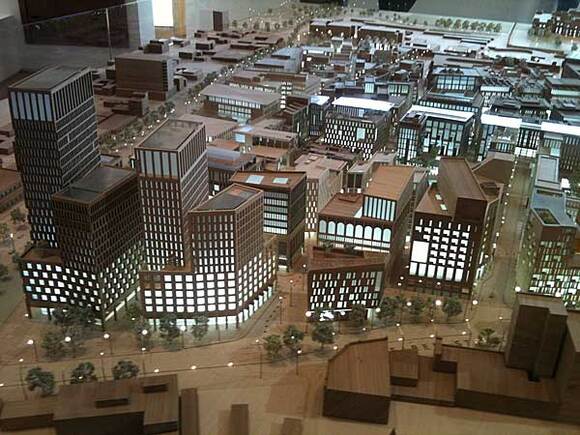
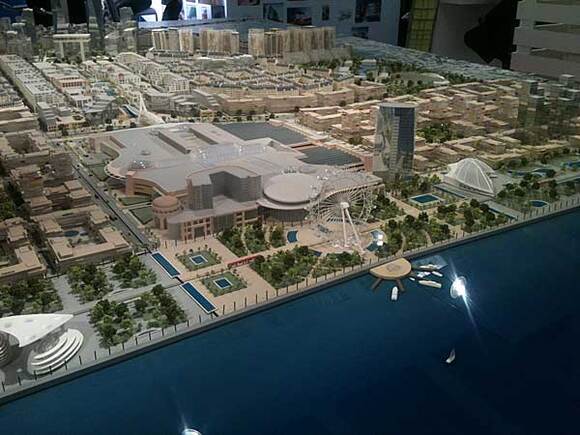
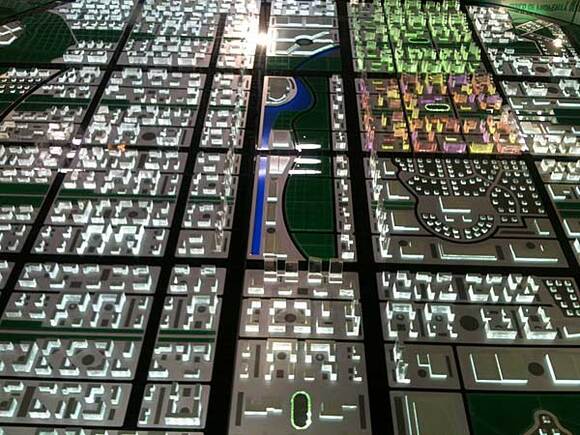
Socialist Poland was a valued brand during the Cold War - at least in certain markets, which included the global market of intellectual labour. This pertains in particular to the labour of architects, planners and engineers from People’s Republic of Poland (PRL) which was widely exported to the countries of the post-colonial South. This exhibition shows the designs of Polish professionals sent by state agencies of foreign trade to Iraq, Syria, Libya, Algeria, Ghana, and Nigeria: countries which were searching for allies among the socialist states after gaining independence since the late 1940s. The architects, planners and engineers transmitted both the heritage of Polish inter-war architecture and the experience of large socialist building sites, such as the reconstruction of Warsaw and the construction of the socialist city of Nowa Huta, which they adapted to local climatic, cultural and technological conditions. The buildings, neighborhoods, urban and regional plans as well as research projects shown in the exhibition not only testify about individual gift, knowledge and engagement of praticular designers, but also reveal the political economy of architectural labour in socialism. They became nodes of global networks of distribution of knowledge and technology which at the end of the Cold War reflected less an ideological conflict and more a new global division of labour specific for the post-socialist world.
With the former colonies in Africa and Asia gaining independence since the late 1940s, the states of the post-colonial South became increasingly important actors in the confrontation between the socialist East and the capitalist West. Military, economic, and technological modernization were essential means in this confrontation, with the Soviet Union, the United States, their European allies, but also the Non-Aligned Movement and China allocating significant resources in development aid. This resulted in numerous training and education programs, but also in planning and construction of waterworks and irrigation structures; roads and highways; factories in almost all branches of industry; prefabricated housing plants; municipal and cultural buildings; new neighborhoods and new towns.
Polish architects, planners, engineers and, sometimes, artists, were contributing to these processes, contracted by state agencies of foreign trade, such as POLSERVICE. The exhibition will present a range of such engagements, from the fair area in Accra (Ghana) designed and built between 1962 and 1967; the master-plans of Baghdad, Algiers, and the region of Tripoli in the 1960s and 1970s; housing neighborhoods in Iraq, Libya, and Syria (1970s and 1980s); a large research project General Housing Programme for Iraq (1970s); and typical projects of industrial plants exported to the developing countries by state planning offices such as BISTYP (Office for Research and Typical Projects of Industrial Architecture) or CEKOP (Central Export Agency of Complete Industrial Plants). The exhibition will focus on specific buildings, locations, situations, and institutions in which Polish architects, planners, and engineers were cooperating and competing with local professionals and experts coming from other countries.
Masterplan of Baghdad (1967)
Masterplan of Baghdad (1967), Miastoprojekt Kraków
This exhibition will take place in the Museum of Technology in the Palace of Science and Culture in the center of Warsaw. The design of the show will be made by the Dutch collective Metahaven: Studio for Design and Research. Metahaven engages the field of visual identity and works on the intersection between graphic design and architecture, questioning their political and social conditions and consequences. The design of the show will critically address the persuasive means of representation as an essential part of export of architecture and urban design: from the contributions to architectural competitions, through folders of companies offering turn-key sugar plants or steel mills, to carefully staged photographs of completed buildings as promises of modernity and carriers of identity.
This exhibition will be complemented by the symposium Socialist competence. Post-Colonial Urbanization and Knowledge Distribution in the Cold War . The symposium contextualizes the experience of architects, urbanists and engineers coming from socialist Poland within a more general perspective on the Cold War architecture and urbanism. The exhibition and the symposium will initiate a long-term research project which aims at examining the technologies and institutions, still conditioning the current urbanization processes in the Global South; but also questions the significance of this experience for architecture practices in post-socialist countries.
Curator: Łukasz Stanek
Cooperation: Piotr Bujas, Tomasz Fudala, Alicja Gzowska
Design: Metahaven
On November 18 and 19, Michelle Provoost will participate in the Erasmus-Descartes conference in Paris. The theme of this conference is ‘Van Tuindorp tot Vinexwijk, architecten over wonen in de 21ste eeuw’. The conference will be opened by Winy Maas, and many well known architects from the Netherlands and France will engage in the two-day program. Michelle Provoost will take part in a panel discussion about the future of the ‘Ville Nouvelles’. The conference will be conducted in both Dutch and French.
Two expert meetings will be organized by U-LAB* and INTI** to expand your understanding of the city and help you to practice the art of urban design with more precision. New types of morphological research will be presented in which a more quantitative approach is taken. By measuring what you see, our intuition based knowledge becomes richer and innovative. Further, new technologies for data sampling, analysis and simulation models will be presented. Today these are merely used by non-designers although they could also make the design work more challenging and efficient. Pros and cons will be discussed during the presentation of different computer models used in practice today.
The central questions on these days will be: How can a quantitative approach and the use of analytical models such as Spacematrix enhance the understanding of urban form? How can this increase the power of the urban designer in the search for more sustainable urban futures? What computer models exist, or are being developed, that can assist urban designers in their practice? The recently published book ‘Spacematrix. Space, Density and Urban Form’ by Meta Berghauser Pont and Per Haupt will be used as a starting point for these Expert Meetings and Master Classes.
Expert Meetings
Expert Meeting 20 January 2011
Measuring Urban Form, January 20 2011
The second Expert Meeting highlights current research in the field of urban morphology with a special focus on quantifying its characteristics and performances. Special attention will be given to the performance differences between ‘traditional’ cities and New Towns. Differences between a ‘traditional’ city such as Amsterdam and a New Town like Almere seem obvious, but do we really understand? How walkable is Almere in comparison to Amsterdam? How dense and mixed are the neighbourhoods? How does all this effect the vitality of local centres? By understanding the performance differences, urban designers and planners can get rid of their first intuitive judgment and can start being more involved with defining conditions under which specific qualities (positive and negative) are more likely to be realized.
Expert Meeting 20 January 2011: Measuring Urban Form, January 20, 2011
9:00 Coffee
9.30 Opening by prof. dr. Han Meyer, director of U-lab
9.45 Urbanism by numbers by prof. dr. Anne Vernez Moudon, University of Washington
10.45 Spacematrix. Space, Density and Urban Form by dr. Meta Berghauser Pont, TU Delft
11.30 Measuring the urban private-public interface, dr. Akkelies van Nes, TU Delft
12:15 PhD innovations: Birgit Hausleitner, TU Delft
12.30 Lunch break
13:30 Dimensions of the Sustainable City by dr. Teresa Marat-Mendes, Lisbon University (preliminary)
14.30 A causal model relating urban form with daily travel distance by Kees Maat, TNO Delft
15:15 PhD innovations: Joost van den Hoek, TU Delft
15.30 Panel discussion
16.30 Drinks
Master Class January 21 2011
The second Master Class is led by professor Anne Vernez Moudon from the University of Washington. She is director of the Urban Form Lab and pleas for a scientific, quantitative approach to urban form. She specialized in the performance differences for walking. The Master Class will focus on the methodology of quantitative spatial research and deal with issues such as how to deal with more than 900 environmental measures to be able to understand patterns of clustering among variables.
Registration Expert Meetings:
The Expert Meeting is open to researchers and professionals from the field of urban design and planning.
The participation fee is € 350,-. For Students there is a special fee of € 50,- per Expert Meeting. Register before January 10 2011 at info@newtowninstitute.org.
Registration Master Classes:
Those who wish to participate in one of the Master Classes should send a project description of his/her work and a motivation letter of maximum 500 words to M.Y.BerghauserPont@tudelft.nl. Accepted proposals will be invited to join the Expert Meetings as well, free of charge.
Location Expert Meetings and Master Classes:
TU Delft
Faculty of Architecture
Julianalaan 134
2628 BL, Delft
The Netherlands
Contact:
info@newtowninstitute.org
Expert Meeting 25 November 2010
Learning from Computer Models in Urban Planning, November 25 2010
The first Expert Meeting discusses computer models currently used in practice. The role these models can play in the work of an urban designer will be specifically addressed. Most of present design (and planning) support systems have been designed to deal with either very specific issues (e.g. traffic modeling, pollution), or are guided mainly to optimize the balance between (predominately) non-spatial issues such as program, investment and financial returns (economic and decision models). Further, most models cannot handle imprecise input and can thus only be used to evaluate urban designs afterwards. During the expert meeting these issues will be discussed in order to see whether more advanced computer models can become part of the urban design tool kit.
Expert Meeting 25 November 2010: Learning from Computer Models in Urban Planning, November 25 2010
9:00 Coffee
9.30 Opening by dr. Michelle Provoost, director of INTI
9.45 Measuring and Modeling Urban Form by dr. Meta Berghauser Pont, TU Delft
10.30 The Place Syntax Tool by dr. Alexander Ståhle, Spacescape AB, Stockholm
11.30 Metronamica by Jasper van Vliet, RIKS, Maastricht
12:15 PhD innovations: Bardia Masshoodi, TU Delft
12.30 Lunch break
13:30 Characterising urban form and density in land-use simulations by Eric Koomen, SPINlab, The Spatial Analysis and Modelling team, VU Amsterdam
14.30 DPL instrument by Jaap Kortman, IVAM-UvA Research and Consultancy on Sustainability, Amsterdam
15:15 PhD innovations: Dena Kasraian, TU Delft
15.30 Panel discussion
16.30 Drinks
Master Classes
Each Expert Meeting is combined with a Master Class which is open to PhD students, graduation students and professionals dealing with morphology and modeling.
Master Class November 26 2010
The first Master Class is led by Alexander Ståhle from Spacescape AB in Stockholm. This consultancy office has together with the Technical University in Stockholm (KTH) developed a tool named Place Syntax with which characteristics of a certain place (density, functions, etc) is returned to the accessibility formula used in Space Syntax. The Master Class will focus on the development of new tools or expand existing ones to enhance the understanding of the city.
Urban Planning Next Top Models
is organized by:
* ULab is a centre within the department of Urbanism at the faculty of Architecture in Delft. The aim of ULAB is to strengthen urban design as a technical scientific discipline by the development of methods, tools and instruments which produce the possibilities for a fruitful and effective approach of the design of urban patterns in contemporary urban and metropolitan developments.
** INTI engages in integrated, international and multi-disciplinary research on New Towns. Research is the main focus; all other activities, such as education, courses, workshops and public events are derived from that. The research aims at New Towns in the broadest sense, historically as well as geographically (from old town fortresses to future New Towns in Asia) and disciplinary (urban strategy, architecture, civil engineering, history, sociology, geography, economy and development studies).
An official delegation from the Province of Flevoland will visit the Russian partner region Dmitrov from November 17 until November 21. The delegation will investigate the possibilities for cooperative projects in the areas of Urban Development, Sustainability, Environment and Water Management.
The International New Town Institute was invited to participate by the Province of Flevoland. Marit Geluk will represent INTI by focussing on Urban Development and City Renewal in Dmitrov. There will be special interest in the large-scale housing blocks (microrayons) that have fallen into disrepair. The redevelopment approach suggested by the Dmitrov local government could become an example for the whole of Russia and create some alternative ways for living.
On February 3-4, 2012, Michelle Provoost presented at the Harvard GSD Urban Design Conference: ’Conditions and Projections’. Other speakers included: Diane Davis, Eve Blau, Felipe Correa, Michael Manfredi, Mohsen Mostafavi, Neil Brenner, Rahul Mehrotra, Hashim Sarkis, Angelo Bucci, Marc Angélil, Henk Ovink, Thordis Arrhenius, Momoyo Kajima, Raúl Cárdenas, José Lluis Vallejo, Edgar Pieterse, Alejandro Echeverri and Damon Rich.
The contemporary conditions that are shaping the built environment globally are of an unprecedented scale and complexity creating the need for a critical evaluation of the methods, tools, and the broader design culture that surrounds the practice of Urban Design. The focus of the conference is to explore the state of urban design globally, and to critically appraise the discipline’s legacy throughout the course of the twentieth century. Furthermore, the conference hopes to propel a discussion about the unfulfilled potential of the practice of urban design and the role it can play in mediating the different disciplines and forces that eventually mold the built environment in our cities, suburbs and peri-urban conditions - the larger landscape that comprises the objects of human interventions of various kinds. It was the objective of the conference to both calibrate the nature of these shifts as well as to speculate about the potential trajectories the practice of urban design could take in the future.
Participants in the conference addressed six specific aspects relevant to contemporary discourse in Urban Design:
Land/Form, or the re-consideration of architecture’s traditional relationship to the ground, city and landscape, no longer occupying a site but instead, constructing and transforming the site itself.
Micro-Urbanisms, or how in the context of crisis and uncertainty, local, networked, and even intangible interventions can have a direct impact on urban life.
Applied Research, or the instrumental use of teaching and academia’s theories, methods and techniques for the purpose of real transformation of the urban realm.
Regulatory Practices that actively engage design through planning and policy making to propose more comprehensive scenarios to the current physical transformations of the built environment.
Strategic Upgrading, or the idea of large-scale transformation precipitated by strategic changes in the urban microcosm.
Authorship and Collaboration, or the exploration of current thinking about the role of collective authorship and collaboration within the design process in response to diverse working scales, emerging technologies and degrees of complexity.
Click here for more information.
When: Friday, February 3; 02:30pm - 06:00pm and Saturday, February 4; 10:00am - 08:00pm
Where: Stubbins Room, Gund Hall, 48 Quincy Street, Cambridge, MA
Free and open to the public
Building Design Friday November 26, 2010
page 18, section: Culture
Article by: Ottilie Ventiroso
see also:
New Towns & Politics
and video:
Conference New Towns & Politics
INTI organizes in collaboration with CASLa: ’Chinese Triptych. The Generic, the Network and the Green New Town’.
The era when Europe had its heyday of demographic growth and industrialization and subsequently built dozen of new cities is over. Nowadays we find the economic power has shifted towards the east and it is there that New Towns spring up, especially in China.
But as much as the Chinese city is in the focus of our attention, it’s amazing to see how little we actually know about the Chinese city. Of course, the pictures of Chinese cities with their bustling street life and frantic vitality are published everywhere, and the western visitor stands in awe, if somewhat bewildered. But how do these cities come into being? How are they designed? What is the contemporary Chinese city really like?
For this exhibition, three Dutch offices (Go West, Dynamic City Foundation and Urban Language) were invited by INTI & Casla. They have all three emerged themselves completely in Chinese reality, inhabiting, studying, analyzing and commenting on Chinese cities, and also proposing alternative ways of working and planning. Their research and designs show clearly how there is no such thing as The Chinese New Town; different models exist next to each other and the development of new cities is dynamic. New insights, critique on existing practices and new ambitions in the field of sustainability shape the future Chinese City. In the exhibition the underlying principles of the present-day generation of New Towns will be unraveled; in addition to that also the future generation of New Towns is being addressed by design proposals for a future green city.
The exhibition can been seen from April 8 until June 18 at the Center for Architecture, Urban Design and Landscape Almere (CASLa)
Weerwaterplein 3, 1324 EE Almere.
Opening times: Tuesday- Saturday 12.00-17.00
Programme:
– welcome by Ans van Berkum, Director CASLa
– introduction by Michelle Provoost, Director INTI
– explanation by Daan Roggeveen (Go West Project), Harry den Hartog (Urban Language) and Neville Mars (Dynamic City Foundation)
– official opening by Ben Scholten, Alderman Economy of Almere
On Friday April 8 at 4:00 the exhibition Chinese Tryptich: The Generic, Network and Green New Town will be festively opened!
The programme will start with a word of welcome by Ans van Berkum (Director of CASLa).
Michelle Provoost (Director of INTI) will take over and lead a discussion with Daan Roggeveen (Go West Project), Neville Mars (Dynamic City Foundation) and Harry den Hartog (Urban Language) about the urbanization of China.
The programme will end with the offical opening of the exhibition by Ben Scholten, Alderman from Almere.
Afterwards you can visit the exhibition and have some drinks.
Everybody is invited!
The programme will start with a word of welcome by Ans van Berkum (Director of CASLa).
Michelle Provoost (Director of INTI) will take over and lead a discussion with Daan Roggeveen (Go West Project), Neville Mars (Dynamic City Foundation) and Harry den Hartog (Urban Language) about the urbanization of China.
The programme will end with the offical opening of the exhibition by Ben Scholten, Alderman from Almere.
Afterwards you can visit the exhibition and have some drinks.
Everybody is invited!
click here for more information.
The opening is at the Center for Architecture, Urban Design and Landscape Almere (CASLa) Weerwaterplein 3, 1324 EE Almere.
INTI has just returned from a study trip to Paris that took place between April 16-19, 2011. Together with a group of 20 masters students from UvA and TU Delft, INTI toured the Parisian Banlieus and Cergy Pontoise, one of the five Villes Nouvelles of Paris.
Cergy Pontoise is considered to be one of the most successful French new towns, admired by many – professionals as well as inhabitants – because of the excellent implementation within the regional transport network, the presence of important facilities including employment, education, leisure, and the scenic beauty of the site. The town was planned from 1964 at a distance of circa 25 kilometers from the centre of Paris and played an important role in the national Villes Nouvelles program.
During this excursion the students explored the town by analyzing the urban setup, architecture, history, public life and (touristic) attractions. A delegation of local officials, researchers and designers contributed to a better understanding of how the city was designed, built and thought out, and how it has evolved over time. One of the presentations was given by Bertrand Warnier, former head of the town planning department EPA of Cergy Pontoise, in which he explained the underlying planning concepts for this new town. He especially underlined the use of landmarks to exacerbate the relief in the landscape, of which the ‘Axe Majeur’ by Dani Karavan a well known example is. In another presentation Ms. Aude Talon, head of the planning department that prepares the new master plan for Cergy Pontoise, elaborated on the current state of the city and the future planning program. Under the lead of anthropologist and lecturer Caroline de Saint Pierre and sociologist Ivan Nio, the students learned more about the sometimes surprisingly vibrant city of Cergy Pontoise.
The product of this collective effort will be an Alternative Travel Guide to Cergy Pontoise. The Alternative Guide will show that Cergy Pontoise is worth a visit during a stay in Paris, because of the interesting planning history, the 70’s architecture experiments like the multi-layered centre of Cergy Prefecture and the proto-postmodern centre of Cergy Saint Christophe, and the attractive natural environment.
The excursion is part of the lecture series ‘New Towns on the Frontier of Geopolitics’, an initiative by INTI in close collaboration with both universities. A crucial element in this course is its interdisciplinary approach, with lecturers and students having backgrounds as diverse as urbanism, architecture, social geography, planning / metropolitan studies, architectural history and sociology.
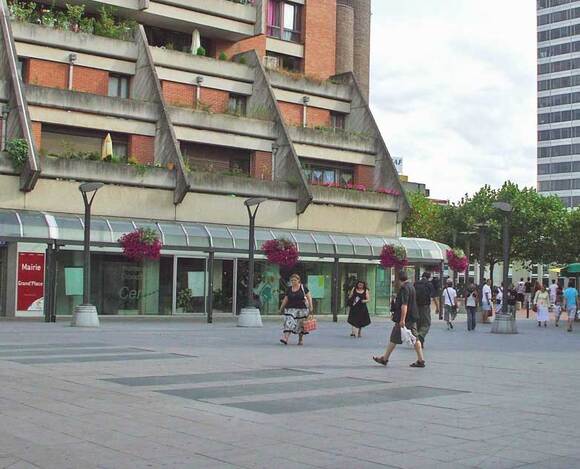
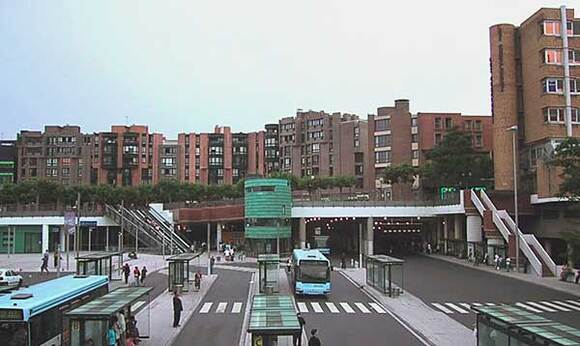
With: Neville Mars / Liu Xiaodu / David Gianotten / Michelle Provoost, & others. The ecocity is now firmly on the agenda the world over, yet for those regions where new cities are actually being built no viable model for its design seems to exist. In aggressive market environments in countries like China, current models fail to deliver both speed and flexibility. At the same time, these environments preeminently offer the laboratory conditions in which new ecocities have a chance to be developed and tested.
GREEN FROM SCRATCH 2
The ecocity is now firmly on the agenda the world over, yet for those regions where new cities are actually being built no viable model for its design seems to exist. In aggressive market environments in countries like China, current models fail to deliver both speed and flexibility. At the same time, these environments offer the laboratory conditions in which new ecocities have a chance to be developed and tested. In the forum ’Green From Scratch 2’ Chinese and Dutch architects and theorists discuss the contradictions between the fragmented conditions and short-cycle investment climate and the long-term integrated visions needed for urban sustainability. Time-based planning methods seem to offer hope to unlock a whole range of problems currently hampering progress in eco-planning.
NAi, 1 July 2011
The newly opened Netherlands Architecture Institute in Rotterdam will host part 2 of the DCF’s Chinese-Dutch twin forum Green From Scratch, which will focus on the challenges planners face putting green ambitions into practice. Three Chinese case studies by Dutch teams will introduce the different aspects of integrated, context specific and ecological planning that can be achieved through a time-based planning approach.
The event will follow the trademark DCF format of dynamic presentations, panel discussions and public debate of Green From Scratch I, and will bring together speakers from China, Hong Kong and Europe. Co-organized by DCF / INTI / NAi.
19:00 Welcome by Ole Bouman (NAI), Michelle Provoost (INTI), Neville Mars (DCF)
Case I: West Kowloon Cultural District
19:15 Presentation by David Gianotten (OMA)
19:25 Debate on socio?cultural integration
20:05 Break. Drinks
Case II: Genetic City Caofeidian
20:20 Presentation by Neville Mars (DCF),
20:30 Debate on evolutionary planning
Case III: Shenzhen Longgang Dutch?Sino Ecocity
21:10 Presentation by Margot Weijnen (NGI)
22:20 Debate on ecocities as a platform for broad societal progress in China
22:00 End. Drinks
Moderated by: Neville Mars (DCF) and Michelle Provoost (INTI)
REGISTER NOW at www.nai.nl/inschrijven
Speakers/ Panelists
Wang Hui, Liu Xiaodu and Meng Yan (URBANUS), David
Ginanotten (OMA), Paul Kroese (MVRD and T?F), Egbert Stolk (TU Delft), Kistrian Koreman and Elma van Boxel (ZUS), Margot Weijnen (NGI), Deborah Hauptmann (TU Delft), Wouter Vanstiphout (TU Delft, Crimson Architectural Historians), Barend Koolhaas, Su Yunsheng (Tongji Urban Planning & Design Research Institute), Alain Fouraux (Nervecorp), Thorsten Schuetze (TU Delft), Yusen Chen (TNO), Neville Mars (MARS Architects).
Movies, pictures, stories GREEN FROM SCRATCH 1 here:
http://burb.tv/view/B.A.R.C._-_Greening_the_Metropolis
Free registration here!
Almere is a multinuclear New Town, some 20 km east of Amsterdam, founded by the Dutch government in 1971, presently housing some 190.000 inhabitants. Almere is located in Flevoland, part of a major water management and land reclamation project, known as the Zuiderzee-project, which Dutch government decided on in 1918 and has been developed ever since. The former sea has been transformed into a freshwater basin of some 2.200 sq. km and into some 1.700 sq. km of new land. On this newly reclaimed land 18 villages and 3 New Towns (Emmeloord, Lelystad and Almere) have been developed since the 1930s.
Almere has been directed by the national government to expand the city with 60.000 houses and 100.000 jobs, to be realized by the year 2030. Almere uses this ambitious scenario of doubling the city to realize a complete city, that is to transform the typically monofunctional New Town to a town with a balanced demographic profile, a wide offer of housing and working environments and a full range of facilities including higher education and the ecological restoration of the surrounding nature, all in a sustainable way. A large part of this extension will be planned by the use of experimental methods, aiming to create a city that is just as much shaped by its inhabitants as by its planners. Almere calls this ‘The Organic City’. The theme of Organic Planning was introduced by alderman Adri Duivesteijn as one of the main goals for the future growth of the city.
This large-scale expansion of Almere is exceptional and rare, both in the Netherlands and in Western Europe. The only precedents for this are the quickly expanding economic areas in Asia. To exchange knowledge and experiences on planning tools for the sustainable city the International New Town Institute organizes an exclusive round table meeting for both Chinese and Dutch experts and those who would like to become experts on green cities.
The ecocity is now firmly on the agenda the world over. Almere launched its 7 Principles based on the Cradle to Cradle filosophy, Caofeidian in China tries to controll the salt water by implementing an islands-and-wetlands approach. Yet for those regions where new cities are actually being built no viable model for its design seems to exist. In aggressive market environments in countries like China, current models fail to deliver both speed and flexibility. At the same time, these environments preeminently offer the laboratory conditions in which new ecocities have a chance to be developed and tested. In the expert meeting ’Green From Scratch’ Chinese and Dutch professionals discuss the contradictions between the fragmented and short-cycle investment climate and the long-term integrated visions needed for urban sustainability. A time-based planning approach seems to become essential to unlock a whole range of problems that are currently hampering the progress of eco-planning. Could new organic organizational models e.g. the Organic City in Almere and virtual planning tools, such as evolutionary planning, offer new opportunities to realize green cities?
Casla and the International New Town Institute organize a finissage on Wednesday June 15. At the end of the exhibition Chinese Tryptich Casla will show the documentary Urbanisation in China: happiness is seen everywhere.
The Documentary is made by David Lingerak in cooperation with Urban Language (co-maker of the exhibition). In this documentary some residents of Shanghai speak on the effects of urbanization on their daily lives.
Ans van Berkum, Director of Casla, will give an introduction and after the documentary there will be drinks!
See more info about the exhibition Chinese Tryptich here!
The New Town Institute is present during the Dutch Real Estate Developers Conference: Provada. At the conference members of the institute will answer questions, in or near the stand of the city of Almere. Don’t miss the mobile simulation game (by Ekim Tan, see picture) to develop your ideal future city!
On Thursday our INTImi program will be launched for a special group at the restaurant As.
We will be happy to meet you at the Almere stand and feel free to participate in the simulation game!
For updates and news follow our twitteraccount.
From 14-16 October 2011, INTI will join the conference “Global City – Local Identity?” in Dar es Salaam, Tanzania. This event is organised by the Goethe Institut Tanzania, in close collaboration with AAT (Architects Association of Tanzania). The conference will tackle questions concerning city development and cultural identity in East African cities. INTI’s Sophie van Ginneken will speak on Dodoma, the Capital City of Tanzania, a New Town designed in the 1970s by the Canadian office Project Planning Associates.
The experts symposium is taking place in a wider range of activities, comprising lectures and two public panel discussions as well as the AAT Architectural Awards celebrating 50 years of Independence. Invited participants include supraregional and international architects and urban planners but also high profile local stakeholders like politicians and investors.
During the conference INTI will share its knowledge on African New Towns such as Dodoma in Tanzania.
Click here for more info
As a part of the STaRT project City Sjopping Mol, the International New Town Institute presents it’s simulation game INTIVILLE during October in the City center of Almere.
Stichting Art Culture organizes a Pop-Up Store in the city center of Almere during October, November and December 2011. This Pop-Up Store is called the City Sjopping Mol and INTI will display its simulation game INTI Ville during October.
INTI will also feature 3 New Town related movies on every 3rd Sunday of the month.
City Sjopping Mol is supported by the Stuurgroep Experimenten Volkshuisvesting (SEV). The SEV is currently experimenting with programms for improving New Towns. The City Sjopping Mol is one of their 7 current experiments.
click here and here for more info on the SEV program regarding New Towns.
Help us to develop your ideal future city!
click here for more information!
Director of the International New Town Institute, Michelle Provoost, will present a lecture for the Strelka Institute in Moscow.
As part of the lecture series ’Design as Politics’ from the Strelka Institute in Moscow, Michelle Provoost will give a presentation on the subject ’from Cold War stratregies to Neo Liberal deals’.
click here for more information!
Opening lecture of the Institute for Housing and Urban Development Studies by Michelle Provoost.
The Institute for Housing and Urban Development Studies has asked Michelle Provoost to open their 2011-2012 programm by informing them on the issues of the fast growing globalizing cities.
Click here for more information!
On November 10 and 21, Michelle Provoost will give lectures at the Berlage Institute.

The International New Town Institute participated in different programmes during the 2011 Bi-City Architecture and Urbanism Biennale in Shenzhen, 8-11 December.
The programme of INTI is as follows:
– INTI organized a workshop on the (socially and ecologically sustainable) urban design of New Towns in and around Shenzhen, in cooperation with the Dutch Ministery of Infrastructure and Environment
– INTI launched the publication Rising in the East. Contemporary New Towns in Asia at a venue of the Biennale with invited speakers and critics.
– INTI participated in ’Six under sixty’, a conference organized by curator Terence Riley to accompany an exhibition on Shenzhen, Almere, Gabarone, Brasilia, Chandigargh and Las Vegas.
– INTI participated during the symposium on ’Shenzhen and the World’, organized by Laurence Liauw.
Click here for more detailed information about our program (text in English and Chinese).
click here for more information about the Biennale.
The International New Town Institute (INTI) was present at MIPIM Asia in Hong Kong and explored succesfully new possibilities for cooperation and to find new friends in the world of real estate and building.
MIPIM is the world’s premier real estate event for professionals and was held from November 15-17, 2011 in Hong Kong. MIPIM brings together the most influential real estate professionals to explore major international property development projects, connect with potential partners, and strike deals over 3 intensive days.
See also: http://www.mipim.com/en/mipim-asia/
For contact details about the visit of INTI during MIPIM Asia 2011 and more information please contact: Mrs. Marit Geluk MSc or Mr. Paul Kroese MSc.
As part of the new exhibition "Ghana: an Organic Experience" and its corresponding student project "Ghanascapes", Michelle Provoost will give a lecture at the Almere architecture center cASLa on Thursday, February 9, 2012.
This lecture will focus on the New Town of Tema, designed in 1960 by Constantinos Doxiadis. The project is based on the research of students from the Amsterdam Academy of Architecture (Amsterdamse Academie voor Bouwkunst). The students spent time in Ghana researching local housing conditions and participating in design workshops to offer viable alternatives. After Dr. Provoost’s lecture the students will present the results of their research and discuss further development and materialization options.
For more information see cASLa.
In het project Ghanascapes onderzoeken studenten van de Amsterdamse Academie voor Bouwkunst eenzelfde benadering. Zij presenteren in de tentoonstelling ontwerpen, geïnspireerd op technieken die in Ghana worden gehanteerd en die zowel voor woningbouw in Ghana als in Nederland toepasbaar zouden kunnen zijn.
Daarvoor zijn de studenten naar Ghana geweest om onderzoek te doen en workshops te volgen. De opgedane kennis hebben ze uitgewerkt in projecten die zowel in Ghana als Nederland/Almere zijn te realiseren.
Op donderdag 9 februari lichten de studenten hun projecten toe om vervolgens met u in discussie te gaan over de projecten en de materialen.
Location: cASLa, Weerwaterplein 3, Almere
Program: begins at 19:30
Cost: Free
Rijksbouwmeester Frits van Dongen en Inge Vossenaar, Directeur Woon-en leefomgeving van het DG Wonen, Bouwen en Integratie, nodigen alle betrokkenen en geïnteresseerden van harte uit voor de presentatie van het magazine ‘Oog voor de buurt’, op dinsdag 7 februari om 16.00 uur in het Atelier Rijksbouwmeester.
Het magazine ‘Oog voor de buurt’, gemaakt in opdracht van het Atelier Rijksbouwmeester/DG Wonen Bouwen en Integratie, schetst een beeld van acht ontwerpateliers die tussen en 2009 en 2011 plaatsvonden in zogenoemde ‘aandachtswijken’. Crooswijk in Rotterdam, Poelenburg in Zaandam, Doornakkers in Eindhoven, Lelylaan en Transvaal in Amsterdam, de Stationsbuurt in Den Haag en Zomerzone in Haarlem. In het blad zijn tevens interviews opgenomen met betrokkenen en experts.
De presentatie begint om 16.00 uur. Aansluitend vindt onder leiding van Allard Jolles (hoofd Atelier Rijksbouwmeester) een paneldiscussie plaats met onder meer Like Bijlsma (SUBoffice), Simon Franke (Trancity) en Michelle Provoost (directeur INTI) over de rol van ontwerpers in de verbetering van de leefbaarheid in wijken en over de betekenis en toekomst van ‘curatele stedenbouw’. De bijeenkomst wordt om 17.00 uur besloten met een borrel.
Aanmelden (gaarne voor 31 januari) kan via rijksbouwmeester@rgd.minbzk.nl
Adres Atelier Rijksbouwmeester: Oranjebuitensingel 90, 2511 VE Den Haag
Organized by "Senatsverwaltung für Stadtentwicklung und Umwelt" as part of the reevaluation process in preparation for the third International Building Exhibition, this event provides a platform for a diverse mix of experts to respond to some of Berlin’s most pressing urban issues. The IBA Berlin 2020 wishes to design the diverse city of the 21st century in a creative and participative process. To this end, Berlin’s specific talents and potentials should be experimentally reevaluated.
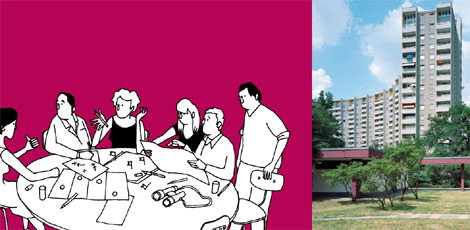
The second event of a series focusing on IBA Berlin‘s major topics – Economy, Knowledge, Living – turns its attention to large housing estates. Housing estates are generally viewed as a problem across Europe.
Nonetheless, they constitute a great potential for cities. The event on 13 February 2012 will discuss how these rigid, often monofunctional large-scale structures can be transformed into lively, mixed locations. How can new perspectives be created, using urban development and architectural means, artistic interventions and activation and participation strategies? What role do large-scale urban structures play in economic, environmentally friendly and socially sustainable urban redevelopment? Discussions with international guests are designed to provide inspiring insights and enrich the Berlin talks.
At this event, Michelle Provoost will present on behalf of INTI as part of the panel on Urban Development and Energy.
Programme
Senate Building Director of Berlin Regula Lüscher
Welcome
Prof. Dr. Michael Koch, HCU Hamburg
Large housing estates as urban building blocks
Prof. Jean-Philippe Vassal, Lacaton & Vassal Architectes, Paris
To do with. To keep capacities. Abnormality as a chance.
Prof. Dr. Karin Bradley, Royal Institute of Technology, Stockholm and Ola Broms Wessel, Spridd
Green social regeneration of Swedish post-war housing
Statements and Talks
Urban Development and Energy
Frank Bielka, Vorstandsmitglied degewo
Prof. Lukas Feireiss, Kunstuniversität Linz
Dr. Ursula Flecken, ISR Berlin
Dr. Michelle Provoost, INTI – International New Town Institute
Arts and Culture
Markus Bader, Raumlabor
Jeanne van Heeswijk, freie Künstlerin, Rotterdam
Willem Sulsters, WSA Urban Revelopment, Rotterdam
People and Interactions
Prof. Tobias Armborst, Vassar College / Architekturbüro Interboro, New York
Joachim Barloschky, ehem. Quartiersmanager in Osterholz-Tenever
Dr. Marie-Therese Krings-Heckemeier, Kompetenznetzwerk Wohnen
Prof. Jean-Philippe Vassal, Lacaton & Vassal Architectes, Paris
Senate Building Director of Berlin Regula Lüscher
Closing remarks
Location: Villa Elisabeth
Invalidenstrasse 3, 10115 Berlin-Mitte
Time: 15:00 - 19:30
Registration is not required
Who makes the city of Almere? That’s the central question during the architecture festival Making Almere from April 21 until July 29, 2012. The event takes place in Almere as part of the International Architecture Biennale Rotterdam (IABR). The International New Town Institute is curator of the satellite exhibition Making Almere.
The festival Making Almere is about the way the new town of Almere will transfrom in the future. In the 1970s, the city was on the drawing boards of several professional designers and planners—without any input from residents. Now, those are roles are reversed. Today, the youngest city in the Netherlands is a leader in the development of a new form of urbanism: one where the inhabitants of Almere build their own city. How is this shift constituted and what form do these urban developments take? The exhibition reveals the step-by-step development of Almere from a completely top-down planned city in the ’70s, up to the future image of Almere as a “testing ground of deregulation”, in which the relationship between the municipal government and the citizen is redefined. Visitors are challenged to experiment with the future of Oosterwold in various ways, including a large, interactive model in the exhibition area.
Come check it out!
Tours
Making Almere will be the starting point for different tours and routes through the city. Visitors can explore the city on their own with the specially developed application for smartphones or with a paper guide. Every Saturday there will be tours accompanied by specialized guides.
Activities
Within the exhibition space, different activities will take place regularly. Making Almere will act as the venue for organizations within the city to hold meetings, discussions, workshops, networking receptions, presentations, lectures, speeches, receptions, (international) guests, educational purposes, reunions, political meetings, brainstorming sessions and more.
Making Almere Mobile
Residents and city makers also belong to the collection of Making Almere. During the fourteen weeks of Making Almere, each week a new building, district or place in the city will be put in the spotlight in a playful manner. With the Making Almere Mobile, the exhibition comes to the residents of different areas every Saturday and asks the question: "Who makes the city? You?" Each city maker is literally added to the collection of Making Almere and receives a unique proof of their participation.
Making Almere is part of the International Architecture Biennale Rotterdam 2012 (IABR 2012) and is made possible by the Ministerie van Infrastructuur & Milieu (RRAAM), the city council of Almere, and Almere City Marketing.
For more information (in Dutch) click here.
Date and time: April 21 until July 29, 2012
Address: Belfort 13, Almere
www.makingalmere.nl
Admission is free
For all ages
’Urban China’ is a renowned Chinese magazine focussed on social geography, urban design and architecture. The magazine has been published for about 10 years, and was the brainchild of founding architecture critic Jiang Jun.
In no. 51, the magazine has published a (Chinese language) review of the Dayuan-Shenzhen workshop, organized by INTI and the Dutch Ministry of Infrastructure and the Environment. The workshop took place in Shenzhen during December, 2011.
The images show scenes from the workshop as well as the book presentation of INTI’s latest publication, Rising in the East: Contemporary New Towns in Asia.
Making Almere: who makes the city?
Who makes the city of Almere? That’s the central question during the architecture festival Making Almere from April 21 until July 29, 2012. The event takes place in Almere as part of the International Architecture Biennale Rotterdam (IABR). The International New Town Institute (INTI) is curator of the satellite exhibition Making Almere.
The festival Making Almere is about the way the New Town of Almere will transform in the future. In the 1970s, the city was on the drawing boards of several professional designers and planners—without any input from residents. Now, those are roles are reversed. Today, the youngest city in the Netherlands is a leader in the development of a new form of urbanism: one where the inhabitants of Almere build their own city.
Making Almere will be located in the city center in a shop at CityMall Almere. A shop where the visitor doesn’t buy anything, but certainly gets something! A DIY-shop where you can work on ‘the city of the future’ directly: and there is still a lot of city left to be made!
Making Almere Architecture Festival
Making Almere is located in the shopping heart of the city and is also equipped as a shop. The exhibition showcases the city’s surprising turnaround – from a New Town directed by politicians and designers to a lively city made by many people; a peek at the future of Almere.
In addition, visitors are challenged to add their own input, designs and contributions to the further development of the city. For example, by participating in Play Oosterwold!, a game about the yet-to-be developed area of Oosterwold in Almere Hout. This is an exhibition that is constantly changing. During Making Almere there will also be several different presentations, debates and public events related to the making of a city. Making Almere is free, fun and educational for all ages.
The city as an exhibition
Almere has a lot of special architecture and an exceptional planning history. Many buildings and places demonstrate that character and are certainly worth a visit. During the fourteen weeks of Making Almere there will be a new building, district or place in the city spotlighted in a playful way each week. The question: "Who makes the city?" remains central throughout the festival.
With a specially-developed Making Almere smartphone application (free to download) or a handy guidebook, visitors can explore the city independently. Every Saturday there will also be guided tours led by different specialists.
Background Information
Making Almere is part of the 5th International Architecture Biennale Rotterdam (IABR) and made possible by the government program RRAAM, the Ministry of Infrastructure and Environment, the municipality of Almere and Almere City Marketing (ACM). The International New Town Institute (INTI) is curator of Making Almere.
5th IABR: Making City
The 5th IABR: Making City shows how the city of tomorrow is created and what role designers play. The Dutch Architecture Institute (NAI) will host a series of related exhibitions and debates beginning on April 20, 2012. In addition, plans for the urban future wil be presented in different locations across Rotterdam. Het Schieblock will act as the headquarters, with a program of events, exhibitions, pop-up stores and pocket parks. Moreover, 5th IABR exhibitions will go on display simultaneously in Almere, São Paulo and Istanbul. There will be an international conference, debates, lectures and publications, along with (VPRO) TV and radio productions. For the full program see: www.iabr.nl
Making Architecture Manifestation Almere
From 21 April to 29 July 2012
Admission is free
For all ages
Address: Belfry 13, Almere
For the full program, location, directions and opening times: www.makingalmere.nl
Architecture Today is a monthly magazine presenting the most important projects in the UK and the rest of Europe.
In March, Architecture Today reviewed the latest INTI publication, Rising in the East: Contemporary New Towns in Asia together with Go West Project’s How the City moved to Mr. Sun. In this excerpt, the reviewer acknowledges INTI’s concerns that the current generation of New Towns is no longer focussed on building for social or altruistic reasons:
"The era of new town development
is largely over in this country, not
just because we lack the political will
or the money, but because current
thinking is that settlements that
come instantly into being – the
realisation of a comprehensive plan
at a single moment in time – lack
the complexity and contradiction
that make healthy, ‘authentic’ places.
In the east, though, they are just
getting started. Although most of
the world’s urban growth today
Books
Eastern promise
comes in the form of extensions to
historic cities or the eruption of
‘informal’ ones (slums), the
Netherlands-based International
New Town Institute has identified
over 400 wholly new cities in the
Middle East and Asia.
Its new book, Rising in the East,
surveys 16 cities, with a commentary
that undermines assumptions about
such developments. Most striking is
the point made by contributors
Michelle Provoost and Wouter
Vanstiphout that the burgeoning
urban population is rarely the
driver for new town development.
Indeed, if anything, new towns are
built to accelerate the process of
modernisation by encouraging
peasants to leave the land, not always
successfully.
Instead, say the authors, the motivations for new town building are typically economic (cities built as make-work schemes or hightech hubs intended to kick-start a new economy) or political (new towns built to express national identity, to dissipate the revolutionary energy of the urban crowd, or to let the rich escape the chaos of the historic city). The book is structured around six such themes, each evidenced by well-researched and illustrated case studies. The authors are alive to the dangers of projecting Western ideals and experiences onto Eastern cities, but their doubt over the quality of these places comes across. This is a matter of more than abstract concern: it is striking that so many new towns are designed by Western architects – from Masdar in Abu Dhabi and the Blue City in Oman, both by Foster & Partners, to New Songdo City in South Korea, by OMA and KPF."
Planum Magazine is an Italian-based journal on urbanism. Planum was the first European on-line journal entirely devoted to the planners and to the whole community of people involved in city development and the protection of the environment.
An excerpt from their review states: "The large scale of the urbanisation in Asia brings to light a number of problems that have not yet been tackled by any single designer. An infrastructure is required for nature, ecology, food supply and water management, otherwise the metropolises will become unbearable. Although urban design models are being applied in the Far East which have now become outdated in the West, new models are being developed at a fast pace as well. It’s all happening in Asia.
Rachel Keeton carried out research on 200 new towns in Asia that have been designed and built in the last two decades. She analysed the principles, similarities and characteristics of these towns. In eighteen cases she conducted more extensive research with interviews, excursions and literature research."
ISBN: 9789461056832
English edition
SUN architecture
Paperback, 432 pages
17 x 24 cm
Buy it here!
colour
November 2011
€32,50 (excl. VAT)
VPRO (originally an acronym for Vrijzinnig Protestantse Radio Omroep, or "Liberal Protestant Radio Broadcasting Company") has come a long way from its religious roots. Today, it is considered the most culturally radical broadcasting group in the Netherlands.
On April 12, 2012, VPRO will host "Leve de Stad" at Pakhuis de Zwijger in Amsterdam. "Leve de Stad Live" is the kick-off event for a weeklong investigation of how we can live happily in the city. The event will be structured in the form of debates, moderated by Teun van de Keuken and Roland Duong.
INTI Director Michelle Provoost will participate in the session "Smart City Unlimited", a documentary on the new players (Siemens and Ikea) in the field of urban planning.
The event is organized as part of the 5th International Architecture Biennale Rotterdam (IABR) and made possible by contributions from the SfA and Shootlab.
For more information and the ful program, click here.
To reserve a ticket, please contact VPRO.
Location: Pakhuis de Zwijger, Piet Heinkade 179, 1019 HC Amsterdam
Date: April 12, 2012
Time: 18:00
*Presentations will be in Dutch
Arnold Reijndorp (1948) is the 18th winner of the Rotterdam-Maaskantprijs, one of the most prestigious architecture awards in the Netherlands. He received the award in recognition of his longstanding commitment and unique fascination for the social aspects of the built environment. The jury commended Reijndorp for his role as a bridge between users, designers and directors. "It’s about the relevance of his everyday observations and the ability to effectively transfer that relevance."
Prof. Dr. Arnold Reijndorp is a research coordinator for INTI, special professor at the Universiteit van Amsterdam and holds the Han Lammers chair for social-economic and spatial development of new urban areas at the Faculty of Social and Behavioural Sciences (UvA).
Reijndorp has spent more than 15 years studying the relationship between urban planning and society. He is the author of leading publications such as ‘Buitenwijk’ and, together with Maarten Hajer, ‘Op zoek naar publiek domein’.
Click here for more information on Arnold Reijndorp’s background and here for more information on this prestigious prize.
Under the title "New Towns of the 21st Century", INTI is organizing a worldwide pooling of knowledge and experience related to New Town planning. Why? Because many New Town developments are predictable: they are designed and built in one fell swoop, they are the product of the insights of a particular juncture in time, have large stocks of the same type of housing that will become outdated simultaneously, form part of a regional development and belong to an existing metropolis.
Building a New Town ’from scratch’ is a heroic undertaking that repeatedly challenges the architect or planner to find the ideal form for the urban program of the day. However, it is alarming how many hundreds of New Towns of the 20th century must be regarded as unsuccessful. A great many well-intentioned experiments have turned out to be failures. We now find ourselves once again in an age of urbanization, this time not in Western countries, but primarily in the so-called BRIC countries and other rapidly expanding economies. To steer the migration and economic growth in the right direction, the New Town as a planning instrument is once again becoming popular.
Research and Exchange Program
It is no longer necessary to experiment blindly with all these new projects: we can learn from existing New Towns, provided that opportunities are created whereby a multidisciplinary pooling of knowledge between practice, research and training is possible. With this objective in mind, INTI is putting New Towns back on the agenda for research institutes, educational institutions, urban planners, architects, project developers, and decision-makers in six different cities around the world by means of its New Towns of the 21st Century project. To do this, INTI is searching for cities that are experiencing lightning-fast urbanization as well as cities where the future of existing New Towns is subject to major urban planning issues. The current tasks set an example for other parts of the world.
Shenzhen and Chandigarh
Over a three-year period, a research and exchange program for students and professionals will be established, supported by temporary outposts for several ’researchers in residence’, beginning in Shenzhen (China) and Chandigarh (India) from September 2012 onwards.
More information will follow shortly.
On April 18, SICA Dutch Centre for International Cultural Activities organises an expert meeting on working in China. This time our focus is on architecture and the development of cities. SICA invites relevant partners and professionals who are active in China to share their knowledge and experience in these fields. After the presentations we kindly invite you to take part in the discussions with the speakers and work on your network during a dinner.
After a short introduction on cultural exchange between the Netherlands and China by Monique Knapen, programme director China at SICA, Huang Weiwen will deliver the key note speech. Huang Weiwen is deputy chief urban planning of the Shenzhen municipality, senior advisor of the Hongkong/Shenzhen biennale of urbanism and architecture and director of theShenzhen City Design Center. He will present his work and talk about the developments in Shenzhen in general.
Our other guest speakers are Ole Bouman, director of Netherlands Architecture Institute,Linda Vlassenrood, programme director at International New Town Institute, Janwillem Schrofer, chairman of the board of the Chinese European Art Center and Christine de Baan, Programme Director Dutch Design Fashion Architecture.
We hope to welcome you there!
Wednesday 18 April 2012, 16.00 - 21.00 hrs (presentations and network dinner).
Lloyd Hotel, Oostelijke Handelskade 34, Amsterdam.
Costs for the event, including dinner: 22,50 euro to be paid at the spot.
Language: English
Please note: register before 13 April, as the number of seats is limited. You will receive a confirmation of participation after 13 April.
For questions, please contact SICA, Alex Lebbink or Kayan Tang, T 020 6164 225 / e-mail post@sica.nl
On Wednesday April 11, 2012, the Book Launch of Complexity Theories of Cities have Come of Age edited by Yuval Protugali, Han Meyer, Egbert Stolk and Ekim Tan, will take place in the Berlagezaal at the TU Delft.
Program:
15:30 Coffee
16:00 Introduction – Han Meyer (Professor Urban Design, TU Delft)
16:10 Short lecture by Maarten Hajer (Director of the Netherlands Environmental Assessment Agency)
16:30 Short lecture by Gert de Roo (Professor Spatial Planning, University of Groningen)
16:50 Short lecture by Juval Portugali (Professor Human Geography, Tel Aviv University; Visiting Professor, TU Delft)
17:10 Official book presentation - the book will be presented to Maarten van Steen (chairman NWO theme group Complexity)
17:25 Announcement of the next conference by Machiel van Dorst (chairman of the dept. of Urbanism, TU Delft)
17:30 Drinks
More information can be found here.
In recent times, the use, and misuse, of large-scale and long-term planning for urban, regional, and national development has led to heated debates about the role of the government, of planners and designers, and of politics and the public. Dutch physical planning and design has traditionally been at the forefront of large-scale and long-term planning. It is, however, not at all clear what lies ahead. The book ’Dutch New Worlds. Scenarios in Physical Planning and Design in the Netherlands, 1970-2000’ by Christian Salewski is the first account of the history and theory of the scenario method in urban, regional, and national planning and design. The initiators regard this as a welcome opportunity to discuss the present state and the future potential of explorations of the future, of large-scale and long-term planning and design, and of contemporary utopia and ideal cities, both in the Netherlands and abroad.
Speakers:
– Christian Salewski(ETH Zurich, Institute for Urban Design)
– Henk W.J. Ovink (Ministry of Infrastructure and the Environment, 5th IABR)
– Michelle Provoost (Crimson, INTI)
– Peter Swinnen(Flemish Government Architect, 51N4E)
– Kees Christiaanse(KCAP, ETH Zurich, Institute for Urban Design)
Dutch New Worlds
Our decisions shape our future, but we know little about how. To find out, planners and designers construct vivid images of what could be. These scenarios serve as path-breakers between imagination and reason. In the late 1980s, the elite of Dutch planning and design took scenarios to unprecedented scales to convince the public of their ideas. But the quest to reshape the Netherlands as a whole failed dismally. Their attempt, however, unleashed a wave of new thinking about the future and created an enormous number of spectacular images of things to come. Dutch New Worlds tells for the first time the story of how scenario thinking changed urbanism and physical planning, from its beginning in the late 1960s to its height in the 1990s. It shows how most grand scenario projects came to nothing because of overambition and misuse. It also shows how, today, scenarios remain powerful tools for focused and transparent design research to create better cities and regions. Told from the perspective of an architect and urbanist, this history of ideas holds fundamental lessons for planners, designers, and policy makers – and for our next decisions that will shape our future. Dutch New Worls is published with 010 Publishers Rotterdam in February 2012 (English edition) and February 2012 (Dutch edition).
This debate is organized by ETH Zurich, Institute for Urban Design & the Ministry for Infrastructure and the Environment.
Click here for more information.
Register to attend the debate here.
Date: Tuesday June 12, 2012
Time: 20:00 h. Doors open 19:30 h.
Language: English
Location: Auditorium of the NAI, (Museumpark 25, Rotterdam)
Entrance Fee: €7,50. Students €3. Free for Friends of the NAI.
On April 12, VPRO presented the project ’Leve de Stad’ in Pakhuis de Zwijger in Amsterdam. Roland Duong and Teun van de Keuken presented and opened the evening with a short conversation with George Brugmans, Director of the IABR and Wim Schepens, chief editor of ’Leve de Stad’.
The debate functioned as an introduction to the Tegenlicht-premiere of ’Making Cities: de stad van de toekomst’ (’Making Cities: the city of the future’; click here to view the episode online.). The debate focussed on the question: ’who takes the initiative in the building and organization of the cities of the future?’
Chris Kijne led the debate with Thomas Hattig, project leader of IKEA’s Strand East project by LandProp in Londen, Kristian Koreman of ZUS architects and Michelle Provoost, Director of the International New Town Institute.
Click here to check out the debate.
’New Towns |
New Territories’
Date: Thursday September 27, 2012.
Place: Netherlands Architecture Institute (NAI), Rotterdam, Netherlands.
Time: 9 am – 7 pm.
| Read more | Program | Registration |
The conference ’New Towns | New Territories’ explores the latest innovations in global urbanization, privatization and new organizational models of urban development as well as the impact and challenges for professional practice.
Global urbanization is moving at a faster pace than ever before and it is showing a fundamental shift in its structure and organization. Hundreds of economic, eco and satellite cities are being developed by private companies. Not only in Asia, but also in Europe. The growing privatization has led to an increased dynamic between client, investor, developer, designer, builder and end-user. The organizational models shift with each new urban development as alliances, politics and financial interests change.
We want to know: Who are the new players in the field of urban development? What visions, ambitions and strategies do they have? What innovations and financial models make these cities possible? And, perhaps most importantly: how will these new approaches change the quality of life in our future cities?
In cooperation with the International New Town Institute, the Province of Flevoland and Entente Florale, the municipality of Almere is organizing the conference Growing Green Cities I: A Call to Action on Thursday the 20th of September 2012. The goal of the conference is to create a dialogue between the two agendas of (international) horticulture (tuinbouwsector) and international Green Cities. The conference should function as the start of a ten-year-long international exchange program about Green Cities.
Content
Are you faced by the societal challenge of keeping your environment healthy and attractive? Are you seeking a better balance between red and green? Become inspired by trendwatchers, speakers from the horticulture sector and from the worlds of architecture, construction, health, renewable energy and discover why Growing Green Cities is so important.
Led by Dirk Sijmons you will join the quest for the green cities of today and tomorrow in the company of international speakers like Adjiedj Bakas, Jaap Spros, Andreas Kipar and Elco Brinkman who will enlighten us with their vision of Growing Green Cities, the prevailing trends and best ‘green’ practices.
Growing Green Cities: A Call To Action is being organised by the municipality of Almere in collaboration with Entente Florale, the International New Town Institute and the province of Flevoland. This international conference is intended to provide a platform for the agendas of the horticulture sector (Growing Green) and the green model cities (Green Cities) as well as prompt dialogue between these two agendas.
International exchange of knowledge
In addition to the central theme of Growing Green Cities, there are four specially designed parallel sessions on the themes of “Greening”, “Feeding”, “Energising” and “Healthying” the City.
Program
For the Program, click here.
A call to action
This conference is an invitation to the (international) horticulture sector, the Green Cities and the associated research and innovation institutions to converge over the next ten years to create a universal image of the ideal Green City, to put this into practice and, where possible, in connection with official World Horticultural Exhibitions.
Register
You can register NOW for the Growing Green Cities I conference and for the excursion at www.floriadealmere.nl. The conference fee is €195 per person, including VAT.
For more information contact Esma Bolat via ebolat@almere.nl / 036 527 7288.
Location:
Floriade 2012, Venlo
Date:
20 September 2012
The latest INTI publications provide an overview of the oldest New Towns ever built and the first Alternative Travel Guide in our newest series. Get them while they’re hot!
These publications will be available now for download by INTImi members only.
Excavating the Past: New Towns in the BC Era
By: Terpsichori Latsi
This publication examines the most ancient New Towns known to man. These include many Greek and Egyptian settlements, as well as the Peruvian city of Caral. The oldest of these is Catalhoyuk, a Neolithic and Charcolithic urban settlement that existed between 7500 BCE and 5700 BCE. Nekhen (or Hierakonpolis), is another interesting example. The “City of the jackal-headed souls”, was located in Upper Egypt and remained a religious and political capital during the Pre-dynastic period (3200 – 3100 BCE) and probably the Early Dynastic period (3100 – 2686 BCE). The city was founded around 3800 BCE. The most recent planned city explored in this research is Olynthus, an ancient city in Chalcidice, that (according to mythology), was founded in 432 BCE by Olynthus, the son of Heracles (Hercules). The city was home to about 15,000 inhabitants. The research also includes case studies of Memphis (3000 BCE), El Lahun (1897 BCE), Akhetaten (1353 BCE), Massalia (600 BCE), Halieis (465 BCE) and Priene (1100 BCE).
Nowa Huta Travel Guide
Editors: Saskia Hulskes and Sofia Anapliotis
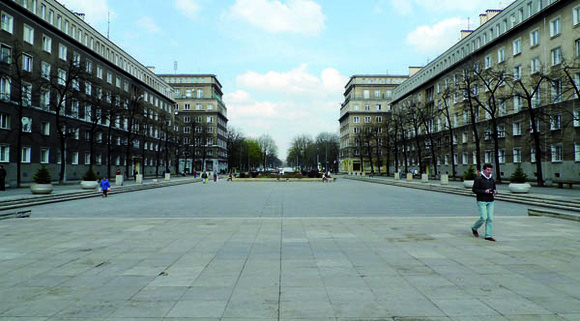
Largely unknown as a tourist destination, Nowa Huta, Poland is filled with exciting discoveries just waiting to be made. For the intrepid traveler, this Communist New Town is both a blast from the past, and a bustling urban district. Take a driving lesson in a restored Trabant, wander into a Milk Bar straight out of 1950, or hit the dance floor in a new discotheque. Wherever you end up, you’ll find a city teeming with stories from the (anti-)Communist period as well as contemporary culture. For the architecture enthusiast, Nowa Huta is also one of the best examples of preserved Soviet Realism.
This is the first installment in a series of Alternative Travel Guides initiated by the International New Town Institute. We’ve done the research so you can enjoy these undiscovered and unloved New Towns—before the rest of the world finds them!
’Atlas Nieuwe Steden’ and ’Nieuwe Steden in de Randstad’
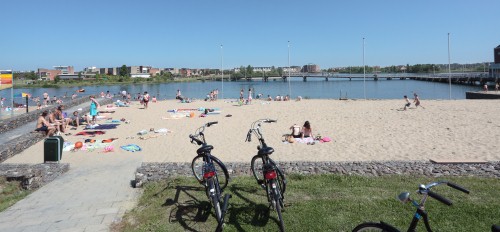
On September 26 the International New Town Institute, Trancity and the Netherlands Environmental Assessment Agency (PBL) will present two new Dutch publications:
’Atlas Nieuwe Steden, de verstedelijking van de groeikernen’
+
’Nieuwe Steden in de Randstad, verstedelijking en suburbanisatie’.
The Atlas Nieuwe Steden doesn’t show the uniform, outdated image of dormitory towns but shows the qualities of this new attractive suburban urbanity. Both of the publications were written by Arnold Reijndorp, Like Bijlsma and Ivan Nio and were based on research on nine Dutch New Towns: Almere, Capelle aan den IJssel, Haarlemmermeer, Houten, Lelystad, Nieuwegein, Purmerend, Spijkenisse en Zoetermeer.
Program
– Explanation of the publication by the authors Arnold Reijndorp, Like Bijlsma and Ivan Nio
– Discussion lead by JaapJan Berg
– Drinks
Registration
Please register via: info@trancity.nl
For more information about the publications and the program: www.trancity.nl
Date: September 26, 2012
Time: 16.00—18.00
Location Architectuurcentrum Makeblijde
Architectuurpark Makeblijde
Oud Wulfseweg 3
3992 LT HOUTEN
The Netherlands
The International New Town Institute participated in the research for the exhibition curated by Crimson Architectural Historians during the 13th International Architecture Biennale of Venice. The Biennale is titled "Common Ground" and takes place from 29th August - 25th November 2012.
The exhibition curated by Crimson Architectural Historians is titled "The Banality of Good: can we build New Cities that reflect our values?" and will be presented in the exhibition venue The Giardini. It will display a series of 6 exemplary cities that were planned and built in the post war period until the present day. The selected cities are Almere (Netherlands), Stevenage (UK), Songjiang (China), King Abdullah Economic City (Saudi Arabia), Tema (Ghana) and Alphaville-Tamboré (Brasil).
The ‘stories’ of these cities will be showcased through large individual allegorical representations in the shape of huge triptychs. Together these will form an immersive, evocation of the cities and their underlying ideals, set off against a diagrammatic notation of their underlying organization. The exhibition will culminate in a loud call to order, directed at the architectural community to re-enter the intimidating world of urban policies.
The International New Town Institute and Crimson invite the architect to think about what each city should minimally provide, what each city should at least mean for its inhabitants, and which contribution architecture could make to any city. We want architecture to re-engage with the banality of urban planning, as a force for the good.
Click here for more information on the Biennale di Venezia.
City and nature enhance each other; both are needed for a healthy, attractive living environment. Yet there is a tension, with 50% of the world’s population already living in cities – just 2% of the earth’s surface – and set to rise to 70% by 2050. It is obvious that such a demographic shift will put a lot of pressure on space as green increasingly has to make way for red.
So how can we safeguard the liveability of our cities, in the knowledge that such cities will only grow and become even more populated? How can we preserve those valuable open spaces, our green sanctuaries? How can urban growth go hand in hand with a higher quality of life for billions of people, with enough food, with healthy systems for energy and water? It is a universal issue that is becoming more urgent in every shift from rural to urban living.
Growing urbanisation is forcing us to look for ways of keeping our cities healthy and attractive, not just for ourselves but for future generations. It is a task for society as a whole, so not the exclusive domain of urban citizens or policymakers. Also urban developers, architects, planners, (environmental) activists, ecologist, scientists, entrepreneurs and NGOs need to find a better balance between red and green.
The quest is already under way. All over the world, and on different scales, initiatives are getting off the ground, often under the header of ‘Green City’, which colour our cities greener, both literally and figuratively: green roofs in Chicago, windmills in Copenhagen, urban parks in Curitiba, CO2 reduction in Vancouver, waste recycling in San Francisco, LEED-certified towers in Taipei, sustainable transport in Portland and healthy food systems around (new) major cities in Asia and Russia.
‘Green City’ is not possible without ‘Growing Green’
The municipality of Almere has registered its candidature for the Floriade 2022, the seventh world horticulture exhibition on Dutch soil, to be awarded by the Netherlands Horticulture Board (NTR). It is in the run-up to the Floriade that a link can be laid between all the parties, national and international, that are concerned about the future of our cities and the horticulture sector, for which ensuring enough food, clean drinking water and renewable energy is the key societal task for the coming decades. It is precisely because this task is shifting more and more to the city in the face of ongoing urbanisation that the horticulture sector – comprised of tree, fruit and flower nurseries, food horticulture and ornamental plant growers – has such a vital role to safeguarding the liveability of our cities.
Growing Green Cities – A Call To Action
If Almere is awarded the Floriade 2022, Almere intends, in very close collaboration with the NTR, to cluster strengths. The challenge is to bring together the knowledge and expertise from around the world to create a shared vision of what the ideal ‘Green City’ should or must be. We will do this by (organising) a ten-year long dialogue focused on exchanging national and international best practices.
On behalf of the municipality of Almere I invite you to take part in this dialogue, in both word and deed, to contribute your own expertise and to learn from the expertise of others. The dialogue begins on 20 September 2012 with the ‘Growing Green Cities – A Call To Action’ conference at the Floriade grounds in Venlo. The conference is being organised by the municipality of Almere, the province of Flevoland, Entente Florale and the International New Town Institute in collaboration with Elba Media. A varied programme has been drawn up. For more information on how you can register, click here. For more information on the conference in Dutch click here.
Prior to the decision of the NTR, we want to show you that the ‘Green City’ is no utopia but a prospect that beckons. I therefore look forward to seeing you on 20 September, at the first exploration of our ‘Growing Green Cities’ network.
Adri Duivesteijn,
Councillor for Sustainable Spatial Planning
Chairman of the Floriade 2022 Steering Committee
Due to the success of the Information Center Making Almere (originally part of the International Architecture Biennale Rotterdam 2012 (IABR)), the Center will be prolonged until June 2013. Making Almere is about the way the New Town of Almere will transform in the future. In the 1970s, the city was on the drawing boards of several professional designers and planners—without any input from residents. Now, those roles are reversed. Today, the youngest city in the Netherlands is a leader in the development of a new form of urbanism: one where the inhabitants of Almere build their own city.
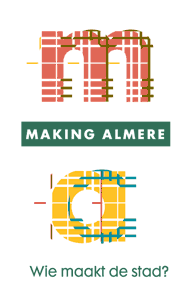
How is this shift constituted and what form do these urban developments take? The exhibition reveals the step-by-step development of Almere from a completely top-down planned city in the ’70s, up to the future image of Almere as a “testing ground of deregulation”, in which the relationship between the municipal government and the citizen is redefined. Visitors are also challenged to experiment with the future of Oosterwold in various ways, including a large, interactive model in the exhibition area.
Making Almere will function as an Information Centre about the making of the New Town Almere. We welcome all kind of organizations, schools and other groups to visit the exhibition and use our facilities.
For bookings or visits outside of opening hours please contact mr. Jacob Buitenkant.
Making Almere is made possible by a generous contribution from Gemeente Almere.
Opening hours
Wednesday: 12-17 hrs
Thursday: 12-17 hrs
Friday: 12-17 hrs
Saturday: 12-17 hrs
Belfort 13
1315 VA Almere
the Netherlands
www.makingalmere.nl
On the 27th of September INTI organised the conference New Towns New Territories. New Players in Urban Development. The conference explored the latest innovations in global urbanization, privatization and new organizational models of urban development as well as the impact and challenges for professional practice. The growing privatization has led to the development of many new New Towns by private companies. While in the post-war period the public authorities were the principal developers, nowadays we see private parties taking over.
The conference brought together a varied crowd: speakers included representatives of multinational companies, such as Cisco, Landprop/InterIkea, MAB, MVRDV, HOK, Accenture, RoyalHaskoning DHV and Landor Associates.
Four case studies - New Songdo (Korea), Strand East (UK), PlanIT Valley (Portugal) and Lavasa (India) – functioned as a starting point for the discussion, focusing on the characteristiscs, advantages and challenges of each organizational model; asking how we might apply these market-based models in other parts of the world and suggesting how to enhance the quality of life in new urban environments.
See also the review (in Dutch) on Archined.
Professor of Urban Sociology Arnold Reijndorp (1948), research coordinator at INTI, has received the Rotterdam-Maaskant Price for his work and research activities in the field of urban sociology. In his research Reijndorp analyses the practice of everyday life in urban environments. He is highly respected because of his efforts to connect theory and practice and also to connect professionals and policymakers with inhabitants.
Since 2006, Arnold Reijndorp holds the Han Lammers Chair at the University of Amsterdam at the Department of Geography, Planning and International Development Studies; the chair is dedicated to socio-economic and spatial developments of new urban areas. Reijndorp – trained as an architect at the TU Delft – chose early in his career for a socio-economic focus in his analysis of the city.
The Rotterdam-Maaskant Price is a biennial price for persons who have distinguished themselves in special degree in the field of the reflection on architecture, urban planning and landscaping by publications, education and/or research.
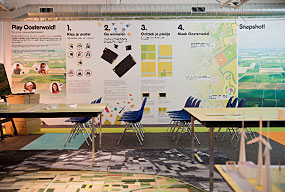
The exhibition Making Almere is transformed into an information centre and prolonged until the end of this year. The information Centre Making Almere / Floriade 2022 is available for meetings, presentations and lectures. We invite all organizations, schools and other groups in Almere and beyond to use our facilities.
For more information about the Information Centre, bookings and visits you can contact: Jacob Buitenkant.
Date: sept-dec. 2012
Location: Belfort 13, Almere
During 2013 INTI is organizing monthly meetings in the exhibition space of Making Almere. In each meeting two researchers will give a presentation on the outcomes of their research/thesis/PhD, with content related to urban planning and New Towns. At the end of each presentation there is time for discussion.
Recently covered topics include: new cities and identity, vulnerable households in the purchasing sector, the lower middle class, Early Warning Systems, suburbia, restructuring the existing city, and the urban development of events sites.
We offer researchers the possibility to present their research at Workspace Almere. The meetings are free and open to the public. For notification of one of the meetings or if you would like to give a presentation, please contact Jacob Buitenkant: j.buitenkant@newtowninstitute.org.
The next meeting of Workspace Almere will be Monday April 8, 10:30 – 12:30 at Belfort 13, Almere.
Makis Mintzis will present his Rijksuniversiteit Groningen Vastgoedkunde PhD thesis: "Floriade 2022, an innovative way of urban development"
Ivan Nio will present his University of Amsterdam/INTI PhD thesis: "Modernization and Planned Suburbanization" with case studies in Almere, Milton Keynes and Cergy-Pontoise
The 24th Session of the Governing Council of the United Nations Human Settlements Programme (UN-Habitat) will be held from 15 to 19 April 2013 at the UN-Habitat headquarters in Nairobi, Republic of Kenya, under the theme of Sustainable Urban Development: The Role of Cities In Creating Improved Economic Opportunities For All, With Special Reference To Youth and Gender.
INTI will join the GC24 with an exhibition about our latest research into New New Towns around the world. Other participants include UN-Habitat partners and organizations interested in urban sustainability; particularly those issues related to
urban sustainability, including:
• Cities will showcase programs, initiatives, partnership and solutions to address the challenges of sustainability
• Countries will present programs on cities at the national level
• United Nations agencies and other international organizations will profile their work on building better cities globally
• The private sector will present services, products and innovative solutions to urban problems
• Non-governmental organizations will promote their roles in urban sustainability
• Researchers and publishers will present the latest information on urban trends
For more information, click here.
What connects King Abdullah’s Economic City in Saudi Arabia to Stevenage in Hertfordshire? Or the city of Songjiang in China to Tema in Ghana? Each are new towns - planned places, quite different in their own way, but each sharing a DNA inspired by an agenda and set of ideals of what makes a place.
Based on six international cities built between World War II and the present day, this exhibition by Dutch collective, the Crimson Architectural Historians in cooperation with the International New Town Institute- first shown at the Venice Architecture Biennale in Summer 2012 - looks at the architecture and socio-economic drivers that inspired their development and the complexities of city making.
Showcased through large allegoric triptychs that represent both the dreams and the realities of the towns, it asks: Can the design of New Towns again be a subject of collective pride? Instead of the banality of the icon, the banality of wealth or the banality of fear, like we see in so many new cities at the moment, can it be the Banality of Good?
Associated Talk and Sing-along
The Banality of Good: From Stevenage to the World
Tuesday 26 March, 7.45pm
As part of the Spring Last Tuesday, Crimson Architectural Historians lead an introduction to the exhibition, followed by a musical performance of ’Brasilia’ by the singer, guitarist and author Mark Ritsema. Free event - drop in on a first-come, first-served basis.
Fees:
Admission to all RIBA exhibitions is free.
Contact:
Please note, galleries may be closed early for special events. Call +44 (0)20 7307 3699 to check opening times.
Organiser:
Crimson Architectural Historians in cooperation with the International New Town Institute
Sponsors:
The Embassy of the Kingdom of the Netherlands
March 26 - May 14, 2013
10:00 AM - 5:00 PM
Venue:RIBA, 66 Portland Place London W1B 1AD
On January 17, INTI attended INTI ambassador Sir Peter Hall’s lecture Squaring the Circle: How to Reconcile Apparently Impossible Contradictions in Contemporary Urban Policy followed by a roundtable panel discussion on Technologies for Tomorrow’s Smart Cities’ at the Crystal in London.
Both the lecture and the roundtable / panel discussion were held in the auditorium of ‘The Crystal’ the recently opened Sustainable Cities Initiative by Siemens in East London. The event was followed by a reception to mark the official start of IFHP’s Centenary year.
The lecture by Sir Peter Hall is the fourth in a series by well-known planners, policy-makers and other ‘urban thinkers’ organised by AESOP and IFHP in the framework of respectively their Silver Jubilee (2012) and Centenary (2013). The lecturers in the series have been asked to present their ideas on ‘new thinking’ and a ‘new vision’ for planning and territorial development under the general title ‘From Cities of To-morrow to a Tomorrow for Cities’. The aim is to provide inspiration in the search for answers to present-day and emerging challenges that are being faced by all professionals involved in the planning of our complex and dynamic urban settlements.
INTI Director Michelle Provoost will be a keynote speaker at Rethinking the Social in Architecture at the Umeå School of Architecture in Sweden. Other keynote lecturers include: Dana Cuff, Anne Lacaton, Constantin Petcou, Doina Petrescu, and Sven-Olov Wallenstein.
Over the three-day conference, speakers will reflect on and discuss these questions together with researchers from Architecture in Effect, ResArc, and beyond, that in thirtyfive papers will present the results from their current research projects. In addition to this among our international guests are Tahl Kaminer, Hilde Heynen, and Jane Rendell who will be joining and present their views on the importance of addressing the social in architecture.
The symposium Rethinking the Social in Architecture is arranged by Architecture in Effect, a strong research environment in Architecture Theory and Methodology funded by The Swedish Research Council Formas.
The "recent" economical crisis has led to a full-fledged political and social crisis. In Europe new antagonisms and struggles are developing over the defense of the welfare state and the programmatic exclusion of large groups of people from economic activity and political participation, and fears of an ecological disaster that awaits us of us has turned into a realistic projection.
click here a more detailed agenda.
We are pleased to introduce three students from the Jan van Es Institute who will be conducting research traineeships during INTI’s summer course: Health Care in New Towns. As part of the annual Almere Summer School, this 5-day course will focus on the planning and (re)design of New Towns all over the world with special attention to health aspects of new urban environments. During the summer course we will explore the differences and similarities within health care systems in a selection of New Towns in different regions of the world.
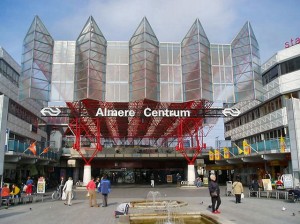
For more information on Health Care in New Towns click here or contact:
EFPC: D.Aarendonk@nivel.nl
Jan van Es Institute: info@jvei.nl
New Town Institute: info@newtowninstitute.org
Click here to apply now!
Matthijs van Maanen
Hi! My name is Matthijs van Maanen, I am 23 years and an intern at the Jan van Es Institute. I am a second year student Management, Policy Analysis and Entrepreneurship in the Health and Life Sciences (MPA) at the Vrije Universiteit Amsterdam. This Master programme focuses on the scientific aspects of integrating different areas of knowledge and on developing effective policies, taking the right decisions, and motivating and managing the professionals who work in this sector.
In February 2013 I started my internship and I will conduct research on the topic of health care in New Towns. In the upcoming months I will aim to identify both best practices and worst practices concerning the development of health care policy in order to improve the existing health care system of Almere and Zoetermeer. More specifically, I will evaluate the current health care policies of these two Dutch New Towns. Within this evaluation, I will assess their goal realization as well as their effectiveness with regard to the health care policy.
Renske Voorn
I’m Renske Voorn, currently studying Management, Policy Analysis and Entrepreneurship in the Health and Life Sciences (MPA) at the Vrije Universiteit Amsterdam with a specialization in international public health. Two weeks ago I started my internship at the Jan van Es Institute to do research about health care in new towns. I am specifically interested in this internship because of its international scope: New Towns have been developed all over the world and recently in Asia and Africa many New Towns are being built. Because health care is not a common topic within the field of New Town planning it’s even more important to conduct research in this field. I will be looking at the recently built New Town Kilamba in Angola. The Chinese investors have built an enormous New Town near the capital, Luanda. Because of the relatively high costs for the apartments hardly any people are living there. My research focuses on the planning process for the health care: how were aspects like accessibility and availability taken in account? Which stakeholders have been involved during the process?
Yang Qin
Yang is currently a second-year master student in Management, Policy Analysis and Entrepreneurship in the Health and Life Sciences (MPA) at the Vrije Universiteit Amsterdam specializing in policy. She studied pharmacy in an undergraduate program in Chengdu, China. One and a half year ago, Yang came to the Netherlands from China. Her background accounts for her interest in the study "Health Care in New Towns":Shenzhen (a Chinese New Town), is located very close to her hometown, and is one of the research subjects. Her research aims to contribute to the development of primary care in Shenzhen by investigating Almere’s experience in primary care regarding resource generation and service delivery can be learned from by Shenzhen.
Period
July 15, 2013 – July, 19 2013 in Almere
Costs
» Course Fee: € 1.625 ,- including course materials and excursions; (does not include accommodation)
» Total course price € 1.745,- (this includes accommodation SHARED)
» Total course price € 1.920,- (this includes accommodation ROOM of OWN)
» Accommodation Fee Almere: EUR 120,- per week (shared room with one other participant for the duration of the course)
» Accommodation Fee Almere: EUR 295,- per week (room of your own for the duration of the course)
Registration
To register go to: http://www.summerschoolalmere.nl/application
Deadline registration: April, 15 2013
From February 25 to March 1, the International New Town Institute hosted a one-week design workshop for students of the TU Delft Design as Politics studio at Almere. The municipality of Almere initiated the design workshop, which was held at the exhibition space Making Almere.
The students explored two main issues during the workshop:
1) They investigated possible urban planning models that respond to the current housing situation of mainly smaller developers (for example, a small-scale contractor who develops just five homes).
2) An urban study pertaining to the Cascade Park area, interweaving public construction areas with a large, anonymous park area.
In total, nine students attended the workshop. On Friday, March 1, they presented the first results to the municipality’s planning department. INTI and the Design as Politics studio are now working together with the students to make a report for the municipality. This will be presented during a dialogue with the municipality of Almere.
Reflecting on her experience of three specific community-focused projects: Heerlijkheid Park, Co-Housing in Hoogvliet and the Hofbogen ’Mini-Mall’, Michelle Provoost, co-founder of Crimson Architectural Historians and Director of the International New Town Institute, will explore how development projects can facilitate or foster ’communities’.
Is it even possible? With the benefit of hindsight, how do such projects develop once the design teams have moved on? And how do we judge their success or failure?
Join the discussion at the Architecture Foundation on Wednesday evening, March 13, 2013.
For more information click here.
Date: Wed 13 March 2013
Time: 7pm
Location: The Architecture Foundation, Ground Floor East, 136 - 148 Tooley Street, London
Today is the start of the international real estate event MIPIM World in Cannes, France (March 12-15). In the latest City Leaders magazine (published by MIPIM), INTI’s director Michelle Provoost urges stakeholders to find new ways to develop long term values. Read the full article on the City Leaders website.
Under the theme: ‘Sustainable Development: The role of cities in creating improved economic opportunities for all, with special reference to youth and gender’, the 24th Governing Council of UN Habitat came to a close on April 19. After a spirited opening by newly elected Kenyan President Uruhu Kenyatta on Monday, the conference offered a variety of inspiring sessions ranging from a in-depth look at new, experimental forms of Land Readjustment ("PiLar:Participatory and Inclusive Land Readjustment") to an exploratory discussion over the new generation of National Urban Policies (NUPs).
INTI representatives were present during this eventful week as two of the 1144 delegates from 107 countries. Several resolutions were adopted after intense discussion and negotiation, and after some heated debate the work program and budget for the coming two years was eventually approved.
Videos from the conference can be viewed here.
Click here to download all the documents and presentations from the GC24.
Michelle Provoost, Director of the International New Town Institute, recently participated in a series of lectures curated by Strelka, the Moscow architecture school. In this "Strelka Talk", From Welfare City to Neoliberal Utopia, Dr. Provoost discusses the evolution of utopian models for creating new cities.
Strelka Talks. "From Welfare City to Neoliberal Utopia" by Michelle Provoost from Strelka in Russian on Vimeo.
This lecture follows the shift from welfare state ideal (focusing on social housing and public spaces) to neoliberal utopia of privatized cities and its implications for the citizens of New Towns.
On May 28, INTI is organizing the expert meeting “Jonge Helden in New Towns” (Young Heroes in New Towns) in collaboration with Platform31. The expert meeting marks the end of the experimental program Self-organization in New Towns, which has been carried out over the past year by Stuurgroep Experimenten Volkshuisvesting (now Platform31). You are welcome to participate.
The expert meeting is about self-organization by young people in New Towns. We see that New Towns often fall short in the area of social and cultural facilities for young people. This is one of the reasons why young people often leave New Towns. We wonder how the city can more successfully connect with the youth who continue to live in these New Towns. To find out, it’s important to know exactly what young people need from their city; and who better to ask than the young people themselves?
Young Heroes, researchers and professionals
During the expert meeting, the experts are the Young Heroes themselves: the young people in Almere, Zoetermeer or other New Towns who have devised, organized and implemented their own projects. Researchers from the academic world will also be present, as well as professionals in the field of self-organization and community participation, such as policy makers and youth workers.
Program
The expert meeting consists of a plenary session in which a number of professionals and Young Heroes will tell their story. Afterwards, the floor will be opened for discussion and we will address the following questions:
• What experiences do young people have with self-organization?
• What is needed by young people to facilitate (better) Self-organization?
• What facilities are currently available in New Towns for young people and is this adequate?
• What do young people need and what can they do themselves?
• How can policy be adapted so that youth can find more opportunities for self-organization?
Date: May 28, 2013
Time: 16:00 - 19:30
Location: Making Almere Exhibition Space, Belfort 13, Almere
Language: Dutch
Contact: natasja.vanderveer@platform31.nl to reserve your place.
In 1962 Zoetermeer was designated as the satellite "overspill" New Town of the city of Den Haag. Zoetermeer had to be compact, a green city with good infrastructure and a modern city center. The city’s rapid development over the last 30 years has been less clear than the plans suggest. For some overview of the legislative history and in the current situation the International New Town Institute (INTI) and the city museum of Zoetermeer (Stadsmuseum Zoetermeer) are organizing the course ‘Learning from Zoetermeer’ from 30 May to 4 July. The course offers local residents and other interested parties the opportunity to learn about the development of the New Town Zoetermeer during six evening presentations and discussions.
Program:
30 May - Zoetermeer as New Town
The relationship with the (inter)national tradition and development of new cities
Speakers: Ivan Nio (INTI) and Saskia Hulskes (INTI).
6 June - The emergence of Zoetermeer
The plans, sketches and ideals of the city
Speaker: Ad ten Ham
13 June - Suburban city culture and the social agenda
Speaker: Stefan Metal
20 June - Architecture and design
Heritage and monuments in a new city
speaker: Wijnand Galema
27 June - The economy of Zoetermeer
Speaker: Pieter Tordoir
4 July - The future of Zoetermeer
The meaning and feasibility of the structure Vision 2030
Speaker: Edo Haan
Sign up: You can sign up via info@stadsmuseumzoetermeer.nl
Dates: Thursday May 30, June 6, 13, 20 and 27 and July 4, 2013.
Location: Stadsmuseum Zoetermeer, Dorpsstraat 7.
Time: 19:45 – 21:00
Cost: The cost for the entire course is € 70,-. Participants who have completed the full course will receive a certificate. (Open to the public)
For more information on the content of the course, please contact International New Town Institute: www.newtowninstitute.org
In 1962, the national government chose to expand the neighboring village of Zoetermeer to address the housing shortage of the Hague. The newly-appointed city planners quickly began designing a modern New Town. It was the first time in Netherlands that a city for 100,000 residents was put on paper. Zoetermeer was an experiment in which modern and progressive ideas about urban planning were processed.
Zoetermeer’s designers were famous urban planners and architects who already had experience with large-scale urban projects, such as the redevelopment of Rotterdam. They were aware of trends in architecture and looked closely at developments throughout the rest of Europe. They wanted a modern city built according to new ideas about mass housing, public transportation and community formation. But above all, they wanted a better, safer, more modern city than all existing cities. A Zoetmeer Utopia.
Zoetermeer has now reached a population of 100,000. Last year the city celebrated its 50th anniversary. How can we make the dreams and modern ideas of the city planners of that time visible in the present city? With this question in mind, Stadsmuseum Zoetermeer (the city museum) and the International New Town Institute commissioned six well-known cartoonists and illustrators to draw the dreams of the designers of the New Town. Each artist gives a unique perspective on the ideals and dreams of this optimistic era.
The exhibition will be on display from May 25 until November 25, 2013. Click here for more information about the exhibition (in Dutch). Click here for the invitation.
It is our pleasure to announce that INTI is expanding to new and exciting frontiers in 2013. Following the success of our New New Towns satellite programs in Chandigarh, India and Shenzhen, China, we are now setting up similar programs in Nairobi, Kenya, Accra, Ghana and Dar Es Salaam, Tanzania.
The New New Towns program is an integrated approach to urban planning that engages locals in a participatory process through expert meetings and design workshops with international professionals, researchers-in-residence programs, student exchanges between local and European universities and a variety of supporting events such as lectures, conferences and publications.
In April 2013, INTI representatives visited Nairobi to begin the process of setting up our first satellite office in Africa. We are now in discussions with the Technical University of Kenya, the University of Nairobi, the Kenyan Ministry of Information and Communication and the Go Down Arts Centre about the implementation phase of this project.
Due to the widespread urban development and New Town construction happening across the African continent, now is time to join in this planning process. Over the coming decade, Africa will see development growth on an unprecedented scale. We are eager to be on the ground while this breathtaking change is happening and affirm our mandate to “improve the quality of global urban development, with a focus on New Towns.”
Want to get involved? Contact us at info@newtowninstitute.org or give us a call at +31 (0)6 39 81 26 12.
There are still 3 weeks to put in abstracts to participate in the Young Planning Professionals Award to be held at the European Urban Summer School in Madrid from 8th-15th September. The winner of the Award will gain free travel and access to the Summer School and a small cash bonus.
For more information about this opportunity, click here or here.
Application deadline: June 7th 2013
Location: Universidad CEU San Pablo Univerity, Madrid, Spain
As part of the preparation for INTI’s expansion to three African cities over the next three years, INTI representatives will be attending the fifth European Conference on African Studies (ECAS 5) in Lisbon, Portugal, on June 27 to 29, 2013. The conference is organized by the Centro de Estudos Africanos - Instituto Universitário de Lisboa (Center of African Studies of the University Institute of Lisbon) on behalf of AEGIS, the Africa-Europe Group for Interdisciplinary Studies. The general theme of this conference will be ‘African Dynamics in a Multipolar World’.
The 2010s have witnessed the consolidation of most African states and institutions. However, fifty years after the foundation of the Organization of African Unity in 1963, the international panorama and Africa’s position in it have changed considerably. The world’s geopolitical and economic configuration has evolved, with new actors appearing on an increasingly globalized scene. Under these conditions and given its own trajectory, the current challenges that Africa faces include the promotion of peace and security, human rights, democratic institutions and particularly the integration and socioeconomic development of Africans, as stated by the OUA’s successor, the African Union. ECAS 2013 will discuss three aspects of this new configuration and its effects on African societies: political challenges, economic and development changes and social creativity. The conference’s main focus will be the contemporary period, while taking into account the historical dimension of these issues.
Registration is still open if you would like to join us in Lisbon!
INTI Director Michelle Provoost presented her lecture "From Welfare State to Neo-Liberal Utopia" at the 2013 IFHP Centenary Congress on June 10 in London, England as part of the Housing and Social Justice Track.
This Track explores the founding principles of the Garden City movement and the IFHP - the desire to create socially just and sustainable places - and asks how to embed these into planning for new communities to create more resilient and inclusive cities worldwide. Coordinated by the TCPA and RICS, this track considers how these principles can be embedded in the planning for new communities worldwide, exploring the contemporary governance and delivery tools to achieve this as part of a move to a low carbon economy. It considers how to retrospectively embed these principles and achieve social justice where the luxury of planning for new communities does not exist.
During 2013 INTI is organizing monthly meetings in the exhibition space of Making Almere. In each meeting two researchers will give a presentation on the outcomes of their research/thesis/PhD, with content related to urban planning and New Towns. At the end of each presentation there is time for discussion.
The next Workspace Almere meeting will take place on Monday, June 24 from 10:00 - 12:30 at Making Almere. This Workspace places a focus on contemporary healthcare practice with three compelling presentations by researchers from Rijksuniversiteit Groningen and the Jan van Es Institute. Presentations begin at 10:30.
Recently covered topics include: new cities and identity, vulnerable households in the purchasing sector, the lower middle class, Early Warning Systems, suburbia, restructuring the existing city, and the urban development of events sites.
We offer researchers the possibility to present their research at Workspace Almere. The meetings are free and open to the public. For notification of one of the meetings or if you would like to give a presentation, please contact Jacob Buitenkant: j.buitenkant@newtowninstitute.org.
Program:
Pauline Bezemer, Rijksuniversiteit Groningen
Finding the Chinese characteristics, concerning the interaction between health and (built) space
Matthijs van Maanen, Jan van Es Institute
Health care in New Towns. An Evaluation of the Primary Health Care System of Almere and Zoetermeer: a multiple embedded case study.
Renske Voorn, Jan van Es Institute
Health Care in New Towns
To reserve a place please contact Saskia Hulskes at s.hulskes@newtowninstitute.org.
Location: Belfort 13, Almere
Language: Dutch
Cost: Free
We are pleased to announce that three new members have joined the Board at INTI. Christine de Baan, former Program Director at Dutch Design Fashion Architecture (DDFA), Duco Adema, Director at Windesheim Flevoland and Wil Bekkering, Vice Director of CAH Vilentum have officially joined the INTI team. We’re excited to make plans for the future with the addition of these inspiring Board Members.
De Baan, Adema and Bekkering join current board members Felix Rottenberg, (Chairman), Nathal van Rijn (Treasurer), Prof. Han Meyer and Prof. Sako Musterd.
Hierbij nodigen wij u uit voor de bijeenkomst Health Care in New Towns op dinsdag 16 juli 2013. Gedurende zes maanden hebben studenten van de Vrije Universiteit Amsterdam onder begeleiding van het Jan van Es Instituut en met medewerking van het International New Town Institute onderzoek gedaan naar de gezondheidszorg in nieuwe steden.
Gezondheidszorg is een belangrijk aspect bij de planning van een nieuwe stad. Vele nieuwe steden hebben experimenten uitgevoerd om gezondheidszorg op nieuwe en innovatieve manieren te organiseren. In sommige gevallen is er zelfs een geheel nieuw gezondheidszorgsysteem ontwikkeld. Vanwege deze aspecten bieden nieuwe steden mogelijkheden om te leren over vernieuwende gezondheidszorgsystemen die in de wereld zijn en worden ontwikkeld.
Programma
13:00 uur Ontvangst Informatiecentrum Making Almere, Growing Green Cities, Belfort 13 Almere
13.30 uur Welkom en Introductie Population Health Management
Marc Bruijnzeels, directeur Jan van Es Instituut
13:45 uur Inleiding New Towns Marit Geluk, coördinator International New Town Institute
14:30 uur Discovering the opportunities for multicultural health care in New Towns Renske Voorn, masterstudent VU Amsterdam, Management, Policy Analysis and Entrepreneurship in Health and Life Sciences
15:15 uur Korte pauze
15:30 uur A comparison between the Primary Health Care System of Almere and Zoetermeer Matthijs van Maanen, masterstudent VU Amsterdam, Management, Policy Analysis and Entrepreneurship in Health and Life Sciences.
16.15 uur Afsluiting met een drankje en informele gelegenheid tot napraten. Ook bestaat de mogelijkheid de expositie Making Almere, Growing Green Cities te bekijken.
17.00 uur Einde bijeenkomst
De presentatie zal deels in het Engels gepresenteerd worden.
Aanwezigheid
Uw aanwezigheid wordt zeer op prijs gesteld. Indien u aanwezig wilt en kunt zijn, dan vernemen wij dat graag via e-mail: m.geluk@newtowninstitute.org
Dinsdag 16 juli 2013 – 13:00 -17:00 uur
Informatiecentrum Making Almere, Belfort 13, Almere
INTI Director Michelle Provoost was interviewed at The IFHP Centenary Congress in London, June 2013.
Watch the video to hear her thoughts on the most pressing challenges that cities face today. In this interview with IFHP, Dr. Provoost also addresses questions like:
- What impact will the current recession have on the development of sustainable cities?
- Beyond the basics, what gives cities a winning edge?
- What kind of leadership does it require to create a sustainable city?
INTI Project Manager Sophie van Ginneken presented her research "Cities from Scratch: The case study of the postcolonial New Town Dodoma, Tanzania" at the international conference Colonial and Postcolonial Urban Planning in Africa organized by the Institute of Geography and Spatial Planning (IGOT), University of Lisbon, Portugal and the International Planning History Society (IPHS).
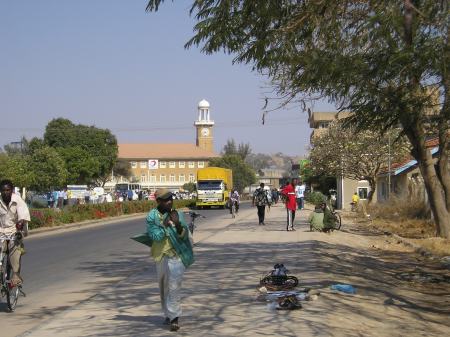
INTI’s participation in the conference was part of our new focus on African New Towns. As part of the program New New Towns: Africa, INTI has begun a series of investigations to explore the planned cities currently under construction across the continent, as well as the legacy of Postcolonial New Towns planned in the 1960s-1970s.
From 3-6 September, the IHS Atelier 3: New Town Development Almere from Urban Management and Development: Sustainable Urbanism will be conducting on-site research in Almere, based at the INTI workspace Making Almere.
Participants in the Atelier will:
- Study the planning process and stages in the development of Almere.
- Analyse the Strength, Weaknesses, Opportunity and Threats found in Almere’s top-down planning.
- Identify and map out the changes in Almere over the last decade in its physical development, identity, social integration and inclusion, housing types and design, infrastructure, amenities, environmental development.
- Identify areas for improvement in Almere and propose innovative solutions.
Number of ECTS: 7.5
Period and Duration: 02 – 27/09/13 (Four weeks)
Coordinators: Ore Fika
Lecturers: Ore Fika, guest lecturers
Key words: New Town Development, Planning, Development, Design
The International New Town Institute will be organizing a workshop about the cultural heritage of Dutch New Towns as part of the conference New Challenges for New Towns (Nieuwe Uitdagingen voor Nieuwe Steden). INTI project manager JaapJan Berg will lead the organization of the workshop.
The Dutch New Towns are facing new challenges today. These challenges include the declining quality of living environments, less dynamic economic growth (compared to other cities with similar size) and a growing group of aging inhabitants. In 2009 the New Towns municipalities, the so-called Ortega-municipalities, started the New Towns Implementation Agenda (Uitvoeringsagenda) with a focus on prevention. The main question on the Implementation Agenda is: How do we prevent the need for large-scale and costly implementations in deteriorating districts?
During the conference New Challenges for New Towns we will show the current position of the Dutch New Towns and the challenges that they face. The question is how do we prepare the Dutch New Towns for the future? Who’s responsibility is it and who are the stakeholders? We will also focus on the power of the citizens and the entrepreneurs of the New Towns.
Click here for more information about the content and program of the Conference.
The conference is organized by Platform31 in collaboration with the municipality of Nieuwegein, the Ministry of Foreign Affairs and Agentschap NL.
The program is free. You can register here.
Podium voor Architectuur organiseert op woensdag 4 september een expertmeeting over sport & architectuur in Haarlemmermeer. Het gebouw als business case, de architectuur in de rol van betekenisgeving en branding, sport en architectuur als lifestyle en motor voor grootschalige ontwikkeling.
Haarlemmermeer werkt aan het honkbalstadion voor De Pioniers in Park 21. Dit stadion zou moeten voldoen aan de EBL-normen om zo mee te doen met de Europese honkbalcompetitie. Het Huis van de Sport, een grootschalig en multifunctioneel sportcomplex, wordt gerealiseerd in 2014 naar een ontwerp van Slangen + Koenis Architecten. Gemeente Haarlemmermeer heeft overwogen met Amsterdam mee te dingen naar de Olympische spelen in 2028.
Drie interactieve lezingen o.l.v. Robert van Riel bieden inzicht in de perspectieven van ontwerpers en beleidsmakers en ruimte aan dialoog met betrokkenen, ontwerpers en gebruikers.
- Thijs van Bijsterveldt en Oana Rades van Shift A+U geven een lezing over hun project voor Unsollicited Architecture en over hun onderzoek Studio Sport. Shift architecture constateert dat de aandacht voor ruimtelijke inpassing van sportmogelijkheden in steden ondergeschikt is. Sportaccommodaties worden vaak verplaatst naar restgebieden en stadsranden. Tegelijkertijd wordt er actief beleid gevoerd waarin sport een meer sociaal-maatschappelijke rol heeft. Shift meent dat sport als aanjager van stedelijke kwaliteit kan fungeren.
- Wim Keijsers, Bureau Nieuwe Gracht, Utrecht. Bureau Nieuwe Gracht heeft samen met Twijnstra Gudde diverse ruimtelijke en planologische verkenningen uitgevoerd voor OS 2028.
- Peter Baas van Slangen + Koenis Architecten presenteert hun programma van eisen en vertaling naar het ontwerp van het Huis van de Sport in Hoofddorp-Zuid.
- Tenslotte duidt architect Mathias Lehner van Lehner en Gunther architecten (oud coördinator van het Podium en tegenwoordig ook verbonden aan de BNA als programma manager BNA International) de verschillende onderwerpen in zijn beschouwing ‘de kracht van vormgeving’ alvorens er plenair mogelijkheid is tot vragenstellen en debat.
Aansluitend is er een mogelijkheid om een rondleiding te krijgen in het in aanbouw zijnde Huis van de Sport in groepjes van vijf. Max. aantal deelnemers: 30, aanmelden via info@podiumarchitectuur.nl
Datum: 4 september 2013 (woensdag) 15:30 tot 18:30
Locatie: Huis van de Sport, Floriande Hoofddorp
Toegangsprijs: gratis
Aanmelden via info@podiumarchitectuur.nl
On September 11, Michelle Provoost presented a lecture on ’New Towns in an Urbanizing World; technology and the city’ at the Agoria Infrastructure Club in Brussels, Belgium. The lecture asked the following questions: What is the role of technology in the planning of new cities, and how can we accomplish a more integral approach to urban planning, infrastructure and the social substance of the city of tomorrow?
On September 23, 2013, Michelle Provoost will lecture at the 8th SUDes International Conference: "Making Urban Places - Hidden Dimensions and New Provocations" at Lund University, Sweden.
The conference is open to the public and will include six distinguished international speakers within the field of Sustainable Urban Design. The topic, Making Urban Places - Hidden Dimensions and New Provocations, invites us to re-think the search for urban form: probing for deeper meanings, exploring different narratives, searching for hidden dimensions, and re-presenting the ephemeral flows of daily life, all in an effort to create a more enriching, meaningful and sustainable urban existence. The conference will be held on September 23, from 8:45 - 17:00 in the Great Hall at Lund University’s School of Architecture.
This lecture & workshop by JaapJan Berg on heritage in Dutch New Towns will be presented at the Amersfoort Rijksdienst voor het Cultureel Erfgoed.
JaapJan Berg will present the research of the International New Town Institute on cultural heritage in New Towns during the conference Meaning and future of our cultural heritage of the post-war period.
Many people do not associate the post-war years directly with cultural heritage. However, the architecture, urban design and monumental art from that period are very characteristic of these years of recovery, optimism and renewal. Now it’s time to think about the future of this heritage. The conference will show the heritage from the period 1940-1965 in a new light.The conference hopes to answer the following questions: what can the heritage of the post-war period mean for future users? What is needed to be able to transform this heritage? What do we do with vacant buildings and their monumental art? How do we deal with the public space and the Green? The conference is part of the Week of the reconstruction.
Click here for more information (in Dutch).
On October 12, 2013, the joint INTI-Crimson exhibition "The Banality of Good" will open in Sao Paulo as part of the Sao Paulo Biennale of Architecture.
UN-Habitat supports countries in developing urban planning methods and systems that address current urbanization challenges. Cities face an enormous backlog of services and housing. There is indeed an urban planning crisis: the unplanned city is largely inefficient and requires increasing resources to make it more functional and livable. Particularly where cities are growing and expected to growth at rates of three and more percent per year, traditional planning frameworks are either proving ineffective in terms of implementation, or producing cities that cannot thrive due to inherent mistakes in the distribution of functions and the lack of urban life. Only those cities able to embrace different patterns of growth, and address inequalities and inefficiencies, will be able to provide better lives for their residents, while limiting ecological damage.
Urban planning frameworks have changed very little in the past 50 years, despite huge changes in the urban world, which is increasingly represented by developing cities and fast-growing centres. The Vancouver Declaration of 2006 provided a new charter for urban planning: 1) promote sustainable development; 2) achieve integrated planning; 3) integrate plans with budgets; 4) plan with partners and stakeholders; 5) meet the subsidiarity principle; 6) promote market responsiveness; 7) ensure access to land; 8) develop appropriate planning tools; 9) be pro-poor and inclusive; and 10) recognize cultural diversity.
From September 16-18, INTI was present at the UN Habitat Expert Group Meeting in Barcelona to discuss the current “urban planning crisis” and search for alternatives. The Expert Group Meeting had a variety of specific goals, including:
- To identify good practices in planned city extensions, detecting key lessons for successful practices.
- To identify innovative methods and tools for urban extensions that can be used in developing countries.
- To identify existing legal frameworks for city extensions and validate them against key UN-Habitat criteria, including planning principles, equity and relevance to capacity and resource-poor settings.
- To explore the relative strengths and weaknesses of land readjustment (reparcellation) as compared to other land management approaches for city extension engaging with practitioners and beneficiaries.
- To identify participation benchmarks and mechanisms that emphasize consistent engagement and the recognition of community diversity.
- To identify the relevance of concepts of an inclusive city, such as “a city that values all people and their needs equally”.
- To review and validate UN-Habitat’s position and establish a general reference on the same.
- To build a network for collaboration with urban practitioners and thinkers engaged on planned city extensions.
After two days of intensive group work, presentations and debate, the Expert Group was able to agree on a communiqué laying out a specific planning paradigm that gives city-builders a set of concrete tools and guidelines to follow. The document is now being finalized by UN Habitat and should be published in the coming weeks. INTI was proud to be part of this impressive group, and we are looking forward to seeing the results of everyone’s collective efforts.
On September 5, 2013 INTI’s director Michelle Provoost gave a lecture at the KTH School of Architecture in Stockholm. The lecture was part of a Master’s Level orientation course of the KTH, which consists of a series of events, seminars and workshops on the infrastructure development of the Stockholm region, with invited guests, international experts and representatives from local stakeholders.
The seminars consisted of a series of thematically focused lectures that discussed future infrastructure and urban development from diverse perspectives and scales. Each day consisted of three to four lectures: by local stakeholders and two invited international guests. The results of the course and the workshops will be featured in the exhibition Stockholm on the Move. The opening of Stockholm on the Move is on October 25, 2012.
Stockholm on the Move is an initiative by Färgfabriken and the Royal Institute of Technology in Stockholm, developed in conjunction with a range of partners with important roles for the infrastructure of the Stockholm region. An exhibition, with associated workshops and a seminar program, will be shown at Färgfabriken between November 22, 2012 and March 24, 2013.
On Wednesday November 27, the municipality of Almere is organizing the conference “Who makes the city of Almere?” The conference will provide a platform for discussion and debate around Prof. Arnold Reijndorp and Stefan Metaal’s research on the strengths and weaknesses of the lower middle class in Almere. The research will be published by the International New Town Institute in November with the title Kwetsbare middenklasse?. (sorry, in Dutch only).
The conference will address the questions:
– Who is the lower middle class in Almere?
– Are they as vulnerable as they seem to be?
– How do they feel about the municipality?
– How can their local powers be put to use?
Speakers are:
– Arnold Reijndorp – Urban sociologist
– Beitske Boonstra – researcher at TNO
– Nico de Boer – researcher, writer and thinker
– Moderator Stephan Steinmetz – advisor and policymaker
You can sign up by sending an email to ifhasnoe@almere.nl. You will receive a confirmation.
Michelle Provoost (dir. INTI) and Wouter Vanstiphout (Design as Politics, TU Delft) gave a lecture in New Town Alphaville (near Sao Paulo) on November 7th. The lecture was part of the event ‘Expo Cidades Milhores; Barueri 2014’, the kick-off meeting of a multi year project to rethink and improve the economy, culture and liveability in the city of Barueri of which Alphaville is part.
Alphaville can be considered a forerunner of the many privately developed new cities that pop up around the world nowadays. In the seventies, Alphaville was part of the attempts of the empoverished city of Barueri to improve the economy of the city by giving tax incentives to international companies. To provide attractive housing, the developer Alphaville Urbanismo built Alphaville 1, a luxury gated community modelled along the lines of American suburbs. The concept proved highly popular and was repeated not only in Alphaville 2-12, but was also widely copied throughout Brazil.
Now, after 40 years, Alphaville has reached the next phase in its life cycle and needs to develop a new view on its development, its relation with its ‘mother town’ Barueri and the region in general. The spatial segregation of which Alphaville has become the symbol, and its focus on high end family housing need to be reconsidered if Alphaville wants to become a viable and resilient city for the next 40 years.
The Expo wants to adress all these issues by starting a Research Centre, in which scholars will focus on the culture and economy of Alphaville, with the aim of proving insights and knowledge as well as coming up with proposals for improvement: an endeavour which INTI gladly supports.
The São Paulo Architectural Biennale with the central theme City: How to make, how to use was officially opened in October 2013. Crimson Architectural Historians together with The New Institute organised several debates, titled ‘Track Changes’. The basis for these discussions was the exhibition ‘The Banality of Good. Six Decades of New Towns, Architects, Money and Politics’ (co-curated by INTI), which was first shown in Venice (2012) and London (2013) and will be on show at the Danish Architecture Centre (DAC) in January 2014.
‘Track Changes’: In three days of public meetings a generation of architects and urbanists were gathered together that is connected through a common reaction to the political and economic crises that urban communities all over the world are facing. Whether working in the Favelas of South America, the Townships of South Africa or in the crumbling housing estates of Europe, this generation has replaced the large-scale top down masterplan and the iconic hypermodern building with the participative, bottom-up, temporary and flexible approach.
What does this global convergence of design attitudes mean? Are we really seeing an international shift that explains the shared values of our generation? Or is the consensus about participation and bottom-up just a fashion?
Three themes were discussed: ‘We the People’, ‘Bottom up is not Enough’ and What’s your Crisis? Projects and experiences from all over the world were shared, and a central role was given to the urban and political transformations the host city São Paulo is going through. The most important ambition was to take architecture and urbanism out of the ghettoes of academia and the black boxes of politics and business, and to put it back into the centre of public debate. Apart from the website, a documentary and a publication will be prepared, due beginning 2014.
Start van de community.
‘De Vinexmensen’ is een van de drie communities die in het kader van het Jaar van de Ruimte 2015 is opgericht. Deze community richt zich op de Vinexwijken die in het kader van de Vierde Nota Extra zijn ontstaan. In 2015 vieren ze hun 25-jarige verjaardag.
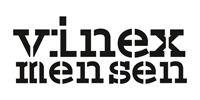
De community is een netwerk van geïnteresseerde personen en instanties, bewoners en ontwerpers, steden en wijken, die zich buigen over wat de Vinex op dit moment is en wat het in de toekomst kan worden.
Met behulp van de community worden inzichten verkregen over het type stadscultuur dat inmiddels in de Vinex is ontstaan, over welke mensen er wonen en werken en hoe de (sub)urbane stedelijkheid van de Vinex vorm heeft gekregen. Daarnaast wil ‘De Vinexmensen’ ideeën genereren over het toekomstperspectief voor deze wijken en hoe ze zich verder kunnen ontwikkelen.
Tijdens het Jaar van de Ruimte zullen de leden van de community activiteiten organiseren en uiteindelijk met adviezen komen over de toekomst van de Vinex.
Relevantie
De Vinex is symbool geworden van een cultuur van ruimtelijk ordenen die definitief tot het verleden behoort. De wijken zijn het resultaat van denken en financieren, van instituties en structuren die ingrijpend zijn veranderd. De Vinex kan daarmee beschouwd worden als een van de (voorlopig) laatste, grote top-down georganiseerde opgaven in de ruimtelijke ordening.
Inmiddels is dit top-down denken ingeruild voor een anders georiënteerde beweging en ‘geloofsovertuiging’: de bottom-up gedachte en het vertrouwen in de kracht van ‘sociaal kapitaal’ en zelforganisatie. Bij veel toekomstige ontwikkelingen zal de richting, vorm en het succes van nieuwe (her-) inrichtingsprocessen afhankelijk zijn van een brede basis, de mensen en hun meningen, inzet en inspiratie. Zo ook bij de Vinex.
Toekomstige opgaven
De community is een manier om de visies en ambities van bewoners, bestuurders en gebruikers, ‘De Vinexmensen’, goed in beeld te krijgen. Door middel van de community worden antwoorden gegeneerd op de vraag wat er met de VINEX, die intussen een zekere mate van stedelijkheid heeft gekregen, moet gebeuren. Op basis van een registratie en het in kaart brengen van de huidige stadscultuur zal vervolgens geformuleerd worden wat de toekomstige opgaven zijn.
Daarbij spelen de fysieke kenmerken van de plek een rol van betekenis, maar het zijn toch vooral de meningen, visies en ambities van bewoners en gebruikers van de Vinex waar de aandacht naar uitgaat. De community heeft daarmee drie taken: reflectie op de totstandkoming van de Vinexsteden, registratie van de huidige situatie en het formuleren van toekomstige opgaven.
Aanmelden
De start van de community begint met een open uitnodiging. Geïnteresseerden kunnen zich aanmelden bij de projectleider. De community zal zich ontwikkelen volgens een geleidelijk groeiproces langs lijnen die door de deelnemers worden ingezet.
Aan het eind van het Jaar van de Ruimte, december 2015, zal ‘De Vinexmensen’ resulteren in een presentatie van conclusies en toekomstvisies voor de VINEX.
De community ‘De Vinexmensen’ wordt geregisseerd en geleid door INTI (International New Town Institute) in opdracht van het Ministerie I & M.
Voor meer informatie of vragen:
JaapJan Berg (INTI), projectleider community ‘De Vinexmensen’
vinexmensen@newtowninstitute.org
Twitter: @vinexmensen

The Dutch-South-African teams of the Density Syndicate are presently finalizing their designs for three locations in Cape Town. They will be presented at the exhibition “City Desired”, organized by the African Centre for Cities (ACC) in the City Hall in Cape Town. The exhibition will offer Cape Town residents and visitors insights into the challenges and possibilities facing this unique city: dynamics that echo in cities across the world. This exhibition appears against the backdrop of the World Design Capital (WDC) program, with its focus on “Live Design, Transform Life.”
The Density Syndicate uses the concept of density to tackle the many divides and challenges that currently face Cape Town. With the legacy of apartheid etched deep into every neighbourhood, particularly in the sharp separation between the neighbourhoods, the question in Cape Town today is: how can city planning contribute to a sea change in this reality that it first helped to create? How can the infinite sprawl of the segregated city be unified, opened up, woven into a coherent tapestry?
In an intensive process, working within multidisciplinary teams and in close collaboration with residents and interest groups, the teams are presenting ideas and alternative strategies to deal with the incremental growth of the informal settlements, the creation of green, collective space and in general, overcoming boundaries and barriers in the broadest sense of the word.
The Density Syndicate is a program organized by the International New Town Institute in collaboration with the African Centre for Cities.
The International New Town Institute (INTI) has the pleasure of inviting you to the conference “Shenzhen: From Factory of the World to World City”. For the first time, the results of INTI’s international research program will be presented to a Dutch professional audience. The event will be a crash course for anyone working or interested in Shenzhen and other Chinese cities.
The spectacular story of Shenzhen is well-known: lying adjacent to Hong Kong in the Pearl River Delta, the former fishing village became a New Town in 1980 when the central Chinese government gave it the status of Special Economic Zone. Shenzhen soon became a metropolis and a prototype for both economic and urban reform within China. Shenzhen is a city that has been raising eyebrows for years, because of its fast development and exceptional position.
However, the everyday reality in Shenzhen can be unruly. As a city, Shenzhen mainly thinks in top-down strategies and simply adds new hardware – the sum of infrastructure, buildings and industries – in order to encourage urban and therefore economic growth. It hardly touches upon the question of which existing social dynamics need to be accepted or improved in order to strengthen the city’s potential, let alone the socio-economic conditions that are necessary to successfully regenerate an existing neighborhood or to sustainably extend the city. This means that many policies are not in line with reality, creating a gap between government and society. Shenzhen is currently rethinking its economic future and urban identity. INTI aligned with the innovative forces in Shenzhen and initiated research to understand which social, economic and environmental factors need to be improved to strengthen the city’s potential.
This conference will discuss the major constraints in the current urban planning process in Shenzhen, from which alternative trajectories will be drawn. By exploring new stakeholders, new social and economic values, alternative strategies for redevelopment, and future challenges for the “city of tomorrow” within the Pearl River Delta, “Shenzhen: From Factory of the World to World City” will provide both a detailed overview of Shenzhen’s current planning issues and illustrate viable solutions. The day’s discussions will conclude with possible approaches for international collaboration.
PROGRAM
| 09:00 – 09:30 | Welcome, coffee and tea |
| WORD OF WELCOME | |
| 09:30 – 09:35 | Word of Welcome by Annemarie Jorritsma (Mayor City of Almere) |
| 09:35 – 09:40 | Word of Welcome by Michelle Provoost (Director INTI) |
| SESSION 1 | SINO-DUTCH COLLABORATION |
| 09:40 – 10:00 | Lecture by Linda Vlassenrood (Program Director INTI) |
| 10:00 – 10:15 | Lecture by Simone Eijsink (Head of European and International Affairs at the City of Almere) |
| 10:15 – 10:30 | Lecture by Han Feenstra (Senior Policy Advisor at the Ministry of Economic Affairs) |
| 10:30 – 11:00 | BREAK |
| SESSION 2 | TOP DOWN MEETS BOTTOM UP |
| 11:00 – 11:20 | Lecture by Huang Weiwen (Director Shenzhen Center for Design and Deputy Chief Planner, Urban Planning and Land Resource Commission of Shenzhen Municipality) |
| 11:20 – 11:40 | Lecture by Juan Du (Associate Professor and Associate Dean of the Faculty of Architecture at the University of Hong Kong) |
| 11:40 – 12:00 | Lecture by Stephen Read (Associate Professor, Spatial Planning and Strategy, Faculty of Architecture at the Delft University of Technology) |
| 12:00 – 12:30 | Discussion with Huang Weiwen, Juan Du, Stephen Read and Kees Christiaanse (Founder KCAP Architects and Planners) |
| 12:30 – 13:30 | LUNCH |
| SESSION 3 | NEW VALUES |
| 13:30 – 13:50 | Lecture by Mary Ann O’Donnell (Shenzhen Based Artist-Ethnographer) |
| 13:50 – 14:10 | Lecture by Tat Lam (Adjunct Assistant Professor, School of Architecture, Chinese University of Hong Kong and Director Urbanus Research Bureau) |
| 14:10 – 14:30 | Lecture by Markus Appenzeller (Director and Partner MLA+) |
| 14:30 – 15:00 | Discussion with Mary Ann O’Donnell, Tat Lam, Markus Appenzeller and Ton Venhoeven (Founder Venhoeven CS architecture+urbanism and consultant Chinese Ministry of Housing and Urban-Rural Development, and the World Bank in China) |
| 15:00 – 15:30 | BREAK |
| SESSION 4 | CITY OF TOMORROW |
| 15:30 – 15:50 | Lecture by Doreen Liu (Adjunct Associate Professor, School of Architecture, Chinese University of Hong Kong and Founder NODE Architecture & Urbanism) |
| 15:50 – 16:10 | Lecture by Ronald Wall (Economic Geographer at the Institute for Housing and Urban Development Studies) / Tiffany Tsui (PhD Candidate at the Institute for Housing and Urban Development Studies) |
| 16:10 – 16:30 | Lecture by Arnold Reijndorp (Professor of Social-economic and Spatial Development of New Urban Areas, Centre for Urban Studies at the University of Amsterdam) |
| 16:30 – 17:00 | Discussion with Doreen Liu, Ronald Wall / Tiffany Tsui, Arnold Reijndorp and Bert Smolders (Senior Consultant Urban Development and Program Manager at ARCADIS, Advisor to the City of Wuhan) |
| 17:00 – 17:30 | CONCLUSIONS |
| 17:30 – 19:00 | DRINKS |
SHENZHEN - ALMERE
Because of her strong personal involvement in the buildup of relations between Almere and Shenzhen, Mayor Annemarie Jorritsma will open the conference. An important result of INTI’s program is the cooperation between Shenzhen and Almere in the field of sustainable urban development, which makes Shenzhen automatically part of Almere’s international “Growing Green Cities” network.
PARTNERS
Main partners within the program in Shenzhen are the Chinese University of Hong Kong, China Development Institute, Shenzhen Center for Design, Urbanus, NODE, City of Almere, Delft University of Technology, University of Amsterdam, CAH Almere and Institute for Housing and Urban Development Studies (IHS).
The conference has been made possible by the generous support of the City of Almere, Creative Industries Fund NL and the Ministry of Economic Affairs.
PRACTICAL INFORMATION
Date: 12 December 2014
Time: 9.30 – 17.30
Location: Schouwburg Almere, Esplanade 10, The Netherlands
Language: English
Entrance (including lunch and drinks): € 35,00 / Students € 5,00
You can buy your ticket directly at the website of Schouwburg Almere
Conference “Shenzhen: From Factory of the World to World City”
Date: 12 December 2014
Time: 9.30 – 17.30
Location: Schouwburg Almere, Esplanade 10, The Netherlands
Language: English
Entrance (including lunch and drinks): € 35,00 / Students € 5,00
You can buy your ticket directly at the website of Schouwburg Almere
SPEAKERS
– Markus Appenzeller (Director and Partner MLA+)
– Juan Du (Associate Professor and Associate Dean of the Faculty of Architecture at the University of Hong Kong)
– Simone Eijsink (Head of European and International Affairs at the City of Almere)
– Han Feenstra (Senior Policy Advisor at the Ministry of Economic Affairs)
– Weiwen Huang (Director Shenzhen Center for Design and Deputy Chief Planner, Urban Planning and Land Resource Commission of Shenzhen Municipality)
– Tat Lam (Adjunct Assistant Professor, School of Architecture, Chinese University of Hong Kong and Director Urbanus Research Bureau)
– Doreen Liu (Adjunct Associate Professor, School of Architecture, Chinese University of Hong Kong and Founder NODE Architecture & Urbanism)
– Mary Ann O’Donnell (Shenzhen Based Artist-Ethnographer)
– Stephen Read (Associate Professor, Spatial Planning and Strategy, Faculty of Architecture at the Delft University of Technology)
– Arnold Reijndorp (Professor of Social-economic and Spatial Development of New Urban Areas, Centre for Urban Studies at the University of Amsterdam)
– Linda Vlassenrood (Program Director INTI)
– Ronald Wall (Economic Geographer at the Institute for Housing and Urban Development Studies) / Tiffany Tsui (PhD Candidate at the Institute for Housing and Urban Development Studies)
– Christine de Baan and JaapJan Berg (INTI) will moderate the conference.
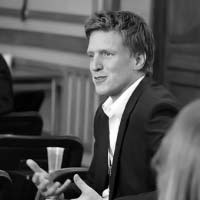
Markus Appenzeller
Markus Appenzeller is an urban planner and architect educated in Germany and the US. With his practice MLA+, with offices in London, Rotterdam, Rio de Janeiro, St. Petersburg and Shanghai, he is involved in large scale planning projects as well as architecture commissions in Europe, Asia and South America. Previously also working for renowned firms KCAP and OMA, he has been and still is involved in many high profile projects including the Olympic Legacy Masterplan in London, urban development projects in Russia, and architecture and planning projects in China. Markus Appenzeller is also active as a lecturer and educator – currently curating the multidisciplinary master course ‘Design of Urban Ecosystems’ at ITMO University in St. Petersburg. MLA+ is actively involved in more than six architecture and urban planning projects in Shenzhen. Here the company’s focus is on urban regeneration and establishing more inclusive, more quality-minded design and implementation processes. MLA+ has been collaborating with a number of Shenzhen based firms over long periods of time and together with them has been embarking on developing methods and tools of improving the quality of urban development in ‘the world’s biggest new town’.
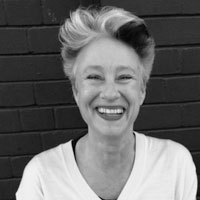
Christine de Baan
With a background in architecture and design, Christine de Baan (DEBAAN, Rotterdam, The Netherlands) works as advisor, curator, and editor, and is a frequent lecturer and moderator. Recently she was Program Director of the Department of Design for Cape Town World Design Capital 2014, and advisor for the Dutch participation in Beijing Design Week. Earlier, De Baan was executive director of the four-year strategic internationalization program ‘Dutch Design Fashion Architecture’ in China, India, and Turkey, funded by the Dutch ministries for Culture, Economy and Foreign Affairs, Head of Program for the International Architecture Biennale Rotterdam, and curator for the Visual Culture part of the China Contemporary exhibition in Rotterdam, 2006. She chaired the main advisory board of the national Dutch arts fund and often acts as consultant to national and municipal governments on design policy and education.
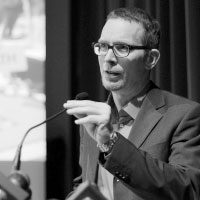
JaapJan Berg
JaapJan Berg (1965) is an independent researcher, journalist and moderator in the field of architecture and spatial planning. He is owner of Bergplaats. JaapJan Berg works as a project manager and researcher for INTI. Until 2015, he is also project leader of the community ‘De Vinexmensen’, one of three communities that operate within the overall program of the Dutch manifestation Jaar van de Ruimte 2015. JaapJan Berg publishes regularly in various (international) professional periodicals and regularly acts as chair of debates and discussions on architecture and spatial planning. Previously JaapJan Berg worked as a curator at the Netherlands Architecture Institute (NAI) and was senior coordinator at the architectural center of Almere (CASLa). JaapJan Berg studied art history at the University of Amsterdam (UvA).

Kees Christiaanse
Kees Christiaanse studied architecture and urban planning at Delft University of Technology. In 1980 he joined the Office for Metropolitan Architecture (OMA) and was appointed partner in 1983. In 1989 he founded his own company, now KCAP Architects&Planners, in Rotterdam. Throughout his career Kees Christiaanse has always combined teaching and research with his professional work within KCAP, which has generated fruitful cross-fertilizations. Since 2003 he is head of the Chair for Architecture and Urban Design at the Swiss Federal Institute of Technology (ETH) in Zurich. In 2009 Kees Christiaanse was curator of the 4th International Architecture Biennale Rotterdam (IABR) with the title “Open City. Designing Coexistence”. Since 2010 he is program leader of the Future Cities Laboratory (FCL) in Singapore. Next to his work as an architect, Kees Christiaanse focuses on urban assignments in complex situations and on guiding urban processes. He is an expert in the development of the revitalization of former industrial, railway and harbor areas, which is illustrated by KCAP’s work in the docklands of Rotterdam, Amsterdam, Hamburg and London. He is a member of various urban Advisory Boards in Zurich, Dublin, London, Hamburg, Geneva and the World Business Council for Sustainable Development. In early 2013 he was appointed Chairperson of the External Advisory Board of the Architecture and Design Department of the Singapore University of Technology and Design.

Juan Du
Juan Du is Associate Professor and Associate Dean of the Faculty of Architecture at the University of Hong Kong. She also leads IDU_architecture, a research and design office with projects ranging from the extent of built forms to the social and ecological processes of the city. Juan Du has worked extensively in practice in the US, Europe and China. She has taught in the Department of Architecture at Massachusetts Institute of Technology and the Graduate Center of Architecture at Peking University. Juan Du’s work has been exhibited internationally including the 11th and 12th Venice Architecture Biennale, the Vienna Architekturzentrum Exhibition, and the Brazil International Exhibition of Architecture and Urbanism. Her design, research and writing on emergent urbanisms of the developing contemporary city have been published internationally, including China Voices, Urban Trans Formations, Domus, Urban China, and Journal of Architectural Education. Juan Du was the Chief Curator of Hong Kong’s Exhibition in the 2010 Venice Architecture Biennale, and Curator of Housing an Affordable City Exhibition at the 2011 Shenzhen Hong Kong Biennale. She is currently working on a book focused on the extended urban history of Shenzhen and the role of the city’s informal urbanism.
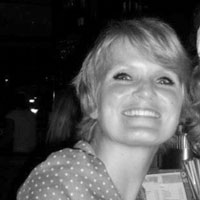
Simone Eijsink
Simone Eijsink is, as Head of the International Department, responsible for all the international governmental activities in and for Almere. With the upcoming 2022 World Expo on Horticulture Floriade, the international contacts are growing, as a new international network on Growing Green Cities is being developed with cities like Shenzhen, Taipei, Milan and Toronto.
Prior to her position in Almere, Simone Eijsink worked for the Peace Palace in The Hague, the Ministry of Foreign Affairs, the International Institute of International Relations ‘Clingendael’ and the European Headquarters of the Japanese company Epson, on corporate social responsibility. Her scientific background is in international public law and human rights law, for which she received two master titles, from the Universities of Maastricht and Utrecht. For both universities, she wrote several publications on international human rights protection in international relations.
She lived abroad in Sweden and Vienna, as part of the research program of the International Institute of Applied Systems Analysis (IIASA).
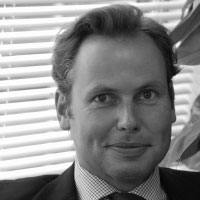
Han Feenstra
Han Feenstra (1966) is senior policy advisor at the Energy Market Department, Directorate-General for Energy, Telecommunications and Competition, Ministry of Economic Affairs since 2009. He is mainly involved in gas policy and international energy relations. He graduated as Sinologist from the University of Leiden and worked at the Netherlands Trade & Investment Office in Taipei from 1995 to 2000. In 2000 he joined the Ministry of Economic Affairs in The Hague, at the headquarters of the Netherlands Foreign Investment Agency (NFIA). From 2004 to 2009 he was Executive Director for the NFIA in China, based at the Netherlands’s consulate in Shanghai.
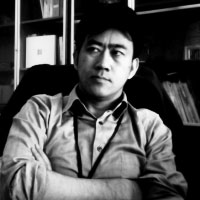
Weiwen Huang
Weiwen Huang is the ex-Vice Chief Urban Planner of the Urban Planning & Land Resource Commission of Shenzhen Municipality, and the Director of the Shenzhen Center for Design. He is Loeb Fellow of the Graduate School of Design, Harvard University, and is director of the Urbanism\Architecture Bi-city Biennale of Shenzhen. Weiwen Huang keeps exploring and reforming urban planning and design in Shenzhen. He continually seeks to establish new regulations for fair and open design competitions in his city. As a civil servant, he maintains an independent research program, and writes articles criticizing automobile-oriented and super-scale space design, attaching greater importance to public space, green transportation, and public participation in urban planning. In recent years, he has lead a research team working on a new development model for the new town, such as MGC (multiple ground city) and SLID (super low impact development). He pushes UABB and SCD as platforms for exchange and communication about urbanism and built environment, especially in regard to the urban village, urban renewal and regeneration, land damage; these issues are the real challenges of his city, Shenzhen. After the 2008 Sichuan earthquake, he initiated the first NGO by architects in China, named Re-Tumu, to provide design for the disaster-stricken or rural area. INTI and SCD have been collaborating extensively in Guangming New Town, Shenzhen.
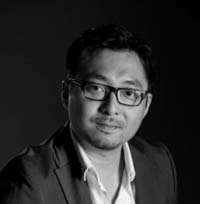
Tat Lam
Dr. Tat Lam, expert about China’s developmental issues, is the CEO of Shanzhai City, a social enterprise based in Hong Kong and Shenzhen for impact-oriented urban innovation projects in Asian emergent cities. Since 2010, Tat Lam directed a team of 30 researchers and urban designers under Urbanus Research Bureau (URB) in Hong Kong and Shenzhen, consulting private and government entities on large-scale developments. URB completed 50 urban design projects in 5 years, with clients such as Shenzhen Urban Planning Commission, Vanke Group, Poly Real Estate Development, and Beijing East District Government. Tat Lam developed urban anthropological research methods on architecture and urban studies during his doctoral degree at UCL (London) and his fellowship at Columbia University ChinaLab (New York) and applied for his urban consultancy practice in China. Tat Lam, as research scholar at China Megacities Lab at Columbia University and adjunct assistant professor at Architecture School at CUHK, is also closely connected with international academic resources. Most recently Tat Lam was executive curator of the Hong Kong Shenzhen Bi-city Biennale of Architecture and Urbanism in 2013. Tat Lam has participated in the New New Towns program ever since its start in 2012.
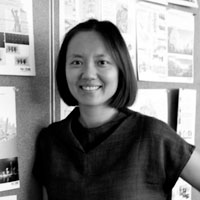
Doreen Liu
Doreen Heng LIU received her MArch from UC Berkeley and Doctor of Design at Harvard Graduate School of Design. Her research focuses on contemporary urbanism and architecture in the Pearl River Delta, and the specific impact of urbanization on design and practice in China today. She established her own design practice NODE (Nansha Original Design) in Hong Kong and Nansha, Guangzhou in 2004, and is also chief architectural consultant for the Fok Ying Tung Foundation for the Nansha City development. Her built architectural works include the Value factory – Main Entrance & Warehouse renovation – Venue A in 2013 Shenzhen/Hong Kong Urbanism/Architectural Bi-city Biennial. Her design works have been widely published in many international & domestic professional magazines including Architectural Record and Domus. She and her office also participated in various architectural and art exhibitions. Since September 2008, she has been teaching at the School of Architecture of the Chinese University of Hong Kong, and was appointed Adjunct Associate Professor in 2011. In 2014, Doreen Liu was one of the curators for the Hong Kong Pavilion at the International Architecture Biennale in Venice. Doreen Liu has participated in the New New Towns program ever since its start in 2012.

Mary Ann O’Donnell
An anthropologist by training, Mary Ann O’Donnell has conducted ethnographic research in Shenzhen since 1995, aiming to make legible the shifting cultural landscapes of China’s flagship Special Economic Zone. Interests and interventions include Handshake 302, a collectively run art space in Baishizhou; Shenzhen Noted, a blog that theorizes post socialist urbanization in Shenzhen; and ongoing collaboration with Fat Bird Theatre, Shenzhen. Her research has been published in TDR: The Drama Review, positions: East Asian cultures critique, and Cultural Studies Special Issue on Hong Kong. O’Donnell is an editor at Architectural Worlds (Shenzhen University) and the Director of the Urban Village Special Forces, a citizen group that aims to bring Shenzhen’s urbanized villages into public discussions about urban planning and renewal projects.
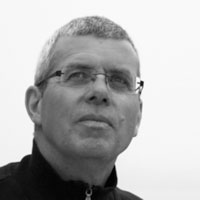
Stephen Read
Stephen Read is a teacher and researcher at the Department of Urbanism of Delft University of Technology. His subject is the forms of cities, but he is interested also in urban change and the forms urban economies, cultures and societies might take and the forms of development that produce these. He has been working with the INTI led Shenzhen Scenarios research project led by Qu Lei at Delft for the last three years and is involved in a separate three year secondment to the University of Hong Kong (funded by UKNA), working on a project called Paths of urbanisation in Shenzhen New Town: Exploring emerging forms of polity, community and economy.
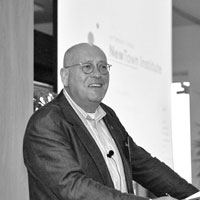
Arnold Reijndorp
Arnold Reijndorp (1948) studied architecture at Delft University of Technology. After graduation he worked for the town-planning department of the city of Rotterdam and was responsible for the urban renewal operation in the Old-West district of the city. A growing interest in the social and cultural developments in cities brought him to the sociology department of the University of Amsterdam. As an independent researcher and university lecturer he tried to bridge the gap between urban practice and academic discourse. From 1998 – 2000 he was visiting professor Urban Sociology and Urbanism at the Faculty of Architecture of the TU-Berlin. He lectured at universities and schools of architecture in The Netherlands and abroad. Since 2006 he holds the Han Lammers chair of Socio-economic and spatial developments of new urban areas at the Department of Geography, Planning and International Development Studies of the University of Amsterdam. Arnold Reijndorp has participated in the New New Towns program ever since its start in 2012.
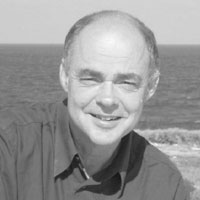
Bert Smolders
As senior consultant urban development Bert Smolders has been involved in urban projects for ARCADIS in China since 2002. He worked on a large number of projects in Wuhan, was appointed advisor to the Wuhan municipality planning office and given the Yellow Crane Tower Friendship Award by the Mayor of Wuhan. Through ARCADIS subsidiary RTKL in Shanghai he worked on urban development projects all over China focusing on the relation between water management and urban planning. In addition to his work in urban development in China, he is program manager for the Shelter program, the partnership between UN-Habitat and ARCADIS, a CSR program. In the Shelter program, ARCADIS provides pro-bono expertise for over 50 UN-Habitat projects all over the world, with examples such as the preparation of a master plan for the redevelopment of Tacloban Philippines after typhoon Haiyan, disaster risk reduction in urban planning in Rwanda, and integrated coastal planning and management in Costa Rica.

Tiffany S.W. Tsui
Tiffany Tsui has over 15 years of international experience in sustainable urban and regional development as strategic planner and project director. From 2001 to 2005, she was the director of the China operation of EMSI, the first international firm providing green building design & consultancy services in China. She successfully introduced the concept of “green buildings” and the LEED green building certification to leading Chinese real estate developers and companies. She managed the very first green building projects that are LEED certified across China, which serves as a model for more companies to ‘go green’. She joined the Royal HaskoningDHV Group(former DHV group) in 2005, and led the effort to develop integrated planning and design solutions and innovative business models for sustainable regional and eco-city developments in China. Her main focus includes delta development, water management, eco-city development and metropolitan food security. Under her leadership, DHV has provided strategic planning and design services for projects including the Caofeidian Eco-city development, Zhongshan Coastal New City and Nansha New City. She is currently pursuing her PhD at the Erasmus University in the field of economic geography.
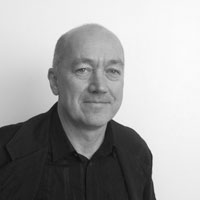
Ton Venhoeven
Ton Venhoeven is founder of VenhoevenCS architecture+urbanism, an innovative Dutch design office for sustainable, integrated and smart architecture, urban development and infrastructure. Besides his work as an architect and urban planner, Venhoeven advises on Smart City, Micro City and Healthy City, integrated planning, multimodal mobility networks and transit-oriented development (TOD). He is the former Dutch Chief Government Advisor on Infrastructure and the City. Currently he works as a consultant for various international public and private organizations, such as the Chinese Ministry of Housing and Urban-Rural Development, the World Bank in China and the European Network for Urban Vitality. Ton Venhoeven is also program leader of the multi-annual program Towards2050: Developing a Sino-Dutch Approach towards Sustainable Urbanization.
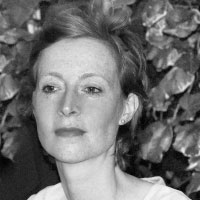
Linda Vlassenrood
Linda Vlassenrood is Program Director at INTI, where she set up the international research program New New Towns. Why we need to rethink the city of tomorrow today. The New New Towns program is dedicated to improving the urban and social quality of eight exceptional New Towns. Linda Vlassenrood has been working in Shenzhen (China) and Chandigarh (India) since 2011. These cities are experiencing fast urbanization and they face major urban planning issues. New New Towns serves a unique role in bringing together international and local expertise in a multidisciplinary think-tank. It is a catalyst for the exchange of knowledge between students, researchers, design professionals, developers, policymakers and politicians. This is done through student workshops, international design workshops, conferences and exhibitions. Linda Vlassenrood worked as a curator at the Netherlands Architecture Institute from 2000, serving as chief curator from 2008 to 2011. Her department worked successfully on a rich and diverse program of exhibitions, lectures and debates, events and educational programs for professionals as well as broader audiences. Linda Vlassenrood has curated a significant number of noteworthy exhibitions and events on architecture in its broadest sense. With China Contemporary she placed Chinese architecture on the international map in 2006.
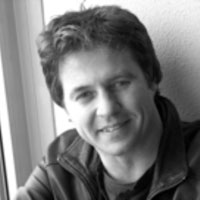
Ronald Wall
Ronald Wall is an economic geographer and urban planner, and has worked for renowned urban planning offices (such as OMA and MVRDV), governmental organizations (such as Dutch Ministry of Economic Affairs and UN-Habitat) and academic institutions (such as STRELKA and Berlage Institute). He is head of the economic geography (UCR) department at the IHS / Erasmus University Rotterdam, The Netherlands. He specializes in socio-economic research and how this is related to urban development. Ronald Wall has worked on projects in Africa, The Middle East, Asia, Latin America, and Europe. Over the past 15 years, the central focus of his work has been the development of resilient urban planning, based on interdisciplinary collaboration and by understanding the local, regional and global network characteristics of cities. Ronald Wall has worked with international architects, scientists, policymakers and academics - and has won various architectural prizes, been awarded several research grants and published in leading scientific journals. Ronald Wall teaches at urban planning and economics schools. Ronald Wall has participated in the New New Towns program ever since its start in 2012.
More about the Conference “Shenzhen: From Factory of the World to World City”
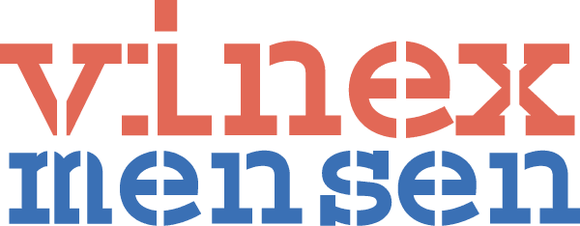
Wie zijn De Vinexmensen?
Via deze maandelijkse nieuwsbrief willen we u op de hoogte houden van de vorderingen van De Vinexmensen. Wij zijn een van de drie communities van het Jaar van de Ruimte, dat op 15 januari van start is gegaan.
De Vinexmensen wil weten hoe de Vinexwijken er, 25 jaar na het verschijnen van de Vierde Nota Extra, voor staan, maar kijkt ook vooruit: hoe ziet de toekomst van de Vinex eruit, en hoe gaan we die vormgeven?
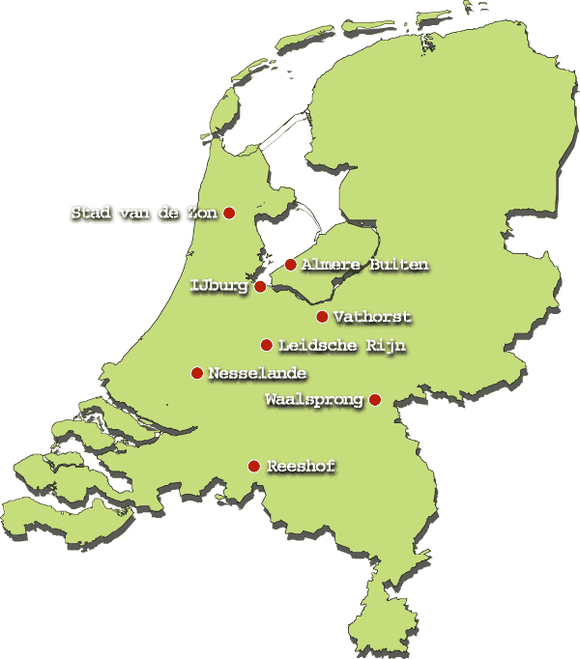
In De Vinexmensen komen de stem van de gebruikers, het vertrouwen in bottom-up en de vraag naar de toekomst van de Vinex samen. Door middel van onderzoek, discussiebijeenkomsten en journalistieke projecten genereren we antwoorden op de vragen hoe de vijfentwintig jaar oude Vinex ervoor staat, en wat de opgaven voor de toekomst zijn.
We zoomen specifiek in op acht wijken: Leidsche Rijn (Utrecht), Vathorst (Amersfoort), Stad van de Zon (Heerhugowaard), Reeshof (Tilburg), de Waalsprong (Nijmegen), Nesselande (Rotterdam), IJburg (Amsterdam) en Almere-Buiten.
Start van het Jaar van de Ruimte
Op 15 januari was de aftrap van het Jaar van de Ruimte in de Beurs van Berlage te Amsterdam. De Vinexmensen maakt als een van drie communities deel uit van dit jaar. Aan het begin van de middag werden we toegesproken door Minister Schultz van Haegen, Maarten Hajer, Neelie Kroes en Hans Alders. Daarna trokken we ons terug in deelsessies.
De zaal van De Vinexmensen zat bomvol. In aanwezigheid van bewoners, beleidsmakers, stedenbouwkundigen en onderzoekers discussieerden we over de prikkelende vraag: Hoort de Vinex bij de stad, of is de stad een bedreiging voor de Vinexwijk? Meteen bleek dat Vinexwijken onderling nogal verschillen. Zo doet Leidsche Rijn zijn best de afstand tot Utrecht te overbruggen, maar positioneert Vathorst zich als een dorp, los van Amersfoort.
De negatieve connotatie die het woord Vinex oproept kwam ook ter sprake, en de vraag of wonen in een Vinexwijk een tweede keus is. Het laatste woord in deze discussie kwam van een jonge stedenbouwkundige die is opgegroeid in de Reeshof in Tilburg. ‘Toen ik twee jaar was verhuisden we vanuit een bloemkoolwijk naar de Reeshof. Mijn ouders wonen er nog steeds en zijn inmiddels al drie keer verhuisd. Ze zijn daar hartstikke gelukkig,’ zei hij.
Onderzoek
Vanaf februari zullen onderzoekers, studenten van de Universiteit Utrecht en de Universiteit van Amsterdam de Vinexwijken in trekken. Zij gaan onderzoek doen in de traditie van stadssocioloog Herbert Gans, die bekendheid verwierf met zijn boek ‘The Levittowners’ (1967). Hij verbleef bijna twee jaar in een nieuwe buitenwijk van New Jersey om deze van binnenuit te leren kennen. Onze onderzoekers doen het in iets kortere tijd, maar stellen soortgelijke vragen: Hoe staat de Vinexwijk ervoor? Wie wonen en werken er? Welke mate van stedelijkheid kenmerkt de Vinexwijk? En wat zijn de opgaven voor de toekomst?
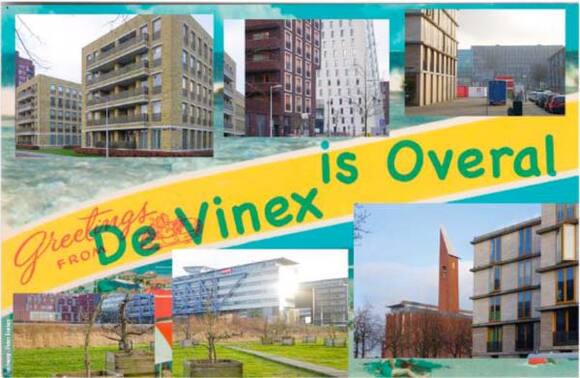
Reis door Vinexland
Journalist Tijs van den Boomen maakte de eerste twee weken van januari een reis door Vinexland. Hij dompelde zich onder in de acht Vinexlocaties, sliep en at bij bewoners, bezocht scholen, een voetbalvereniging en een scoutingclub, maakte een praatje bij de kapper, en ging mee met de hondenuitlaatservice. Hieronder een korte impressie van Tijs:
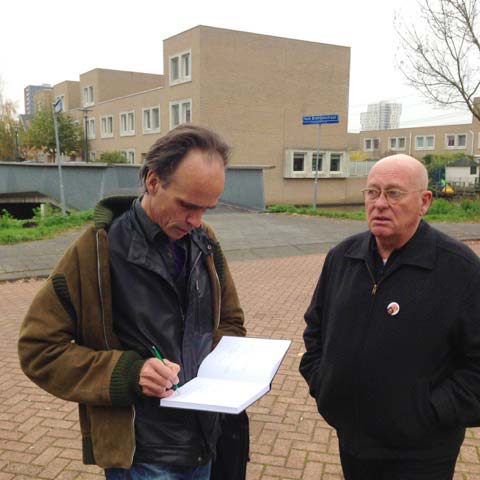
“Pas op de elfde dag van mijn reis door Vinexland viel het kwartje. Ik kwam vanuit Almere-Buiten aan op IJburg en was met stomheid geslagen door het Amsterdamse karakter van de wijk: de onvriendelijkheid van de tramconducteur, de geintjes die mensen op straat met elkaar maken, de vitrine van de Vegetarische Slager, roze zondag bij Café Ed, de energie om het lot in eigen hand te nemen – is er geen bibliotheek, dan richten we er toch zelf een op? Vanuit de Amsterdamse binnenstad beschouwde ik IJburg altijd als Vinex, komend vanuit Vinexland realiseerde ik me hoe Amsterdams het is. En dat Nesseland bijvoorbeeld heel Rotterdams is, en de Waalsprong Nijmeegs. Vinexwijken lijken op de moederstad waar ze bij horen. Dat had ik natuurlijk kunnen weten, want socioloog Herbert Gans schreef vijftig jaar geleden al: ‘New towns are ultimately old communities on new land.’”
Bekijk hier de ansichtkaarten die Tijs vanaf iedere locatie aan Hans Leeflang, een van de rijksambtenaren die aan de wieg stond van de Vinex, stuurde.
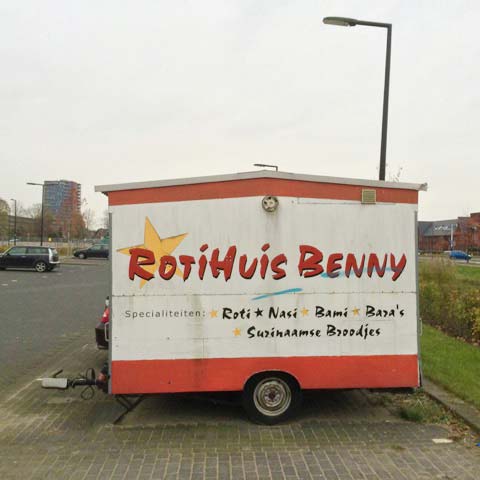
Nog meer Vinex
Journalist Floor Milikowski maakt voor weekblad De Groene Amsterdammer een vijfdelige serie getiteld ‘De Vinex Voorbij’. Daarin kijkt ze terug op 25 jaar Vinex en vooruit naar de grote ruimtelijke opgaven waar ons land de komende jaren voor gesteld staat. In gesprek met denkers, ontwerpers en bestuurders zoekt zij naar een antwoord op de vraag: hoe geven we de toekomst van Nederland vorm?
De publicaties (in januari, maart, mei, september en november) gaan gepaard met bijeenkomsten in Pakhuis de Zwijger. De eerste avond, ‘Is de Vinex geslaagd?’ was op donderdag 22 januari, de volgende bijeenkomst staat gepland voor eind maart.
Agenda
De komende maanden staan verschillende bijeenkomsten gepland over de huidige staat en toekomst van de Vinexwijk. De Vinexmensen is te gast bij lokale architectuurcentra, en gaat in discussie met bewoners, beleidsmakers, en betrokkenen. Voor deze bijeenkomsten ontvangt u een persoonlijke uitnodiging. Via de nieuwsbrief, Twitter en Facebook houden we u op de hoogte van actuele data.
19 februari: Gebiedskantoor Almere Buiten
20 februari: AIR, Rotterdam
19 maart: ARCAM, Amsterdam
15 april: FASadE, Amersfoort
Wilt u zich opgeven als lid van de community? Dat kan bij onderstaande adressen:
JaapJan Berg
Projectleider De Vinexmensen
E: vinexmensen@newtowninstitute.org
T: 06 26 348 903
Saskia Naafs
Assistent De Vinexmensen
E: info@saskianaafs.nl
T: 06 24 708 682
– Twitter: @vinexmensen
– Facebook: Vinexmensen

Aftrap onderzoek
Op 5 februari kwamen bachelor- en masterstudenten van de Universiteit Utrecht en de Universiteit van Amsterdam en afgestudeerde onderzoekers, samen voor een aftrapbijeenkomst in Amsterdam. De 8 wijken zijn over de 17 onderzoekers verdeeld. Zij werken nu aan hun onderzoeksvoorstellen en hebben de eerste verkennende stappen in hun Vinexwijken gezet.
De (student-)onderzoekers laten zich inspireren door stadssocioloog Herbert Gans, die bekendheid verwierf met zijn boek ‘The Levittowners’ (1967). Hij verbleef bijna twee jaar in een nieuwe buitenwijk van New Jersey om deze van binnenuit te leren kennen. Onze onderzoekers moeten met iets minder tijd genoegen nemen. Zij trekken de komende maanden de wijken in en stellen de volgende vragen: Hoe staat de Vinexwijk ervoor? Wie wonen en werken er? Welke mate van stedelijkheid kenmerkt de Vinexwijk? En wat zijn de opgaven voor de toekomst?
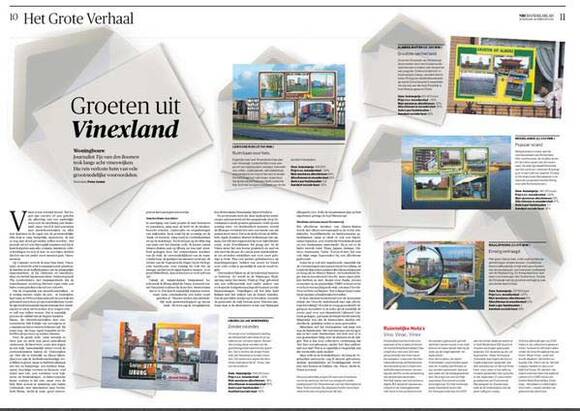
Reis door Vinexland
Voorafgaand aan de studenten en onderzoekers verkende journalist Tijs van den Boomen in opdracht van De Vinexmensen alvast de acht wijken. In januari reisde hij twee weken lang aaneengesloten door Vinexland.
Tijs publiceerde op 18 februari in NRC Handelsblad over zijn reis door Vinexland. In het artikel, dat via Blendle nog steeds te lezen is, schreef hij: “(Vinex) groeide uit tot een bijvoeglijk naamwoord dat je kunt koppelen aan seks, romans, kinderen, echtscheidingen en wat al niet. Je zou bijna denken dat het om een ander soort mensen gaat, Vinexmensen.”
Tijs’ opmerking dat het bij thuiskomst in Amsterdam wel leek alsof er een grauwsluier over de mensen en de dingen hing, kwam hem op commentaar van een Amsterdamse planoloog te staan: “Hoezo ‘vermoeide oude steden’? In de stad gebeurt hét!.” Het bevestigt de tweedeling die vaak lijkt te bestaan tussen Vinex (de buitenwijk) en de stad.
Naar aanleiding van het artikel en zijn reiservaringen werd Tijs op 24 februari ook uitgenodigd bij Radio EenVandaag. In de uitzending vergeleek Tijs Vinex met HEMA: ‘degelijk, fris en fruitig’.
Ondernemend Almere-Buiten
Op 19 februari kwamen we bijeen in het gebiedskantoor van Almere-Buiten om te discussiëren over de stand van de wijkeconomie, het thema voor deze Vinexlocatie. “Hoe staat de wijkeconomie ervoor, en hoe kan die verder vorm krijgen?”. Dit was de eerste on-site bijenkomst van De Vinexmensen. In de andere locaties zullen in de loop van het komende half jaar ook bijeenkomsten plaatsvinden. Deze worden telkens georganiseerd in samenwerking met een lokaal architectuurcentrum.
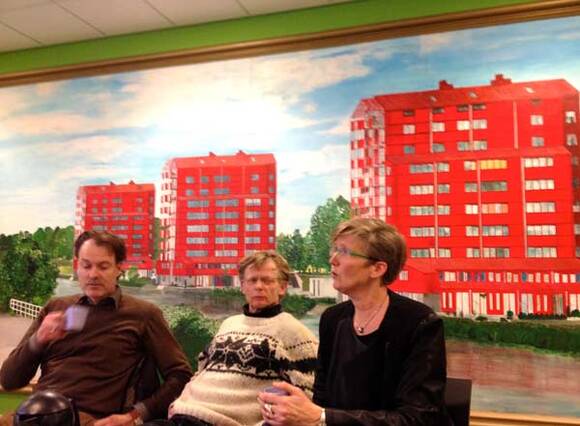
In Almere waren vooral ondernemers uit Almere-Buiten aanwezig. Onder andere: een architect, een kunstenaar, een filmmaker, een restauranthouder en een lokale HEMA-directeur. Vinexwijken worden doorgaans vooral geassocieerd met wonen, maar in Almere-Buiten blijken opvallend veel bedrijven te zitten: in het winkelcentrum, aan de Evenaar, maar ook veel aan huis. In Almere mag namelijk tot 50% van het woonoppervlak voor ‘kantoorhoudende’ activiteiten gebruikt worden. Een impuls die effect heeft, zo lijkt het.
“In een woonwijk zitten is juist een toegevoegde waarde,” zei Yuk Ha Tang, eigenaresse van restaurant Tang Dynasty aan de Evenaar. De meeste van haar klandizie komt uit de wijk. De Evenaar krijgt steeds meer allure, met knipperende neonlichten van restaurants. Toch wringt de wijkeconomie ook: dat grote busje van de buurman monteur bederft het uitzicht nogal, en het verkeer neemt toe in rustige straten waar opeens een kinderopvang komt, of een zorgpraktijk aan huis. ‘Ik ben hier voor mijn rust komen wonen’.
Kansen liggen er vooral als Almere-Buiten buiten de wijkgrenzen kijkt. Thijs van der Steeg, strateeg van de gemeente Almere, denkt dat Buiten in de toekomst de relatie moet zoeken met het omliggende poldergebied en de kassen, waar veel voedsel geproduceerd wordt. Bovendien ligt de wijk Almere-Buiten straks het dichtst bij vliegveld Lelystad.
Bijeenkomst in AIR Rotterdam
Ruim 20 vertegenwoordigers van de overheid, architectuurcentra en universiteiten waren op uitnodiging van De Vinexmensen op 20 februari bijeen gekomen in AIR Rotterdam om naar presentaties van Hans Leeflang (Ministerie I&M), journalist Tijs van den Boomen, stedenbouwkundige Arjen Knoester (mede-bedenker van de Vinexwijk Nesselande) en van Henriette Sanders (CAST Tilburg) en stedenbouwkundige Bart Jonkers (bewoner en ervaringsdeskundige van de Vinexwijk Reeshof).
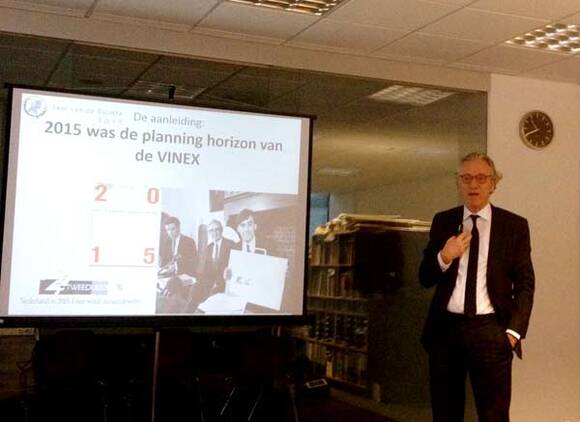
Hans Leeflang, een van de grondleggers van de Vinex, blikte in zijn presentatie terug, maar keek ook vooruit. “Door de Vinex gingen de steden van slot, kreeg het bouwen een enorme impuls, en werd voorzien in de woningbehoefte van velen,” zei hij. Ook noemde hij vijf ‘spannende punten’ voor de toekomst:
1) De financiële perverse effecten van Vinex: gemeenten hebben zich vergist in grondaankoop en moeten nu afschrijven en verlies nemen.
2) Veel Vinexlocaties zijn, mede door de crisis, nog niet af. De mate waarin varieert. De Waalsprong in Nijmegen is een voorbeeld waar nog maar relatief weinig van de oorspronkelijke plannen is gerealiseerd.
3) Verbinding van Randstedelijke Vinexlocaties met omringende wijken: “Het zijn eilanden, ruimtelijk en sociaal, met een eigen dynamiek.”
4) Mobiliteit: Randstedelijke Vinexlocaties hebben bijgedragen aan toename autoverkeer.
5) Hoe koppelen we Vinex aan nationale opgaven als duurzame energie, bodemdaling, en wateroverlast?
Agenda
De komende maanden staan verschillende bijeenkomsten gepland over de huidige staat en toekomst van de Vinexwijk. De Vinexmensen is te gast bij lokale architectuurcentra, en gaat in discussie met bewoners, beleidsmakers, en betrokkenen. Voor deze bijeenkomsten ontvangt u een persoonlijke uitnodiging. Via de nieuwsbrief, Twitter en Facebook houden we u op de hoogte van actuele data.
– 16 maart: Presentatie ideeën en onderzoeksvragen studenten UVA (besloten)
– 19 maart: Vinexmensen bijeenkomst architectuurcentrum ARCAM Amsterdam
– 15 april: Vinexmensen bijeenkomst architectuurcentrum FASadE, Amersfoort
– 4 juni: Nacht van de Vinex, Pakhuis de Zwijger Amsterdam
Wie zijn De Vinexmensen?
Via deze maandelijkse nieuwsbrief willen we u op de hoogte houden van de vorderingen van De Vinexmensen. Wij zijn een van de drie communities van het Jaar van de Ruimte, dat op 15 januari van start is gegaan.
De Vinexmensen wil weten hoe de Vinexwijken er, 25 jaar na het verschijnen van de Vierde Nota Extra, voor staan, maar kijkt ook vooruit: hoe ziet de toekomst van de Vinex eruit, en hoe gaan we die vormgeven?
In De Vinexmensen komen de stem van de gebruikers, het vertrouwen in bottom-up en de vraag naar de toekomst van de Vinex samen. Door middel van onderzoek, discussiebijeenkomsten en journalistieke projecten genereren we antwoorden op de vragen hoe de vijfentwintig jaar oude Vinex ervoor staat, en wat de opgaven voor de toekomst zijn.
We zoomen specifiek in op acht wijken: Leidsche Rijn (Utrecht), Vathorst (Amersfoort), Stad van de Zon (Heerhugowaard), Reeshof (Tilburg), de Waalsprong (Nijmegen), Nesselande (Rotterdam), IJburg (Amsterdam) en Almere-Buiten.
Voor meer informatie:
JaapJan Berg
Projectleider De Vinexmensen
E: vinexmensen@newtowninstitute.org
T: 06 26 348 903
Saskia Naafs
Assistent De Vinexmensen
E: info@saskianaafs.nl
T: 06 24 708 682
– Twitter: @vinexmensen
– Facebook: Vinexmensen
The International New Town Institute (INTI) is proud to announce its program for the conference “Urban Africa: new strategies for the world’s fastest urbanizing continent” and cordially invites you to join. Professionals from Europe and Africa present their visions on the current urban development in Africa. The event will be a crash course for anyone working or interested in Africa.
This international conference will explore the current trajectory of African urbanization with insights from some of the most exciting voices in the field and serve as a platform to begin an open debate.
Africa’s population and economic growth make it the world’s fastest urbanizing continent. While some might still associate Africa with rural development, the future of Africa is, in fact, very urban.
This urbanization is a huge challenge in a continent stricken by poverty and corruption. Many migrants moving to the city end up in self-organized settlements without basic services. One alternative is being offered by developers and investors from countries like China and Korea, who have designed and built new towns in Africa that are modeled after Asian cities. But is this really a proper alternative? Does one size fit all? Or is it a model being copied without considering whether it’s appropriate for Africa?
Edgar Pieterse writes in his recent publication Africa’s Urban Revolution: “As the continent that will be disproportionately shaped by the way in which society thinks about cities, Africa must assume an increasingly central position in the urban imagerinary of theorists and practitioners.” African cities should have top-priority on the designer’s agenda. But do they?
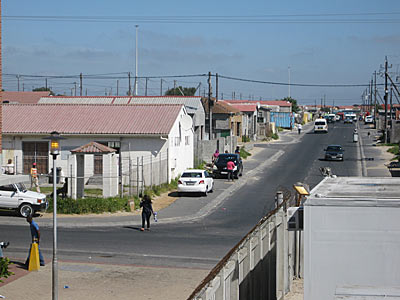
By bringing together speakers from academic, political and design backgrounds, INTI wants to initiate a critical conversation about ‘Urban Africa’ and the western world’s role—if any—in the radical transformations on this continent. What should be on the agenda? What should be the role of the western partners? And what can we expect from the professional community?
For the past year, three teams of South African and Dutch designers have worked together within a project called ‘The Density Syndicate’ to come up with alternatives for the present sprawling urbanization of Cape Town. They explored how a higher density of functions and activities could improve the social, economic and spatial conditions in Cape Town. Their findings will be presented and discussed during the conference. This cooperation is not one way traffic: with Dutch spatial planning changing from integral top down planning to a focus on decentralization and participation, what are the lessons to be learned from Urban Africa?
PROGRAM
| 08:30 – 09:00 | Welcome, coffee and tea |
| 09:00 – 09:15 | Introduction by Michelle Provoost (Director INTI) |
| SESSION 1 | THE URBANIZATION OF AFRICA |
| 09:15 – 10:00 | Lecture by Edgar Pieterse (Director African Centre for Cities, University of Cape Town) - ‘Africa’s Urban Imperatives’ |
| 10:00 – 10:45 | Lecture by Lawrence Esho (Professor Technical University of Kenya) - ‘Of Masks, spirits and planning in Africa’ |
| 10:45 - 11:50 | Debate with speakers and Ton Dietz (African Studies Centre, Leiden University), Ronald Wall (Institute for Housing and Urban Development, Erasmus University Rotterdam) and Maarten Hajer (Planbureau voor de Leefomgeving) |
| 11:50 - 12:00 | Lard Buurman (photographer) – ‘Africa Junctions’ |
| 12:00 – 13:00 | LUNCH |
| SESSION 2 | THE DENSITY SYNDICATE |
| 13:00 – 13:10 | Skype interview with Catherine Stone (Director of Spatial and Urban Planning Department of the City of Cape Town) |
| 13:10 – 13:30 | Presentation Density Syndicate by Michelle Provoost (Director INTI) |
| 13:30 – 13:55 | Q&A with Density Syndicate partners: Jandirk Hoekstra (h+n+s landschapsarchitecten) , Khalied Jacobs (Jakupa architects and urban designers) , Duzan Doepel (Doepel Stijkers) , Jason Hilgefort (Land and Civilization Compositions) , Harro Wieringa (Witteveen+Bos), Walter van Dijk (NL Architects) , Edgar Pieterse (African Centre for Cities) |
| 13:55 – 14:00 | Presentation publication Density Syndicate: ‘Cape Town. Densification as a cure for a segregated city’ |
| SESSION 3 | STRATEGIES |
| 14:00 – 14:30 | Lecture by Rogier van den Berg (UN HABITAT) - ‘Five ingredients for good african cities’ |
| 14:30 – 15:00 | Lecture by Ekim Tan (Play the City) - ‘Serious Gaming in Kayelitsha, Cape Town’ |
| 15:00 – 15:30 | TEA BREAK |
| 15:30 – 16:00 | Lecture by Robert van Kats (Dasuda) - ‘Strategy and Practice’ |
| 16:00 – 16:30 | Lecture by Khalied Jacobs (Jakupa architects and urban designers) - ‘Working in African reality’ |
| 16:30 – 17:30 | Discussion with Edgar Pieterse, Lawrence Esho, Rogier van den Berg, Ekim Tan, Robert van Kats and Khalied Jacobs |
| 17:30 – 18:00 | DRINKS |
– Christine de Baan will moderate the conference.
PARTNERS:
Urban Africa is an initiative organized by INTI, in cooperation with the African Studies Centre, Leiden (ASC), the Institute for Housing and Urban Development Studies at Erasmus University (IHS). INTI has previously worked with IHS in China on the New New Towns research program and the ASC have a long history of partnership. This event, however, is the first collaboration among all three partners, and represents their complimentary expertise and deep commitment to pursuing a sustainable urban future in Africa.
For this conference and the Density Syndicate, of which it is the result, INTI received generous support from RVO (Rijksdienst Voor Ondernemend Nederland)
PRACTICAL INFORMATION
Date: April 7, 2015
Time: 9:00 – 17:30
Location: Auditorium, Het Nieuwe Instituut, Rotterdam, The Netherlands
Language: English
Entrance (including lunch): € 25,00
Students: € 15,00
You can buy your ticket directly at the website of Het Nieuwe Instituut.
Conference “Urban Africa: new strategies for the world’s fastest urbanizing continent”
Date: April 7, 2015
Time: 9:00 – 17:00
Location: Auditorium, Het Nieuwe Instituut, Rotterdam, The Netherlands
Language: English
Entrance (including lunch): € 25,00
Students: € 15,00
You can buy your ticket directly at the website of Het Nieuwe Instituut.
SPEAKERS
– Edgar Pieterse (Director African Centre for Cities, University of Cape Town)
– Lawrence Esho (Professor Technical University of Kenya)
– Ton Dietz (African Studies Centre, Leiden University)
– Ronald Wall (Institute for Housing and Urban Development, Erasmus University Rotterdam)
– Maarten Hajer (Planbureau voor de Leefomgeving)
– Michelle Provoost (Director INTI)
– Catherine Stone (Director of Spatial and Urban Planning Department of the City of Cape Town)
– Jandirk Hoekstra (h+n+s landschapsarchitecten)
– Khalied Jacobs (Jakupa architects and urban designers)
– Duzan Doepel (Doepel Stijkers)
– Jason Hilgefort (Land and Civilization Compositions)
– Walter van Dijk (NL Architects)
– Harro Wieringa (Witteveen+Bos)
– Rogier van den Berg (UN HABITAT)
– Ekim Tan (Play the City)
– Robert van Kats (Dasuda)
– Khalied Jacobs (Jakupa architects and urban designers)
– Christine de Baan (INTI) will moderate the conference.
Together with Placemakers and the IFHP, the International New Town Institute is co-organizing a placemaking design workshop in Nairobi, called "the Making Cities Together LAB". The design lab will take place in Nairobi, Kenya from May 4-8, 2015.
We’re looking for enthusiastic professionals who want to join us in contributing to better public spaces in Nairobi.
There is only a couple of days left to respond to the Open Call before the application deadline on March 31!
Nairobi has a lot of public space that suffers from degradation, overcrowding, and insecurity, thereby denying city residents access to much-needed community, recreation and leisure facilities. Last year, Placemakers and the Technical University of Kenya conducted a citywide inventory of socio-spatial participatory planning initiatives in Nairobi. The outcome indicated that Nairobi’s citizens are leaders in participatory urban development and using placemaking approaches to solve this public space crisis, which results in truly inspiring projects for the public places. However, these efforts face multiple challenges and often lack access to (local) expertise.
How can we improve these spaces? And how can we empower communities and organizations to improve the quality of their environments? For the project ‘Making Cities Together’ we invite you to co-create inclusive spaces in Nairobi. The ultimate goal of the research lab is to create a framework for practical placemaking strategies at the city scale. One of the sites will be realized according to the results of the LAB.
At least six international experts will be selected in order to form three teams, each consisting of a representative from a local placemaking initiative, two international experts and two local experts based in Nairobi. Each team will research one of three selected dynamic and upcoming placemaking locations in Nairobi – ‘the streets of Korogocho - an informal settlement’, ‘The Sunken Car Park in Nairobi’s city centre’ or ‘ The courtyards of Dandora – a residential neighbourhood’.
There are travel grants available for participants who require assistance.
Interested? Check out the Open Call for more information and sign up today!
http://www.ifhp.org/news/making-cities-together-lab-call-application

E-book ‘Groeten uit Vinexland’
‘Ik zou er nog niet dood gevonden willen worden.’ Dat was bijna steevast de reactie die journalist Tijs van den Boomen kreeg als hij vertelde dat hij een zeventiendaagse rondreis door Vinexland ging maken. ‘Ik wilde weten hoe het er was, 25 jaar nadat de Vinex was bedacht, en hoe de mensen er leefden.’
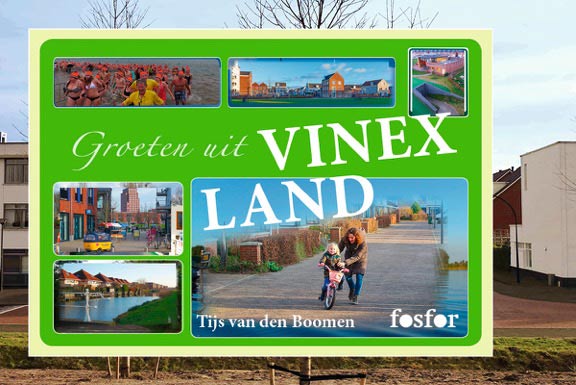
Tijs trok begin januari op verzoek van De Vinexmensen langs acht Vinexwijken. Hij verbleef tussen ‘de Vinexmensen’, bezocht een scoutingclub en een hondenuitlaatservice, ging naar de kapper, at bij de Chinees en de snackbar, en sliep bij mensen thuis. Over zijn ervaringen publiceerde hij eerder in NRC Handelsblad. Nu is zijn complete verhaal te lezen als longread. Download het e-boek via uitgeverij Fosfor of bij Apple
Vinexmensen.nl
‘Groeten uit Vinexland’ is ook gratis te lezen op onze nieuwe website: www.vinexmensen.nl. Op deze website zullen we een agenda bijhouden en regelmatige updates geven over de onderzoeken in de acht Vinexwijken. 18 onderzoekers van de Universiteit Utrecht, de Universiteit Amsterdam en het International New Town Institute hebben zich vastgebeten in uiteenlopende onderwerpen: van bewonersbetrokkenheid en sociale diversiteit op IJburg, tot de wijkeconomie en leefbaarheid in Almere-Buiten, de allochtone middenklasse in Leidsche Rijn, en het thuisgevoel in de Stad van de Zon in Heerhugowaard. Zij zullen daar nog tot aan de zomer mee bezig zijn en ons via blogverhalen en foto’s op de hoogte houden.
Vathorst
Op 15 april vond in het i-Centrum in Amersfoort-Vathorst het mini-symposium plaats: ‘Van Vinex naar Vathorst – de kracht van kwaliteit’. Onder leiding van cabaretier Patrick Nederkoorn gingen beleidsmakers, architectuurhistorici, stedenbouwkundigen, projectontwikkelaars en politici met elkaar in gesprek over deze woonwijk die in 10 jaar uit de grond gestampt is. Inmiddels wonen er al 20.000 naar volle tevredenheid, maar de wijk is nog volop in ontwikkeling.
Volgens directeur Giel van der Vlies van het Ontwikkelingsbedrijf Vathorst (OBV) is Vathorst de Vinex al vier stappen voorbij, maar is het nu zaak om ook die vijfde en zesde stap te zetten. De ontwikkeling van Vathorst heeft door de crisis vertraging opgelopen en zal naar verwachting in 2025 ‘af’ zijn. Vathorst heeft nog genoeg mogelijkheden om te groeien: zo moet Vathorst-West nog ontwikkeld worden, evenals een nieuw buurtwinkelcentrum, en kan de buurt nog verdichten.
Maar hoe zorg je dat in deze laatste fase de kwaliteit van de bebouwing en de voorzieningen hoog blijft? De gemeente, deel van een privaat-publiek consortium met bouwbedrijven en een woningcorporatie, heeft vorig jaar 8,8 miljoen euro moeten afboeken op de grondexploitatie en is daardoor genoodzaakt te bezuinigen. Plannen voor een nieuw zwembad zijn bijvoorbeeld geschrapt. Er worden nu vrije bouwkavels uitgegeven, maar daar moet je wel regels voor opstellen. ‘Je kunt de regie niet helemaal uit handen geven’.
Volgens een recent onderzoek van SmartAgent is 90% van de bewoners tevreden over Vathorst. Ze roemen de kindvriendelijkheid en de veilige ‘dorpse’ sfeer. Toch moet er ook al nagedacht worden over de vele jonge kinderen die straks naar de middelbare school gaan en wellicht op straat gaan hangen als er in Vathorst niet genoeg te doen is. ‘Wat doe je met al die pubers in een wijk vol wipkippen?’. Zo blijft Vathorst voorlopig een wijk in ontwikkeling.
IJburg: stad buiten de Ring
‘Bij Vinex hebben mensen het idee van eenvormigheid, saaiheid. Dat zullen bewoners niet over hun eigen wijk zeggen. Ik zeg altijd dat ik op IJburg woon, dan zijn mensen meteen jaloers, omdat ik aan het water woon.’
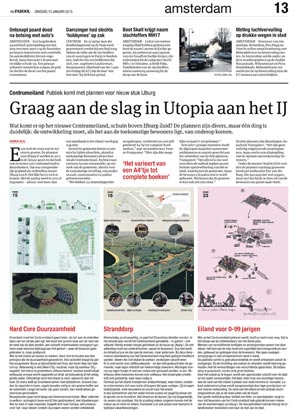
Op donderdag 19 maart organiseerde Arcam in samenwerking met het International New Town Institute (INTI) een gesprek over de wijk IJburg. Een Vinexlocatie, maar nadrukkelijk vormgegeven en ingericht als een wijk met een grootstedelijk karakter. Met bewoners, plannenmakers en gebruikers gingen we in op de vraag of dit gelukt is.
Volgens de aanwezige bewoners is IJburg als stadswijk goed gelukt. Zo zei een bewoner van het eerste uur: ‘Vinex heeft een negatieve kleur en klank gekregen: het zijn monotone slaapwijken. Maar IJburg is zoveel meer. Het is echt een stad buiten de ring. Het is een goede, gemengde wijk. Er wordt gewoond en gewerkt. Dat was ook de bedoeling: geen Vinex maken, maar een stad.’
Voor het nog te ontwikkelen Centrumeiland zijn er risico’s, zoals uitsluiting van minder kapitaalkrachtige bewoners door zelfbouw en een lager percentage sociale huur, en een verschraling van de Eerste Fase van IJburg als huidige bewoners doorstromen naar het nieuwe eiland. Maar er zijn ook een hoop lessen uit de Eerste Fase die meegenomen kunnen worden: zoals het betrekken van bewoners bij de planvorming en ontwikkeling, ruimte voor ontmoetingen, aandacht voor de openbare ruimte en duurzaamheid, inzetten op natuur- en waterrecreatie, en het creëren van nieuwe voorzieningen zoals een winkelcentrum en een bioscoop.
Agenda
De komende maanden staan verschillende bijeenkomsten gepland over de huidige staat en toekomst van de Vinexwijk. De Vinexmensen is te gast bij lokale architectuurcentra, en gaat in discussie met bewoners, beleidsmakers, en betrokkenen. Voor deze bijeenkomsten ontvangt u een persoonlijke uitnodiging. Via onze website, Twitter en Facebook houden we u op de hoogte van actuele data.
– 4 juni: Nacht van de Ruimtelijke Metamorfose (Planbureau voor de Leefomgeving), Pakhuis de Zwijger Amsterdam
zie: themasites.pbl.nl/jaar-van-de-ruimte/de-nacht-van-de-ruimtelijke-metamorfose
– 6/7 juni: Camping Onbestemd, Leidsche Rijn Utrecht,
zie: www.bureauruimtereizigers.nl
Wie zijn De Vinexmensen?
Via deze maandelijkse nieuwsbrief willen we u op de hoogte houden van de vorderingen van De Vinexmensen. Wij zijn een van de drie communities van het Jaar van de Ruimte, dat op 15 januari van start is gegaan.
De Vinexmensen wil weten hoe de Vinexwijken er, 25 jaar na het verschijnen van de Vierde Nota Extra, voor staan, maar kijkt ook vooruit: hoe ziet de toekomst van de Vinex eruit, en hoe gaan we die vormgeven?
In De Vinexmensen komen de stem van de gebruikers, het vertrouwen in bottom-up en de vraag naar de toekomst van de Vinex samen. Door middel van onderzoek, discussiebijeenkomsten en journalistieke projecten genereren we antwoorden op de vragen hoe de vijfentwintig jaar oude Vinex ervoor staat, en wat de opgaven voor de toekomst zijn.
We zoomen specifiek in op acht wijken: Leidsche Rijn (Utrecht), Vathorst (Amersfoort), Stad van de Zon (Heerhugowaard), Reeshof (Tilburg), de Waalsprong (Nijmegen), Nesselande (Rotterdam), IJburg (Amsterdam) en Almere-Buiten.
Voor meer informatie:
JaapJan Berg
Projectleider De Vinexmensen
E: vinexmensen@newtowninstitute.org
T: 06 26 348 903
Saskia Naafs
Assistent De Vinexmensen
E: info@saskianaafs.nl
T: 06 24 708 682
– www.vinexmensen.nl
– Twitter: @vinexmensen
– Facebook: Vinexmensen
On Tuesday 2 June, Jorge Peña Díaz (architect and professor on Urban Design at the CUJAE University of Havana Cuba) will give a lecture about the recent past and near future of the fascinating city of Havana, the capital of Cuba, entitled: Havana 2015 – Paths and patterns of urban development. The lecture addresses the current patterns of urban development in Havana, using the results of the project Atlas Urbano de La Habana (Urban Atlas of Havana). This project consisted of the mapping of Havana as a research tool in order to understand both the specificities of the current urban situation and the milestones it has followed. This analysis allows to understand the impact of the economic and political crisis of the 90´s in the urban structure of Havana. It also shows the fabric on top of which both internal structural changes and foreign factors have been and will be operating.
The lecture also addresses the most pressing urban questions that Havana is facing at this moment, among which is the transformation of the harbour of Havana. The historic harbour, dating back to the beginning of colonial time, has functionally been replaced by another harbour, leaving the old harbour to be redeveloped. Now that Cuba is opening up to the outside world, which direction will the transformation take? Will it remain true to its heritage value and Cuban identity or follow the commercially profitable way of generic leisure harbour development?
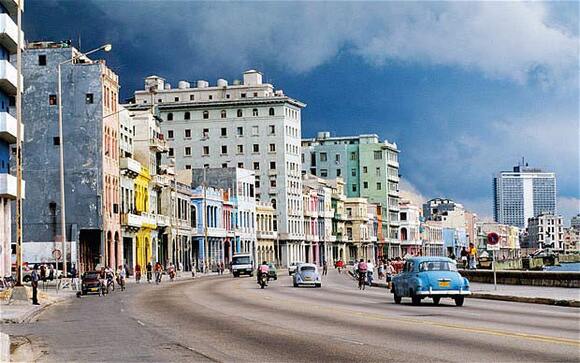
Michelle Provoost will give an introduction to Jorge Peña’s lecture, on the links between Havana and INTI‘s students exchange program. The New Towns near Havana have an interesting background and urgent challenges to be solved. At the moment of Castro’s Revolution in 1959, the urban development of this bustling metropolis came to a grinding halt. While the city was in the midst of the transformation into a second Las Vegas or Miami, all investments were nationalised and development stopped. The only new part of the city built by the communist regime is the infamous Alamar, a Soviet-style New Town for ca. 100.000 inhabitants, which has become well known for its urban agriculture and its hip hop scene. Seen as a unattractive place to live, the crumbling Alamar is in urgent need of new ideas to connect it to the maelstrom of development that Havana will see.
Jorge Peña Díaz is an architect and professor on Urban Design at the Department for Architectural and Urban Design, Faculty of Architecture, CUJAE [Technical University Havana], Cuba. He is teaching on Planning and Heritage conservation and is also head of the Research Group for Urban Research and Action. Apart from his university work, Jorge is also a member of the Expert technical committee for research on urbanism and housing policy of the Ministry of Construction, a member of the experts advisory group for Havana´s city planning and guest Expert to the COST Urban Agriculture Europe Project, RWTH, Aachen.
Organised by INTI, Design as Politics and TU Delft.
Bloggen vanuit de Vinex
Op onze website vinexmensen.nl heeft u de afgelopen weken kunnen lezen hoe het met het onderzoek in de acht verschillende Vinexwijken staat. In totaal zijn twintig onderzoekers van de Universiteit Amsterdam, de Universiteit Utrecht en het International New Town Institute de afgelopen maanden de wijk in gegaan om uitgebreid te observeren, te enquêteren en te interviewen. Ze hebben zich vastgebeten in uiteenlopende onderwerpen: van bewonersbetrokkenheid en sociale diversiteit op IJburg, wijkeconomie en leefbaarheid in Almere-Buiten, de allochtone middenklasse in Leidsche Rijn, tot het thuisgevoel in de Stad van de Zon in Heerhugowaard.
Wie de verschillende ervaringen leest, merkt vooral dat een hoop vooroordelen over Vinex niet overeind blijven. In de Stad van de Zon werd bijvoorbeeld verbaasd gereageerd op de vraag hoe het is om in een Vinexwijk te wonen. ‘Vinex? Dat is toch met allemaal eentonige rijtjeshuizen? Nee, ik woon niet in een Vinex-wijk hoor.’ De bewoners van Koolhoven in Tilburg vinden eerder dat ze in een dorp in de stad wonen dan in een nieuwbouwwijk. En de onderzoekster die Leidsche Rijn verkende, was prettig verrast over de variatie en het stedelijke karakter van deze wijk. Hoe blijven die vooroordelen over Vinex dan toch bestaan? Voor een belangrijk deel worden die herhaald in de media, bijvoorbeeld door columnisten die zelf niet in een Vinexwijk wonen, ontdekte de student die beeldvorming over IJburg onder de loep neemt. De onderzoeken worden momenteel afgerond. In de tweede helft van het jaar bundelen we de resultaten.
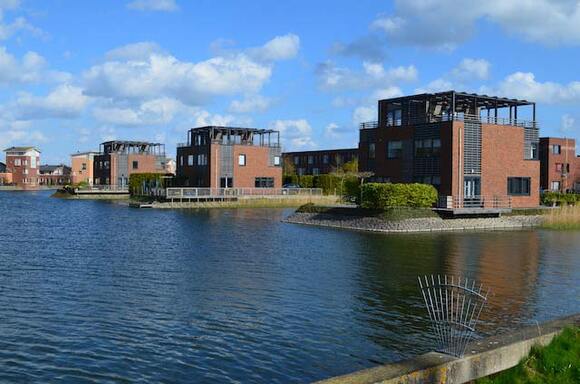
Gordijnen dicht in Stad van de Zon
Op een zeer winderige dinsdagavond kwamen we bijeen met enkele actieve bewoners en beleidsmakers in de Stad van de Zon in Heerhugowaard. Kwesties die aan de orde kwamen op die eerste bijeenkomst op 2 juni: hoe zorg je dat een jonge wijk meegroeit met zijn bewoners, en dat tieners straks niet op de wipkip gaan hangen? En hoe betrek je nieuwe bewoners bij de buurt? Ook kwam het gebrek aan ontmoetingsplekken in Stad van de Zon ter sprake. ’s Avonds is de wijk uitgestorven. ‘De mensen komen om 18.00 uur thuis van hun werk, en om 19.00 uur gaan de gordijnen dicht,’ zei een bewoner. Hoe maak je een wijk levendiger? Over deze kwesties en nog veel meer gaan we het met bewoners en betrokken beleidsmakers op 24 juni verder hebben in wijkcentrum De Mediaan in Stad van de Zon.
Nacht van de ruimtelijke metamorfose
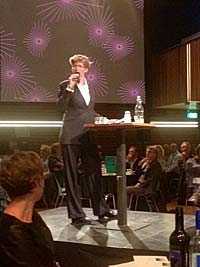
Het Planbureau van de Leefomgeving (PBL) organiseerde op 4 juni in Pakhuis de Zwijger een Nacht van de ruimtelijke metamorfose. Sprekers Ed Nijpels (voormalig minister VROM); Adriaan Geuze (landschapsarchitect, oprichter West 8 Urban Design and Landscape Architecture) en Maarten Hajer (directeur PBL) blikten terug op de periode van de Vierde Nota Ruimtelijke Ordening (VINO) en de Vierde Nota Extra (VINEX). Zo stelde Maarten Hajer over Vinex: ’we wilden hoogstedelijk bouwen, maar we hebben mensen ook gewoon hun tuintjes gegeven’. Tegelijkertijd benadrukte hij ook dat deze vorm van grootschalige gebiedsuitbreiding en functiescheiding niet meer terug zal komen. Adriaan Geuze had juist kritiek op de doorgeschoten planningsindustrie in Nederland, en pleitte voor een terugkeer van de ingenieur en een democratische ruimtelijke ordening.
De tweede helft van de avond hoorden we vier pitches van bevlogen professionals en bewoners. Op uitnodiging van Vinexmensen nam Cora Spaans, zzp-er in Almere-Buiten en eigenaar van Corazón Projecten, het woord. Zij wilde graag weten hoe ondernemers de wijkeconomie in Almere-Buiten net een stapje verder kunnen brengen, zodat zzp-ers het niveau van geïsoleerde eenpitter kunnen ontstijgen, van elkaars netwerken gebruik kunnen maken, en in gesprek kunnen gaan met de gemeente. Uit de zaal kreeg zij onder andere het advies om goed voor ogen te houden welke meerwaarde samenwerking ondernemers oplevert. Ook kreeg ze het advies om een goede zzp-ontmoetingsplek in Almere-Buiten te creëren.
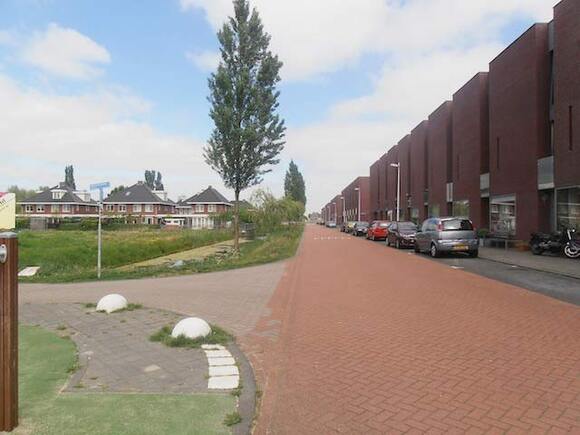
Camping Onbestemd in Leidsche Rijn
De eerste week van juni was een drukke week, want op zaterdag de 6e waren we te gast op Camping Onbestemd in Leidsche Rijn. Deze rondreizende camping is een initiatief van Bureau Ruimtereizigers en onderdeel van het Jaar van de Ruimte. Alle weekenden van juni trekken ze langs nieuwe stukjes Nederland. In Leidsche Rijn kampeerden de campinggasten op het dak van de A2. ’s Middags maakten ze een fietstocht door de wijk. UvA-student Iris Leeuwerink vertelde aan de Vlindersingel over haar onderzoek naar allochtone bewoners. Ze koos deze locatie omdat daar duidelijk de grenslijn te zien is tussen de sociale huurappartementen en de duurdere vrijstaande koopwoningen. In opzet is Leidsche Rijn een diverse en gemengde wijk. Toch vinden sommige allochtone buurtbewoners het jammer dat ze weinig contact hebben met hun autochtone buren. Er zijn weinig plekken waar je elkaar kunt ontmoeten, met uitzondering van de vele sportverenigingen die de wijk rijk is.
Agenda
De komende weken staan verschillende bijeenkomsten gepland over de huidige staat en toekomst van de Vinexwijk. Via Twitter en Facebook houden we u op de hoogte van actuele data en locaties.
– 24 juni: Stad van de Zon, Heerhugowaard. Aan de hand van prikkelende stellingen gaan we met bewoners en beleidsmakers in discussie over de huidige staat van Stad van de Zon en toekomstige opgaven. Woensdag 24 juni, 19.30 uur, Wijkcentrum de Mediaan, Brandpunt 1, Heerhugowaard.
– 30 juni: Reeshof, Tilburg. Samen met architectuurcentrum CAST organiseren we een bijeenkomst over de Reeshof. Op deze avond zullen onder andere stedenbouwkundigen en onze onderzoekers hun visie op de wijk geven, en in gesprek gaan met bewoners. Locatie en tijdstip worden later bekend gemaakt.
– 1 juli: Nesselande, Rotterdam. Op woensdagavond 1 juli organiseren De Vinexmensen, architectuurcentrum AIR en de gemeente Rotterdam een fietstocht door Nesselande, met aansluitend een bijeenkomst. Aanwezig zijn onder andere Hans Leeflang van het ministerie van Infrastructuur en Milieu, hoofdontwerper van Nesselande Arjen Knoester en stadssociologie professor Arnold Reijndorp.
Woensdag 1 juli in Nesselande, start publieke bijeenkomst 19:30 uur.
Wie zijn De Vinexmensen?
Via deze maandelijkse nieuwsbrief willen we u op de hoogte houden van de vorderingen van De Vinexmensen. Wij zijn een van de drie communities van het Jaar van de Ruimte, dat op 15 januari 2015 van start is gegaan.
De Vinexmensen wil weten hoe de Vinexwijken er, 25 jaar na het verschijnen van de Vierde Nota Extra, voor staan, maar kijkt ook vooruit: hoe ziet de toekomst van de Vinex eruit, en hoe gaan we die vormgeven?
In De Vinexmensen komen de stem van de gebruikers, het vertrouwen in bottom-up en de vraag naar de toekomst van de Vinex samen. Door middel van onderzoek, discussiebijeenkomsten en journalistieke projecten genereren we antwoorden op de vragen hoe de vijfentwintig jaar oude Vinex ervoor staat, en wat de opgaven voor de toekomst zijn.
We zoomen specifiek in op acht wijken: Leidsche Rijn (Utrecht), Vathorst (Amersfoort), Stad van de Zon (Heerhugowaard), Reeshof (Tilburg), de Waalsprong (Nijmegen), Nesselande (Rotterdam), IJburg (Amsterdam) en Almere-Buiten.
Voor meer informatie:
JaapJan Berg
Projectleider De Vinexmensen
E: vinexmensen@newtowninstitute.org
T: 06 26 348 903
Saskia Naafs
Assistent De Vinexmensen
E: info@saskianaafs.nl
T: 06 24 708 682
– www.vinexmensen.nl
– Twitter: @vinexmensen
– Facebook: Vinexmensen
De Vinexmensen 3 september in Pakhuis De Zwijger. Meld je nu aan!
Wat moet er in de Actieagenda voor Vinexwijken staan?
Deze vraag staat centraal op donderdag 3 september. Samen met Pakhuis De Zwijger organiseren De Vinexmensen een avond die geheel in het teken staat van de toekomst van Vinexwijken.
We willen samen met Vinexbewoners en betrokkenen urgente toekomstopgaven voor de Vinexwijken vaststellen. Deze punten zullen we meenemen in de Vinexmensen Actieagenda die we aan het einde van dit Jaar van de Ruimte zullen presenteren.
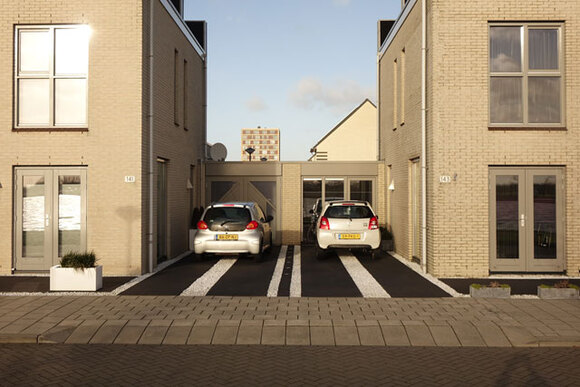
U bent van harte uitgenodigd om mee te komen discussiëren over de toekomst van de Vinex. Na drie inleidingen door stedenbouwkundige Hans Leeflang, journalist Tijs van den Boomen en stadssocioloog Arnold Reijndorp, zullen we met elkaar in debat gaan.
De thema’s die gedurende de avond in elk geval aan de orde komen zijn: ‘De Vinex is nog niet af’, ‘Vinex voor jong en oud?’, ‘De bereikbare Vinex’ en ‘De suburbane idylle verstoord’.
Dus heeft u een mening over de toekomst van Vinexwijken? Kom dan zeker naar Pakhuis De Zwijger op 3 september. Het programma start om 19:30 uur en duurt tot 22.00 uur.
Vergeet niet u op te geven via deze site: dezwijger.nl/programma/de-toekomst-van-vinexwijken
Bloggen over De Waalsprong
Onderzoeker Yannick Sonne deed in opdracht van De Vinexmensen diepgravend onderzoek in Vinexwijk De Waalsprong in Nijmegen-Noord. Anders dan de voorafgaande blogs van studenten en onderzoekers, schrijft Yannick niet één verhaal maar een hele serie. Op deze manier geeft hij een goede inkijk in de kenmerkende eigenschappen en actuele ontwikkelingen van deze Vinexwijk. Tegelijkertijd geven zijn verhalen inzicht in het verloop en de aanpak van zijn onderzoek gedurende de afgelopen maanden.
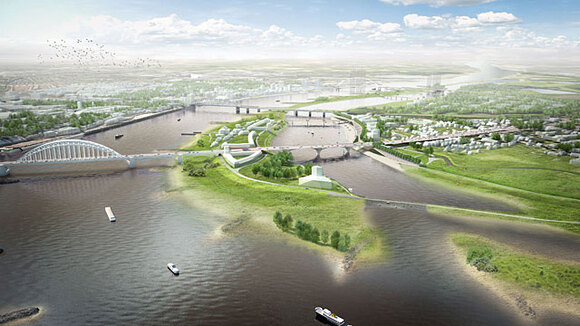
“In maart fiets ik voor de eerste keer de brug over. Over de rivier, het nieuwe riviereiland, de basaltblokken van de nieuwe dijk. Langs het door Nijmegen ingelijfde oude dorp Lent. Rechts van de spoordijk ligt ruig niemandsland, met graafmachines, nog af te bouwen hoofdwegen, grasland en heel veel zand. Het is een winderige vroege lentedag, waarop donkere wolken met buien snel voorbijtrekken en dan weer ruimte laten aan de zon. Aan de horizon, achter de rivierdijk aan de overkant van de Waal, de rokende pijpen van energiecentrale GDF Suez. Een groter contrast met de stille opgeruimdheid van het nieuwe Oosterhout en Lent, waar ik daarna doorheen fiets, is haast niet denkbaar.”
(fragment uit ‘Bruggen tussen oud en nieuw’ Yannick Sonne, 20 augustus 2015).
De blogs over De Waalspong zijn te lezen op onze website www.vinexmensen.nl. U kunt hier ook de verhalen van onze andere onderzoekers teruglezen. Zij schreven onder meer over duurzaamheid in de Stad van de Zon, bewonersbetrokkenheid op IJburg, allochtone bewoners in Leidsche Rijn, en de typische Vinexmensen van Rotterdam-Nesselande.
Wij Maken Nederland
Als geïnteresseerde Vinexbewoner of betrokkene willen we u graag ook uitnodigen om uw ervaringen, ideeën of meningen over de huidige staat en de toekomst van uw Vinexwijk online met ons te delen.
Dit kan op de website van Wij Maken Nederland (wijmakennederland.nl). Op dit platform zullen we geregeld onderwerpen aansnijden, vragen stellen en onze eigen kennis over Vinexwijken met u delen.
Wilt u bijdragen aan de online discussie over Vinexwijken? Meldt u dan aan als Landmaker op de website van Wij Maken Nederland. Zo kunt u reageren op bijdragen van anderen, én zelf een bijdrage plaatsen.
Wie zijn De Vinexmensen?
Via deze maandelijkse nieuwsbrief willen we u op de hoogte houden van de vorderingen van De Vinexmensen. Wij zijn een van de drie communities van het Jaar van de Ruimte, dat op 15 januari 2015 van start is gegaan. De Vinexmensen wil weten hoe de Vinexwijken er, 25 jaar na het verschijnen van de Vierde Nota Extra, voor staan, maar kijkt ook vooruit: hoe ziet de toekomst van de Vinex eruit, en hoe gaan we die vormgeven?
In De Vinexmensen komen de stem van de gebruikers, het vertrouwen in bottom-up en de vraag naar de toekomst van de Vinex samen. Door middel van onderzoek, discussiebijeenkomsten en journalistieke projecten genereren we antwoorden op de vragen hoe de vijfentwintig jaar oude Vinex ervoor staat, en wat de opgaven voor de toekomst zijn. We zoomen specifiek in op acht wijken: Leidsche Rijn (Utrecht), Vathorst (Amersfoort), Stad van de Zon (Heerhugowaard), Reeshof (Tilburg), de Waalsprong (Nijmegen), Nesselande (Rotterdam), Ijburg (Amsterdam) en Almere-Buiten.
Voor meer informatie:
JaapJan Berg
Projectleider De Vinexmensen
E: vinexmensen@newtowninstitute.org
T: 06 26 348 903
Saskia Naafs
Assistent De Vinexmensen
E: info@saskianaafs.nl
T: 06 24 708 682
– www.vinexmensen.nl
– Twitter: @vinexmensen
– Facebook: Vinexmensen
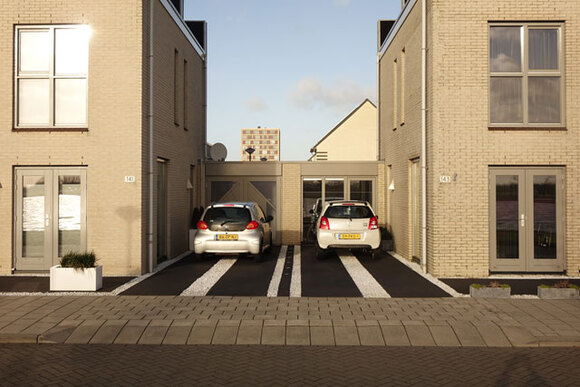
Wat moet er in de Actieagenda voor Vinexwijken staan? Deze vraag staat centraal op donderdag 3 september. Samen met Pakhuis De Zwijger organiseren De Vinexmensen een avond die geheel in het teken staat van de toekomst van Vinexwijken. We willen samen met Vinexbewoners en betrokkenen urgente toekomstopgaven voor de Vinexwijken vaststellen. Deze punten zullen we meenemen in de Vinexmensen Actieagenda die we aan het einde van dit Jaar van de Ruimte zullen presenteren. U bent van harte uitgenodigd om mee te komen discussiëren over de toekomst van de Vinex.
Na drie inleidingen door stedenbouwkundige Hans Leeflang, journalist Tijs van den Boomen en stadssocioloog Arnold Reijndorp, zullen we met elkaar in debat gaan. De thema’s die gedurende de avond in elk geval aan de orde komen zijn: ‘De Vinex is nog niet af’, ‘Vinex voor jong en oud?’, ‘De bereikbare Vinex’ en ‘De suburbane idylle verstoord’. Dus heeft u een mening over de toekomst van Vinexwijken? Kom dan zeker naar Pakhuis De Zwijger op 3 september. Het programma start om 19:30 uur en duurt tot 22.00 uur. Vergeet niet u op te geven via deze site: https://dezwijger.nl/programma/de-toekomst-van-vinexwijken
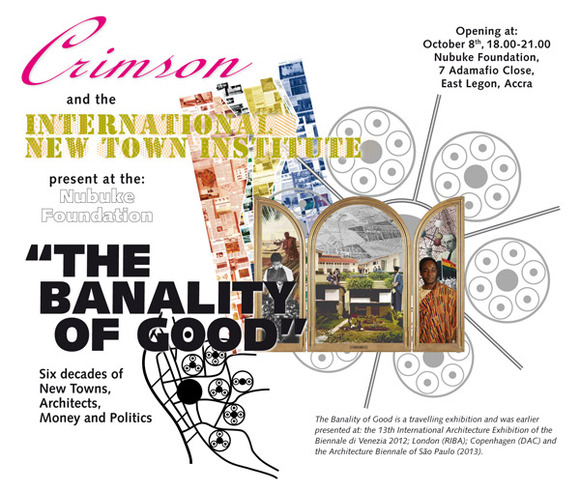
You are cordially invited to the opening of the exhibition The Banality of Good. Six decades of New Towns, Architects, Money and Politics, on October 8th, at 6 PM at the Nubuke Foundation in Accra.
The city of Tema is one of six cities, which are portrayed in the exhibition The Banality of Good. Six decades of New Towns, Architects, Money and Politics, which was made by Crimson Architectural Historians and the International New Town Institute (INTI). It was previously exhibited in Venice, São Paulo, Copenhagen and London.
The exhibition is travelling to the cities which are portrayed, to discuss the values and ideals of urban planning and the way in which architects and planners can contribute to the quality and inclusivity of modern cities. In Ghana this is a relevant topic because of the fast rate of urbanization and the privatization of urban planning. What is a Good City? And how can we design and build it?
The opening is part of a three-day program of events:
– October 8th: Thinking the Good City (a symposium) and opening of the exhibition The Banality of Good: 6pm - 9pm
The symposium will address the main issues raised by the exhibition: the relation between democracy and urban planning, the role of architects in creating inclusivity, and the agenda for Ghanaian urbanization. The focus will be very concrete, looking at Tema as part of the Accra region.
program:
- 6.00 Nubuke Foundation open, music
- 7.00 Opening words by His Excellency the Ambassador of the Netherlands to Ghana, Mr. Hans Docter
- 7.10 Introduction by Dr. Michelle Provoost (Crimson, INTI)
- 7.30 Lecture by Prof. Dr. Wouter Vanstiphout (Crimson, TU Delft)
- 8.00 Panel discussion with:
- Nat Amartefeio (historian, former mayor)
- D.K. Osseo-Asaie (architect, Accra)
- Prof. Sam Afram (KNUST)
- Stella Arthiabah (architect, Ghana Institute of Architects)
- 8.45 Drinks and music
– October 9th: Designing the Good City (a design charette, personal invitation only)
A mixed Ghanaian/Dutch team of designers and planners will use the instruments of research, discussion and design to contribute to the redefinition of what the Good City should be in the case of Accra and Tema.
– October 10th: Imagining the Good City (a workshop for children age 10-13): 10 am – 1 pm
In this workshop children from Tema aged 10 to 13 will discover and design their city and their homes according to their own imagination and needs. They will explore their own world, focusing on the route from their house to school, mapping it first, and then inventing and designing improvements, in a quest for their own place of happiness and paradise.
Partners:
– Crimson Architectural Historians, Rotterdam
– International New Town Institute, Almere
– Tema Development Corporation, Tema
– Chair Design as Politics, Technical University Delft
– Chair Urban Design, Technical University Delft
– Berlage Institute, Technical University Delft
– Dep. of Architecture, Kwame Nkrumah University of Science and Technology, Kumasi
– Central University College, Tema
– Sirron-Kakpor Architects, local liaison of INTI for Research, Exhibition and Educational programs.
De toekomst van Vinexwijken
Begin deze maand verzamelden we in Pakhuis de Zwijger in Amsterdam om met bewoners en betrokkenen te discussiëren over de toekomst van Vinexwijken. Gastsprekers Hans Leeflang (Jaar van de Ruimte), Arnold Reijndorp (stadssocioloog UvA) en journalist Tijs van den Boomen namen ons mee in het verleden, heden en toekomst van de Vinexwijken.
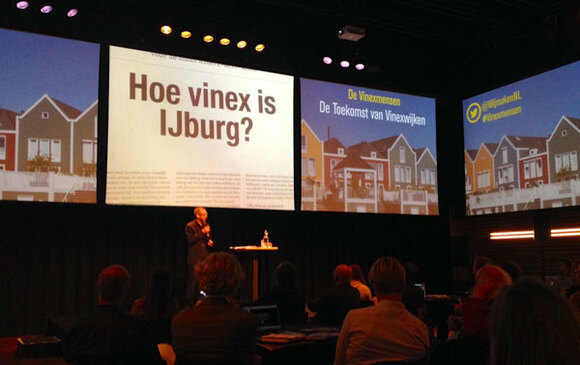
Volgens Hans Leeflang, die als rijksambtenaar aan de wieg stond van de Vierde Nota Extra, verdienen de Vinexwijken nu extra aandacht. Hoe is de verbinding met de stad? Is er goed nagedacht over mobiliteit? En hebben de Vinexwijken geen eenzijdige bevolking?
Tijs van den Boomen trok in opdracht van De Vinexmensen de eerste twee weken van dit jaar door acht Vinexwijken. Hij schreef er een artikel over voor NRC Handelsblad en een longread die via Fosfor te lezen is. Hij verwonderde zich over de afwezigheid van ‘allochtone voorzieningen’ in veel wijken. Leidsche Rijn heeft bijvoorbeeld het hoogste percentage niet-westerse allochtonen, maar nagenoeg geen voorzieningen die daarop inspelen.
Arnold Reijndorp vindt dat de opkomst van kleine projectontwikkelaars en zelfbouwers de diversiteit én de kwaliteit van Vinexwijken ten goede komt. Hij roept op om de toekomstige ontwikkeling van de Vinexwijken niet helemaal dicht te timmeren met regels, maar juist ruimte te bieden aan bottom-up ontwikkeling. Tegelijkertijd moet de overheid blijven waken over de grotere opgaven. Hij waarschuwt ook voor conflicten, zoals de aanwezigheid van hangjongeren, de verhouding tussen huur- en koopwoningen, en overlast die gepaard gaat met stedelijkheid. Die conflicten kun je niet vermijden, maar je kunt wel zorgen voor een beheersbare context, zegt Reijndorp.
Die gedachte kwam ook terug in het tweede deel van de avond, waarin we discussieerden aan de hand van drie stellingen.
“Bewoners kunnen veel beter de toekomst van de wijk bepalen dan gemeenten en projectontwikkelaars.”
Bewoners weten goed wat er speelt in de wijk en waar behoefte aan is, maar tegenover individuele belangen moet je ook ‘strategisch tegenwicht’ zetten, zei aanwezige Tineke Lupi, projectleider bij Platform 31. Leidsche Rijn-bewoner van het eerste uur, Marieke Dubbelman, merkte op dat de macht van de projectontwikkelaar best gebroken mag worden. “Bewoners hebben nu te weinig in te brengen,” zei ze.
“Vinex, daar wonen jonge gezinnen. Voor tieners en senioren is er geen klap aan.”
De Vinexwijken zijn inderdaad vooral in trek bij gezinnen, maar dat betekent niet dat er voor tieners en ouderen niets te doen is, zei stedenbouwkundige Arjen Knoester. Zij kunnen, mits er een goede verbinding is met de stad, hun vertier ook in het centrum zoeken. Nesselande heeft bijvoorbeeld een goede metro-verbinding met het centrum van Rotterdam.
“Maak Vinexwijken goed bereikbaar met het ov, dan laten mensen vanzelf de auto staan.”
Een goede ontsluiting met het OV-netwerk is wel noodzaak, maar leidt niet direct tot afname van het autogebruik. Vaak kiezen mensen voor de meest efficiënte oplossing, zei Fabian Koning, die voor Vinexmensen onderzoek deed in Heerhugowaard. Vinexbewoners lijken gehecht te zijn aan hun auto. Henriëtte Sanders, programmamaker bij architectenbureau CAST uit Tilburg, ziet echter wel toekomst in snelle fietspaden voor e-bikes.
U kunt op de website wijmakennederland.nl/opgaven/vinex-mensen nog steeds reageren op deze stellingen, en ook nieuwe discussies aansnijden.
Actieagenda Vinexwijken
Aan het einde van dit jaar maken we de balans op over de huidige staat en de toekomt van Vinexwijken in onze Actieagenda. Daarin reflecteren we op de opbrengst van de avond in Pakhuis de Zwijger, de onderzoeken die door twintig studenten en zelfstandig onderzoekers in opdracht van De Vinexmensen zijn uitgevoerd, en de bijeenkomsten die we in het eerste half jaar georganiseerd hebben in samenwerking met lokale architectuurcentra.
De komende maanden gaan we verdere ideeën genereren voor de toekomst van de Vinexwijken. Wilt u hierover met ons meedenken, laat u dan vooral horen via email, Twitter, Facebook of op de website van Wij Maken Nederland.
De Actieagenda zal op de eindmanifestatie van het Jaar van de Ruimte (15 december 2015) beschikbaar zijn.
De Waalsprong
Onze onderzoeker Yannick Sonne heeft uitgebreid onderzoek gedaan in Vinexwijk de Waalsprong in Nijmegen. Op onze website www.vinexmensen.nl doet hij verslag van zijn bevindingen in een serie van acht blogs. Hij gaat in op diverse onderwerpen zoals het sociale leven in de wijk, de economische binding, de politieke betrokkenheid van bewoners, en heel actueel: de komst van een vluchtelingenopvang in de wijk.
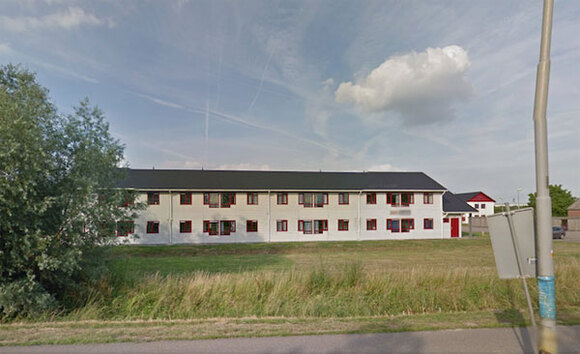
“De meeste respondenten tonen in de gesprekken een voorkeur voor een homogene bevolkingssamenstelling en een lichte achterdocht voor toenemende variatie. Dat komt voort uit hun goede ervaringen met gelijkgestemden in de buurt. Maar bij een politiek beladen onderwerp als de vluchtelingenkwestie is tolerantie en ‘samen de schouders eronder’ ook nadrukkelijk onderdeel van hun opvattingen.”
(Fragment uit: Vluchtelingen in Vinexland, 14 september, Yannick Sonne).
Wie zijn De Vinexmensen?
Via deze maandelijkse nieuwsbrief willen we u op de hoogte houden van de vorderingen van De Vinexmensen. Wij zijn een van de drie communities van het Jaar van de Ruimte, dat op 15 januari van start is gegaan.
De Vinexmensen wil weten hoe de Vinexwijken er, 25 jaar na het verschijnen van de Vierde Nota Extra, voor staan, maar kijkt ook vooruit: hoe ziet de toekomst van de Vinex eruit, en hoe gaan we die vormgeven?
In De Vinexmensen komen de stem van de gebruikers, het vertrouwen in bottom-up en de vraag naar de toekomst van de Vinex samen. Door middel van onderzoek, discussiebijeenkomsten en journalistieke projecten genereren we antwoorden op de vragen hoe de vijfentwintig jaar oude Vinex ervoor staat, en wat de opgaven voor de toekomst zijn.
We zoomen specifiek in op acht wijken: Leidsche Rijn (Utrecht), Vathorst (Amersfoort), Stad van de Zon (Heerhugowaard), Reeshof (Tilburg), de Waalsprong (Nijmegen), Nesselande (Rotterdam), IJburg (Amsterdam) en Almere-Buiten.
Voor meer informatie:
JaapJan Berg
Projectleider De Vinexmensen
E: vinexmensen@newtowninstitute.org
T: 06 26 348 903
Saskia Naafs
Assistent De Vinexmensen
E: info@saskianaafs.nl
T: 06 24 708 682
– www.vinexmensen.nl
– Twitter: @vinexmensen
– Facebook: Vinexmensen
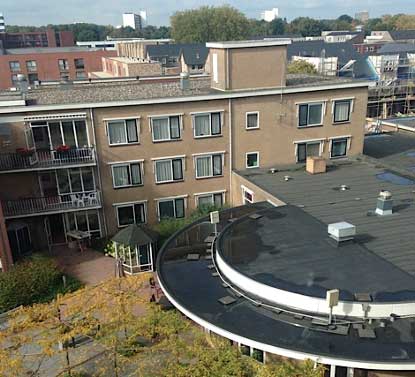
In samenwerking met het ministerie van BZK wordt onder begeleiding van het Atelier Rijksbouwmeester in een aantal plaatsen in Nederland het programma ’Oog voor de buurt’ uitgevoerd. Dit programma is gericht op het stimuleren van de (verbindende) rol van het ontwerp in wijken en gebieden, waar leefbaarheidkwesties in een toenemende mate spelen. Met multidisciplinaire ontwerpteams wordt gewerkt aan zowel sociale als fysieke vraagstukken in grootstedelijke wijken, krimpgebieden en anticipeerregio’s, waarbij de leefbaarheid voor de bewoners steeds centraal staat.
Dit programma loopt al enige jaren, (zie ook de website www.oogvoordebuurt.nl) en staat dit jaar in het teken van het onderwerp Zorg en Ontwerp. Bij dit thema heeft het atelier Rijksbouwmeester (opnieuw) samenwerking gezocht met het International New Town Institute (INTI) en de leerstoel Ontwerp en Overheid (Design as Politics), Faculteit Bouwkunde van de TU Delft. In overleg met geselecteerde gemeenten, corporaties en zorginstellingen wordt het ruimtelijk vraagstuk verdiept waarna een multidisciplinair ontwerpteam aan de slag gaat. Hiertoe in de gelegenheid gesteld vanuit het atelier van de Rijksbouwmeester.
Gemeenten en andere relevante organisaties die in de gelegenheid worden gesteld deel te nemen aan het project Oog voor de buurt worden gevraagd te participeren in een begeleidingscommissie en het ontwerpteam te voorzien van relevante informatie.
Op woensdag 7 oktober vond de kick-off van ‘Oog voor de buurt’ op de locatie in Deventer plaats. In het woon- en zorgcentrum Humanitas in de wijk Keizerslanden kregen de betrokken studenten van de TU Delft (Leerstoel ‘Ontwerp en overheid’) Dorris Derksen, Hedwig van der Linden, Maya van der Landen en Sarah Revill een aantal inleidende presentaties.
Marcel van Heck (Atelier Rijksbouwmeester), Han Beumer (Gemeente Deventer) en Dirk Metselaar (Humanitas) gingen ieder dieper in op de context van de opgave en op de verschillende ruimtelijke, zorg gerelateerde en sociale aspecten die hier relevant zijn. Daarna werden het woon- en zorgcentrum Humanitas en de omliggende wijk Keizerslanden nader verkend.
De komende maanden zullen de studenten samen met een interdisciplinair team bestaande uit JaapJan Berg van het International New Town Institute en Wouter Vanstiphout en Mike Emmerik van de leerstoel Design as Politics, samen met twee talenvolle jonge ontwerpers Hugo Corbett en Stef Bogaerds ontwerpend onderzoek uitvoeren naar zowel de herstructurering van het vastgoed als naar een intensievere relatie tussen het zorgcentrum en de wijk.
Aanstaande vrijdag 9 oktober zal eveneens de kick-off op de andere locatie van ‘Oog voor de buurt’, Zuid Scharwoude, plaatsvinden.
www.collegevanrijksadviseurs.nl/actueel/nieuws/2015/10/10/oog-voor-de-buurt-ontwerp-verbindt
Design as Politics from Delft University of Technology explored the relationship between work, architecture and urbanism in Shenzhen from October 30 until November 5, 2015. INTI introduced the group of 7 graduation students to the Da Lang Fashion Valley. It is one of the nine industrial parks in Shenzhen and an attempt to attract the creative industries. It hasn’t been entirely successful yet. The result: an isolated area with no connections to its neighboring urban village, half-empty factories due to a lack of investment, and no white-collar workers willing to live in these outskirts of Shenzhen. An iconic feature of Da Lang Fashion Valley is a three-year-old, but still vacant hotel. Da Lang Palace has 40,000 m2 of vacant space and symbolizes the problem of a mismatch between ambition and reality.
INTI has organized the exhibition Da Lang Fever 2.0. Empowering Migrant Society at the 2015 Shenzhen Biennale of Urbanism/Architecture. It proposes urban strategies to empower migrant workers in Da Lang Neighborhood. In the exhibition, architecture office space&matter presents possible scenarios for programming the vacant hotel to empower the self-organizing migrant society. INTI asked the graduation students from Design as Politics to do the same. Here is their proposal for programming the empty building.
INTI and magazine My Liveable City (India) organize a knowledge tour to the Netherlands from April 11 to April 16, 2016. Currently, 31% of India’s population lives in cities and that number is supposed to rise to 50% by 2030. In order to steer the urbanization process, the national government unveiled a list in 2015 of 100 cities that are supposed to become smart and allocated money for an urban rejuvenation program for another 500 towns and cities in the next 5 years. Last but not least, many new towns are being planned and developed to shape new industrial corridors. The knowledge tour will therefore expose Indian participants to Dutch expertise and give a deeper insight into the physical planning structure of the Netherlands in areas like New Town development, Smart cities, Sustainability issues, Regeneration & Redevelopment and Social Housing.
The participants will comprise a mix of academics, real estate developers, architectural and urban planning practitioners and Government of India dignitaries. For registration or to answer any further questions, please contact Zoya Sodhi at zoya.myliveablecity@gmail.com.
How can food products, grown in an urban environment, be sold and consumed in the city that grows them?
These are the questions with which a new city like Almere, which eagerly aims to develop its green image, deals with.
Therefore, in cooperation with Efibia Horticulture, the Flevo-hospital, Growing Green Cities Almere, INTI is organising a workshop on Urban Food Production for the students of CAH Vilentum, Windesheim Hogeschool, TU Delft and Wageningen University in Almere.
During this day, students will attend lectures about urban farming in New Towns in order to actually work out answers and solutions later. The morning lectures will be given by ir. Jan Eelco Jansma (Researcher Rural-Urban-relations at WUR), Tiffany Tsui (Architect en PhD student at Erasmus University on International Food Security), and Dr. ir. Yves van Leynseele (University of Amsterdam). They will touch upon the phenomenon of urban farming in New Towns such as Guangming and Nairobi and provide a relevant context in which students can get to work.
The most prominent question to be answered will be: what changes do we need in the chain of production, marketing, distribution and consumption to improve the urban agriculture landscape of Almere and avoid food waste? The Urban Food Production Workshop will take place on the 17th of March. For more information, contact us via: info@newtowninstitute.org
Photo: Efibia
From Factory of the World to World City"
The spectacular story of Shenzhen is well known: a collection of rural villages became a new town in 1979 when the central Chinese government gave it the status of Special Economic Zone. Shenzhen turned into a metropolis and became a prototype for both economic and urban reform within China.
This publication discusses the major constraints in the current urban planning process in Shenzhen. Alternative trajectories are drawn by exploring new stakeholders, new social and economic values, alternative strategies for redevelopment and future challenges for the ‘city of tomorrow’ within the Pearl River Delta.
Shenzhen: From Factory of the World to World City provides both a detailed overview of Shenzhen’s current planning issues and illustrates viable solutions. Its content is based on the results of INTI’s international, multidisciplinary research program New New Towns: Why we need to rethink the city of tomorrow today that was launched in Shenzhen in 2012.
With contributions by Markus Appenzeller, Marco Bontje, Du Juan, Fu Na, Tat Lam, Li Jinkui, Mary Ann O’Donnell, Qu Lei, Linda Vlassenrood, Ronald Wall, Huang Weiwen and Yeung Ho Man Legg.
• order the book at NAi Booksellers
Our event “New Towns; laboratories for implementation of the New Urban Agenda” has been selected as part of the official program of the Habitat III conference.
As our partner, member, colleague or friend, we invite you to join our event in Quito! Many competences and voices will help to formulate ideas and proposals to make the implementation of the New Urban Agenda a success.
This event, organized in partnership with Land and Housing Research Institite (LHI) and UN Habitat, wants to create the opportunity for New Towns to share knowledge and experiences to advance innovation in new cities and towns around the globe.
Thursday, 20th of October
9:30 - 10:30 a.m. Room R12
– 09:30 - 09:32 Introduction by moderator Bert Smolders, INTI Board member, Arcadis, UN Habitat, Shelter
– 9:32 - 09:35 Welcoming Speech of Kang Hoin, Minister of Land, Infrastructure and Transport, Korea
– 9.35 - 9.50 "The New Town perspective on the New Urban Agenda”, including film with voices of partners, Michelle Provoost, INTI Executive Director
– 9.50 - 9.57 “Implementation of the NUA in New Towns in developing countries”, Jeongjoong Yoon, Land & Housing Institute, Korea
– 9.57-10.01 "Toward a Platform to Support Sustainable New Town Development", UN-Habitat
– 10.01 - 10.15 Panel discussion with:
Markus Appenzeller (urban planner and partner at MLA+),
Christine Auclair (Project Leader WUC),
Germanico Pinto, Ecuador (president of Ciudad Smart)
Ric Stephens (president of ISOCARP)
– 10.15-10.30 discussion with the participants
The event “New Towns; laboratories for implementation of the New Urban Agenda” is an action-oriented initiative that aims to produce realistic and concrete future projects by creating partnerships between New Towns.
What are the most important challenges and opportunities on the agenda of New Towns? How can questions of livability, demography, participation, work, accessibility and mobility be transformed into guidelines for the design of new towns?
By creating and extending the platform in synergy with other international urban professional networks and organizations and by linking the questions raised by those cities, INTI aims to get stronger answers for the implementation of the new urban agenda.
The ultimate goal of this event is to connect professionals and representatives from New Towns worldwide and nourish a solid process of mutual learning. With the network and platform that INTI creates, examples of implementation will become accessible for similar cities, universities and design professionals.
In 1964 the ‘United Nations Symposium on the planning and development of new towns’ took place in Moscow. At that moment a rapid urbanization took place all around the world and international experts questioned and discussed the quality of the new necessary urban developments. The new towns from this post war period still exist and define a great part of the urbanized world: all dating from the same period, they now face questions posed by an ageing population, mobility, livability. Nowadays the level of urbanization is expected to rise further, mainly in the fast-growing global south. New cities are being planned and built under different circumstances than in the fifties and sixties but with the same goal: to house, shelter and provide services for the people. More than 50 years after the UN symposium in Moscow, the International New Town Institute (INTI) wants to put the development of these two generations of new towns on the New Urban Agenda and discuss the challenges and opportunities of the existing and future new towns.
The side event in Quito has a specific focus on new towns: some are older and in the midst of transforming and reinventing themselves, others are presently on the drawing boards. New Towns are a special category of cities, with their own characteristics and specificities, however they share the same DNA: they are built according to a master plan, from scratch on a location where previously there was no city, and they have a high degree of political autonomy. New Towns have existed ever since humanity started organizing itself in settlements. Planned communities have always been the ultimate challenge for politicians and designers: what is the ideal city? What is the city of tomorrow?
The event was preceded by the first International New Town Day held on June 30 in Almere, the Netherlands, where the New Towns Perspective on the New Urban Agenda was presented. It selected the priorities within the Agenda for New Town planning and suggested alternative strategies to create more inclusive and livable cities.
Summary of INTI’s activities in Quito
INTI Side Event
‘New Towns: laboratories for implementation of the New Urban Agenda’, organized by INTI in partnership with LHI and UN-Habitat
Oct 20th, 2016 | 9:30 - 10:30 a.m. Room R12 | Casa de la Cultura Ecuatoriana Benjamín Carrión
Expert Group Meeting
’Achieving Sustainable New Town Development in Developing Countries’, co-organized by UN-Habitat, LHI and INTI
Oct16th, 2016 | 15:00-18:00 Room 14 | Casa de la Cultura Ecuatoriana Benjamín Carrión
INTI on the radio, Fabrica Ciudad #17
INTI runs a radio programme in Quito! At Fabrica de Ciudad, on october 19th, 14.00-18.30
‘Making Cities Together: placemaking in emerging countries’
KUWA urban spaces and Placemakers will host this event as part of the Pop-Up Public Space series to promote the development of public spaces through placemaking in emerging countries by showcasing the project ‘Making Cities Together’ in Nairobi, Kenya of which INTI is one of the initiators. On October 18th, 2016, 17.00 – 18.00 a.m. at ONE UN Pavilion
‘Smart Cities in the New Urban Agenda’
INTI Director Michelle Provoost will contribute to the workshop ‘Smart Cities in the New Urban Agenda’ organized by ISOCARP, on October 19th 2016, 12:30-1:30 pm, in Room MR10, Casa de la Cultura Ecuatoriana Benjamín Carrión
“Comments on a Global Urban Convergence”
INTI Director Michelle Provoost will contribute to the event organized by Neville Mars, on October 20th, 7.30 - 9.30 pm at the Fabrica Ciudad.
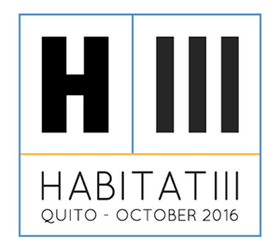
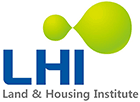

From Oct 13-21 INTI will be based in Quito at the Habitat III conference and is looking forward to welcome you. Check out the INTI’s activities agenda and join us!
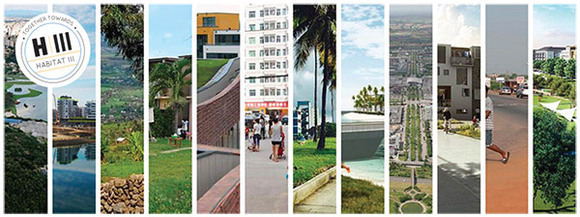
Expert Group Meeting
This event is co-organized by UN-Habitat, LHI (Land and Housing Institute, Korea) and INTI. Against the background of the exponentially increasing number of New Towns built in developing countries, this meeting discusses the possibilities to arrive at a policy guide for the development of New Towns. Over the past decades, we have seen problems arise due to wrong choices of location, very low densities and the absent of efficient public transport. New Towns have exacerbated segregation and are not ecologically sustainable. A lack of attention and public debate keeps regenerating the same problems in various countries. In order to fill this gap, joint research for the development of an international policy guide on sustainable New Town development was launched by UN-Habitat and LHI, in collaboration with INTI.
– When: October 16th, 2016 | 15:00-18:00
– Where: Room 14, at the Casa de la Cultura Ecuatoriana Benjamín Carrión
International New Town Radio, Fabrica Ciudad #17

INTI Radio will be a unique one-day event at the Fabrica Ciudad in which we will install and operate a pop-up radio specially dedicated to several subjects discussed during the UN Habitat Conference. INTI will invite speakers from the conference to step out of the official program and to talk, discuss and dream on the future of New Towns. Speakers will not only be asked to share their thoughts and ideas but also share some of their favorite music associated with their city and culture.
– When: October 19th, 14.00-18.30
– Where: Fabrica Ciudad at Centro Cultural Benjamin Carrión
INTI Side Event
In partnership with the Korean Land and Housing Institute and UN-Habitat, this event is an action-oriented initiative that aims to produce realistic and concrete future projects by creating partnerships between New Towns.
What are the most important challenges and opportunities on the agenda of New Towns? How can questions of livability, demography, participation, work, accessibility and mobility be transformed into guidelines for the design of new towns?
By creating and extending the platform in synergy with other international urban professional networks and organizations and by linking the questions raised by those cities, INTI aims to get stronger answers for the implementation of the new urban agenda.
– When: October 20th, 2016 | 9:30 - 10:30 a.m.
– Where: Room R12 | Casa de la Cultura Ecuatoriana Benjamín Carrión
– A provisional programme is available
‘Making Cities Together: placemaking in emerging countries’
KUWA urban spaces and Placemakers will host this event as part of the Pop-Up Public Space series to promote the development of public spaces through placemaking in emerging countries by showcasing the project ‘Making Cities Together’ in Nairobi, Kenya of which INTI is one of the initiators.
– When: October 18th,2016, 17.00 – 18.00 a.m.
– Where: ONE UN Pavilion
INTI Director Michelle Provoost will contribute to the workshop
– When: October 19th 2016, 12:30-1:30 pm
– Where: Room MR10, Casa de la Cultura Ecuatoriana Benjamín Carrión
– Read more: isocarp.org/news/isocarp-workshop-habitat-3
Last but not least, we will also participate in Neville Mars’ event
– When: October 20th, 2016 | 19.30-21.30 pm
– Where: Fabrica Ciudad at Centro Cultural Benjamin Carrión
Your contribution
If you want to know more and interested to join our events, please contact us: info@newtowninstitute.org
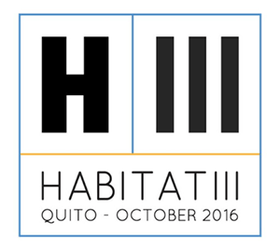

Three weeks ago INTI was in Quito, Ecuador for the Habitat III conference with Jorn Konijn. We made a full day of radio, talking to architects, planners, artists, local activist and policy-makers to discus the future of living in the city around the world. You can now listen back to all the talks on ’Ja Ja Ja Nee Nee Nee’ radio here.
We interviewed amongst others Pedro Rivera, Laura Sobral, David Barragán Andrade, Charlot Schans, Neville Mars, Tatu Gatere, Naomi Hoogervorst, Michelle Provoost, Simone Rots and many others.
Listen to the local architects of ’AlBorde’, talking about creating a new type of practice of architecture. Check it out here.
Big thanks to Priscilla Jaramillo for the production and Reinier Klok and Arif Müller for hosting.
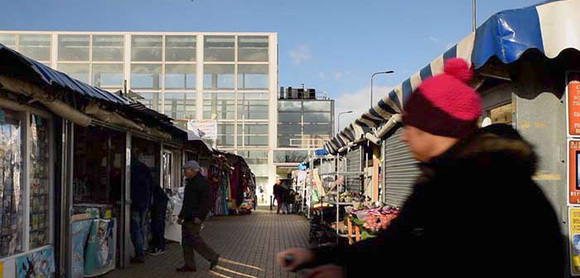
During November 22-23, INTI was in Milton Keynes for the first of five meetings as part of the New Towns Arrival Cities project. Initiated as a platform for New Towns to learn from each other’s experience with accommodating rapidly growing and diversifying populations, the two-year EU-funded project brings together local communities and representatives from the six European partner cities of Milton Keynes, Sabaudia (Italy), Grand Paris Sud (France), Vällingby (Sweden) and Aarhus (Denmark).
Planned for homogeneity, strained by a growing population and increasing diversity
Milton Keynes was built in 1967 as part of the third generation of cities mandated by the 1946 British New Towns Act, and was to more flexibly accommodate organic growth compared to its predecessors. It is equipped with an efficient American-style road grid with roundabouts and a continuous network of pedestrian paths and bicycle “redways”, a robust structure of 1km2 “gridsquare” neighbourhoods with their own local centres, a high-modernist Town Centre with heritage status, and green parks covering 40% of the city’s total area. Planned for a homogeneous white population, however, the city’s social infrastructure is being strained by rapid migration, with ethnic minorities now accounting for more than a quarter of MK’s inhabitants. The influx of newcomers, together with social housing being replaced with private sector renting, have led to transient communities, social problems, and the general decline of gridsquare neighbourhoods such as Netherfield and Fishermead. Diminishing state resources have also contributed to the closing of several local centres and the commercialization of public spaces such as the Town Centre, originally designed as an open High Street. There is a lack of the kinds of neutral common spaces that invite mixing and social cohesion, which is compounded by the insufficient public transportation that limits the mobility of those who cannot afford a car or are too young to drive.
Art, Culture and Identity
Since its beginnings, grassroots volunteer cultural organizations have been active in building Milton Keynes’s vibrant art scene, and it is these groups that the City Council is now turning to as a way of establishing a platform for cultural exchange and social cohesion. They include the MK Museum, the MK Islamic Arts Heritage and Culture Organization which organizes the annual Art in the Park event and education programmes about cultural heritage, or the Global Outreach Foundation which organizes the African Diaspora Day and “Breakfast Club” meetings for discussing community culture-related issues. Despite a potentially problematic blurring of religious interests and public services, these art and cultural initiatives bring people together and educated about cultural differences. They are also a way of redefining Milton Keynes’s New Town identity to reflect the reality of its cultural diversity.
– More information about the lab results
– Videos of speaker presentations
INTI was in Curitiba, Brazil during December 4-8 for a New Town Lab that developed a future scenario for the city’s southern informal settlement Caximba. Curitiba, a middle-sized city located in the south of Brazil, is known as a textbook example of good urban planning due to amongst others its cheap and high-quality public transport system with buses and dedicated bus lanes, its extensive green spaces and its waste management system. But aside from all the good planning examples, Curitiba is like many cities in the Global South facing the problems of rapid urbanization, such as increasing homelessness and the development of informal settlements.
Key urban challenges
The Caximba informal settlement lies in the Barigui Basin at the crossing of the Barigui and Iguazu rivers. Addressing the risk of flooding and controlling urbanization along the borders of the Environmental Protection Area (APA) of Barigui are key concerns for the city, as well as improving the area’s social security, mobility and public space.
Rethinking Curitiba
In the ‘Nova Caximba’ strategy the existing green structures are the starting points, using the flood zones for water-management, adding bike and slow traffic paths where these areas meet the city, thereby creating a border for urban expansion while making the green areas more accessible. Between these natural borders a robust urban grid, based on a sites & services model, incorporates evenly the existing informal settlement. The mixed-use plots contain affordable housing, collective spaces and areas for agriculture. Community involvement is supported by urban agriculture, self-construction programmes for housing, and by three multifunctional community centres at the intersection of transportation routes and natural areas. These include libraries, healthcare, sports facilities and administrative centres, as well as local markets.
The interdisciplinary design team
The strategy is the result of a close collaboration between IPPUC (Curitiba’s planning department) and the INTI team which included Marco Vermeulen (Studio Marco Vermeulen), Martin Sobota (Cityförster), Rodrigo Bandini dos Santos (Mecanoo), Jorn Konijn (INTI) and Simone Rots (INTI). Additional input was given by the Mayor and by the Popular Housing Company of Curitiba (Cohab-CT). IPPUC’s president emphasized the project’s importance for beginning the process of developing this sensitive area.
– More about the planning workshop (via IPPUC’s website, in Portuguese)
– More about the planning workshop (via IPPUC’s website, in Portuguese)
INTI’s exhibition “Checklist or Reality Check? Research by design in Guangming New Town” will open on December 23 at the seventh Bi-City Biennale of Urbanism and Architecture (UABB) in China, which is themed “Cities Grow in Difference”. Curated by Linda Vlassenrood (INTI) in collaboration with Markus Appenzeller (MLA+), it will present the results of four urban planning workshops between 2015-2017 as part of our advisory role for the urban planning department of Guangming New Town.
Chinese urban planning is still a top-down process
The dense informal urbanism of Shenzhen’s urban villages testifies to the urgency of introducing an alternative planning approach. Taking up 5% of the city’s area, these peripheral villages house 50% of the city’s population, housing those who moved to the city but cannot afford to live in its centre. As in other Chinese cities, urban development is still a top-down process with little communication between various departments and design experts, and with limited participation from local stakeholders such as inhabitants or companies.
A more inclusive planning approach
In 2015, Guangming New Town – one of the four New Towns in the area outside Shenzhen – asked INTI to act as advisors for the city’s urban planning department. Our consultant team introduced a multidisciplinary design approach, developing strategic frameworks for large-scale urban projects and strengthening the municipality’s capacity by giving guidelines for directing, monitoring and testing projects, and implementing development processes with the involvement of many different stakeholders.
– More about the Biennale
– More about INTI’s work in Shenzhen
Info about the street image: Guangming’s current bike system is disrupted by crossings and dead ends, and is often blocked by parked cars.
Dit programma, dat INTI in samenwerking met de Rijksdienst voor Cultureel Erfgoed is gestart, onderzoekt hoe jong erfgoed een positieve rol kan spelen in de ruimtelijke ontwikkeling van de Nederlandse New Towns, de groeikernen. Hoe kunnen ze de huidige bouwopgave aangrijpen om tot een kwaliteitsverbetering van hun steden te komen? Welke aanpak past bij hun ruimtelijke kenmerken (de kleinschalige structuren, labyrintische stedelijke weefsels) en structurele kenmerken (zoals een hoog percentage van particulier eigendom)? Dit vraagstuk bevindt zich op het kruispunt van erfgoed en transformatieopgaven en kan daarom het beste in samenhang onderzocht worden.
Daarbij gebruiken we twee instrumenten:
- De Groeikernenkring, een netwerk waar vertegenwoordigers van de erfgoed en de ruimtelijke ontwikkelingsafdelingen van groeikernen onderling kennis en ervaring uitwisselen.
- De New Town Labs, compacte research-by-design workshops met vooraanstaande Nederlandse landschaps- en stedenbouw ontwerpers, architectuurhistorici en architecten gekoppeld aan lokale stedenbouwkundigen, ontwerpers en beleidsmakers.
Zie het verslag van het eerste Lab dat in Zoetermeer plaatsvond van 7 tot 9 mei 2019
This program, started in cooperation with the Rijksdienst voor Cultureel Erfgoed, investigates how young heritage can play a positive role in the spatial development of the Dutch New Towns, the so called ‘growth centers’. How can these cities use the current building boom to improve the quality of their cities? Which approach fits their spatial characteristics (small-scale structures, labyrinthine urban fabric) and structural characteristics (such as a high percentage of private ownership)? This issue lies at the intersection of heritage and transformation tasks and can therefore best be examined in conjunction.
We use two instruments for this:
- The Groeikernenkring, a network where representatives of the heritage and the spatial development departments of the ‘growth centers’ exchange knowledge and experiences with each other.
- The New Town Labs, compact research-by-design workshops with leading Dutch landscape and urban designers, architecture historians and architects linked to local urban planners, designers and policy makers.
See the report of the first Lab that took place in May 2019 in Zoetermeer
On the invitation of Milton Keynes we programmed a day during the Festival of Cultural Urban Living which is taking place from September 23rd to October 13th and is curated by RaumlaborBerlin. During that period, Midsummer Boulevard in central Milton Keynes will bring together citizens, artists, architects, urban planners, creatives and many others to deliver a free programme of exhibitions, events, creative workshops and performances.
On October 3rd, the topic is ‘Utopian Radicalism’. We have compiled a program around the new tendencies of self-organisation popping up all over Western Europe which are especially relevant in New Towns. After all, New Towns have always been built according to a masterplan, a blueprint made by professional designers and built by a government and professional managers. But nowadays residents ask for a more active role, more freedom and agency and they have started to organize themselves. Because they are usually not profit-driven, they can bring interesting new experiments in housing and social projects, create more diversity, better value for money, and include groups of inhabitants that would normally be excluded from the market.
During this day we bring examples of inspiring and provocative projects from (mostly) other New Towns who have been designed and realised by (groups of) residents, as an alternative to the ‘business as usual’ way by commercial parties. With: MVRDV, Stad in de Maak, Superblock, Rotterdam Housing Cooperative, De Warren Cooperative Amsterdam, Raumlabor, Studio Ossidiana.
As New Towns across Europe experience changing dynamics due to increasing migration of foreign workers, refugees, asylum seekers and international students, among others, “New Towns, Arrival Cities” approaches these cities as potential laboratories of inclusion and experimentation, asking whether they can revive the spirit of urban and social innovation of the early days of their foundation. The two-year project brought together European city representatives, researchers, students, local migrant communities and experts to engage in a series of intercultural events, organised as five “New Town Labs” in five cities: Milton Keynes (UK), Sabaudia (Italy), Grand Paris Sud (France), Vällingby (Sweden) and Nissewaard (The Netherlands). The programme, consisting of public activities such as site visits, seminars, workshops and conferences, was led by the Municipality of Nissewaard (Spijkenisse), coordinated by the International New Town Institute and funded by the EU (Europe for Citizens).
The results of the New Town Labs are summarized in this report, bring out the unique and complex set of issues faced by each city in question, largely stemming from variations in size, administrative organisation, founding principles and cultural backgrounds. Especially considering the sensitive and often controversial nature of the topic of migration, this project uses a number of different lenses to engage with the core values of each city and country explored: heritage, art and culture, public space, building a positive narrative, adapting the welfare state model, and government-resident relations.
In the light of the present building boom in Africa, INTI has researched the quality of the urban plans for New Towns on the continent, which often leaves a lot to be desired. To critique the many shortcomings of these masterplans is easy, but can we also help to improve them? Using (good and bad) examples from more than 40 New Towns worldwide, we distilled 10 main principles for New Town planning and design. We bundled them in The Manual, which offers an alternative approach for planners, designers, developers and decision-makers aiming to construct more inclusive and sustainable New Towns in Africa. Or in any other part of the world for that matter.
The Manual consists of a set of ten design and planning principles:
- Planning is an ongoing process
- Plan for adaptivity
- No New Town is an island
- Use no cut and paste universal model
- Embrace new ideas
- Infrastructure and mobility for all, from the start
- Use a blue-green infrastructure as the central framework
- Incorporate local cultural heritage(s)
- Combine top-down and bottom-up
- New Towns need diversity
We are making this Manual available for free and invite you to use it and disseminate it (and comment on it if you want on info@newtowninstitute.org).
See the Manual here (pdf 16Mb)
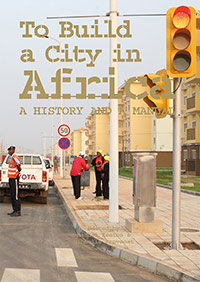
The Manual is part of our recent publication ‘To Build a City in Africa; a History and a Manual’ (Rachel Keeton and Michelle Provoost, eds.). The book explores the complex implications of New Town developments in Africa through interviews with different stakeholders, in-depth case studies and essays that elaborate specific issues connected to these New Towns.
You can order the publication R. Keeton, M. Provoost (eds), To Build a City in Africa. A History and a Manual here.
The Guardian published an article from the book:
www.theguardian.com/cities/2019/jul/10/new-cities-in-the-sand-inside-egypts-dream-to-conquer-the-desert
For Dutch readers, here’s a piece in newspaper Trouw:
www.trouw.nl/nieuws/in-afrika-schieten-in-hoog-tempo-nieuwe-steden-uit-de-grond-en-dat-levert-doodse-plekken-op b6ae7050/
And another review: Ruimte + Wonen: www.ruimteenwonen.nl/to-build-a-city-in-africa
INTI presents a project at the 8th Bi-City Biennale of Urbanism\Architecture (UABB) in Shenzhen: Dalang Fever 3. This project is a continuation of the research and exhibitions on the same area in Shenzhen, presented at two previous editions of the Biennale and curated by Linda Vlassenrood. This time, it is a cooperation with Het Nieuwe Instituut. Dalang Fever 3 is also part of the DATAstudio programme (2015 – 2019) of Het Nieuwe Instituut, which addresses the question of how data and technology can benefit citizens and neighbourhoods.
Dalang Fever 3.
How data can empower a migrant society
Under the lead of MIT professor Carlo Ratti the Biennale reflects on the consequences of digital technologies on daily urban life. In Shenzhen, which is in many ways a forerunner of the application of digital technologies in public space (a.o. facial recognition), people’s needs are rarely put at the centre of data collection. Dalang Fever 3. How data can empower a migrant society is a participatory research project aiming to understand the desires and needs of residents in Dalang, a rapidly transforming neighbourhood on the outskirts of Shenzhen.
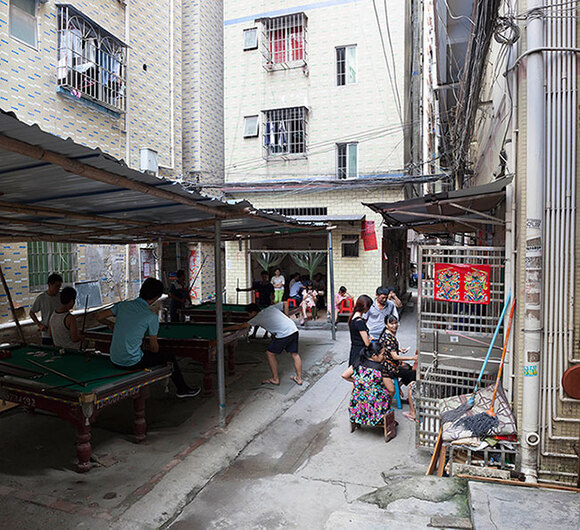
Very little data – except from inaccessible user data – is available on the migrants living and working in this remote and often overlooked area. Het Nieuwe Instituut and the International New Town Institute (INTI) collaborated with Impact Hub Shenzhen to independently collect quantitative and qualitative data anonymously to provide genuine insights and a richer sense of the human interaction, needs and network in the area. The research team collected structural and semi-structural data from 350 people living and working in the research area of Dalang through interviews and online questionnaires.
Dalang Fever 3 proposes the next steps for improving living conditions and the urban environment. A multidisciplinary data and design team with spatial and social expertise will analyse the collected data in a workshop at the Biennale, using their different lenses to propose improvements in Dalang. It will be an iterative process that questions the use of data in order to incorporate people’s needs into the continuous transformation of the area. How should we collect data and make it accessible? What spatial, organisational and digital transitions should be instigated?
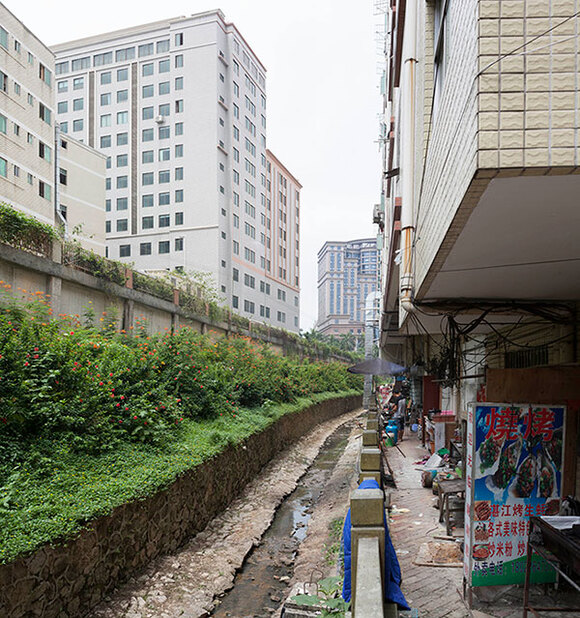
Information
Dalang Fever 3 consists of research, an exhibition and a workshop curated by Linda Vlassenrood (independent curator). The research has been conducted by Impact Hub Shenzhen (headed by Tat Lam). The exhibition design and graphics are developed by Koehorst in ‘t Veld.
Dalang Fever 3 is part of the Eyes of the City section curated by MIT professor Carlo Ratti (Chief Curator), Politecnico di Torino and SCUT (Academic Curators). Eyes of the City is one of the two main sections that form the 8th edition of UABB, dedicated to the overarching theme of Urban Interactions. The other main section, called Ascending Cities, is curated by the leading Chinese academician Meng Jianmin and the Italian art critic Fabio Cavallucci.
The Bi-City Biennale of Urbanism\Architecture (UABB) takes places in Shenzhen, 21 December 2019 - March 2020. More information: https://www.archdaily.com/928899/the-shenzhen-and-hong-kong-2019-bi-city-biennale-reflects-on-technology-and-urban-life
The International New Town Institute is ecstatically happy but not at all surprised that our Director Michelle Provoost is this year’s laureate of the biannual Rotterdam Maaskant Award. Every other year the prestigious award is given to a person or an organisation that has distinguished itself in the fields of architecture, urban design, and landscape architecture through journalism, teaching, and/or research activities.
Some former Laureates are Ed Taverne, Rem Koolhaas, Riek Bakker, Dirk Sijmons, Piet Oudolf and the Directorate General for Public Works and Water Management.
The jury commends Michelle for combining reflection with action and for engaging others with the fate of the city through her own, original vision. The honor of the award is bestowed upon her for her "profound research of the global city and into all those social issues that are rooted in the built environment.”
“De Grote Maaskantprijs wordt dit jaar toegekend aan Michelle Provoost, directeur van het INTI, lid van het Dean-Team van de Independent School for the City, en partner bij Crimson Historians & Urbanists. Provoost combineert reflectie met praktijk, en weet vanuit een originele zienswijze anderen te betrekken bij het wel en wee van de stad. De jury kent de prijs toe voor haar werk, dat diepgaand onderzoek verricht naar de (mondiale) stad en maatschappelijke vraagstukken die in de gebouwde omgeving verankerd zijn.
Provoost toont zich een zorgvuldig denker, wiens werkwijze bij uitstek geschikt is voor de huidige periode van transitie, waarin grootschalige maatschappelijke vraagstukken hun weerslag hebben op de oude zekerheden van het bouwen. Zij weet de gebouwde omgeving te ontrafelen vanuit concrete feiten en plekken, waarbij vele perspectieven worden aangeboord vanuit onderzoek, observaties en ervaringen van zowel onderzoeker als gebruiker. Specifieke problemen krijgen daarmee een grotere context, zoals de ruimtelijke kwaliteiten van de naoorlogse stad, de werking van de publieke ruimte, of de inrichting van bottom-up strategieën.
Provoost ontwikkelt haar werk – dat in zichzelf van hoog niveau is – nadrukkelijk in samenwerkingen, in binnen- en buitenland. Hiermee creëert ze draagvlak voor een breder perspectief. Haar houding streeft naar het wegnemen van vooringenomenheid en het openstellen voor gesprek. Juist door zich te onthouden van directe oordelen, weet Provoost onverwachte perspectieven aan het licht te brengen. Het is die kwaliteit die haar historische, observerende en ook activistische blik blijvend van waarde maakt voor de actuele praktijk van architectuur en stadmaken.”
(www.rotterdammaaskant.nl)
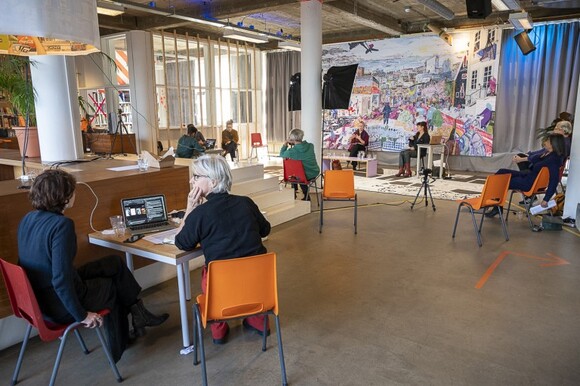
On the 16th of October, we co-hosted the international symposium Taking Back Housing! together with the Independent School for the City. During the online symposium, speakers from the Netherlands and abroad talked about the challenges of alternative housing projects such as housing cooperatives. Thanks to all the speakers and the audience, we were able to yet again host a great International New Town Day edition. In order for everyone to learn from these insightful presentations we have opened the live stream to the public. Feel free to watch it again, share it, and start conversations!
During the first block, Michelle Provoost points out the urgencies of the topic, Peter Kuenzli introduces us to the history and the background of housing cooperatives in the Netherlands followed by Maarten van Poelgeest on the necessity to democratize housing. During the second block, multiple examples from the Netherlands are shown: Gerard Roemers presents housing cooperative de Warren in Amsterdam, Arie Lengkeek talks about Het Rotterdams Woongenootschap) and Piet Vollaard presents Stad in de Maak (City in the Making, Rotterdam).
In the third block, successful examples from abroad are presented. Han van de Wetering talks about the Genossenschaften in Zürich and Lina Hurlin tells us about the Mietshauser Syndikat in Germany. Darinka Czischke (TU Delft) gives a critical reflection afterwards. During the final, fourth block, the ambitions and plans of Amsterdam and Rotterdam are discussed. Marije Raap presents Amsterdams Action Plan followed by reactions from architect Marc Koehler and urban planner Jacqueline Tellinga. Annet Akkerma presents the policy of Rotterdam followed by reactions from architect Ninke Happel and architect Laura Weeber. Michelle Provoost ends the symposium by stating her final remarks.
Annet Akkerma
Annet Akkerma was the coordinator of strategy and policy at housing corporation Vestia; since 2016 she is a policy advisor for Housing for the municipality of Rotterdam. Part of her portfolio is the topic of‘ innovative housing and living’.
Arie Lengkeek
Arie Lengkeek works an independent curator and program maker under the name Arie Lengkeek / commongrounds. His motive is to develop new common grounds as training places for the city of tomorrow, integrating cultural values, economic drivers and social fabric. He is one of the initiators of Het Rotterdams Woongenootschap, and wrote the pamphlet ‘Operatie Wooncoöperatie’ to advocate cooperative housing as the third pillar in a just and inclusive urban development.
Darinka Czischke
Dr Darinka Czischke is Associate Professor at the Faculty of Architecture and the Built Environment, Delft University of Technology. In 2014 Dr Czischke was awarded the Delft Technology Fellowship to develop her research on Collaborative Housing. She is the founder of the Co-Lab Research group at the TU Delft and co-founder of the working group ‘Collaborative Housing’ at the European Network for Housing Research (ENHR). Previously, she worked as Director of World Habitat (2013, formerly Building and Social Housing Foundation, BSHF); Research Director of the European Social Housing Observatory at CECODHAS Housing Europe; and as Research Associate at the LSE Cities Programme, London School of Economics and Political Science. She has published extensively about social, affordable and collaborative housing in comparative international perspective.
Gerard Roemers
Gerard is a co-founder board member at De Warren, the first housing coöperation in Amsterdam that designs and builds its own real-estate. The project aims to realize 36 apartments: sustainable, and at affordable prices. Outside of this personal project, Gerard works as a sustainability consultant at Metabolic. He’s been educated in spatial planning as well as environmental sciences and industrial ecology. Within Metabolic Gerard combines these disciplines by specializing in circular urban planning and design. Within De Warren Gerards main focus is on realizing a sustainable building design: the design foresees an energy-neutral, using renewable and circular building materials wherever possible, and providing a place to live for urban flora and fauna as well as the human inhabitants of de Warren.
Han van de Wetering
Han van de Wetering is urbanist and architect and founder of the urban design studio “Van de Wetering Atelier für Städtebau” in Zurich. With his office he won many prizes and competitions and is laureate of the Swiss Urbanism Award (“Stadtlandpreis”). He is a leading expert in cooperative housing developments, especially dealing with its contribution to an attractive, open, sustainable city and its integration in new urban planning strategies. He publishes regularly and lectures at various Swiss universities.
Jacqueline Tellinga
Jacqueline Tellinga is a Dutch planner and urbanist who manages experimental urban developments, both large and small scale. Tellinga is a member of the Professional Association of Dutch Urban Designers and Planners (BNSP), the Dutch National Expert Team Housing and of The Right to Build Task Force in the UK. For more than ten years now she worked in various capacities on projects related to the topic of self-building. As the project manager of the Homeruskwartier in Almere with 1.400 individual plots she has been responsible for the largest self-build area in the Netherlands. The latest project being BouwEXPO Tiny Housing.
Laura Weeber
Laura Weeber is an architect and consultant at Urbannerdam. With her architectural firm, she stood at the cradle of the first developments in housing construction, to ever-increasing freedom of choice for buyers and residents in the design of their homes with the project Groeiwwoningen Expo 2001 in Almere. She strives to enrich the city with special residential communities, to provide space for people to create their own living environment, and to make exceptional homes possible for a niche market.
Lina Hurlin
Lina Hurlin is an activist dedicated to the right to the city and good housing for all. Since 2013 she is active in the German "Mietshäuser Syndikat" a solidarity-network of more than 150 non-profit and deprivatized house projects.
Maarten van Poelgeest
Maarten van Poelgeest has been appointed by the municipality of Amsterdam to explore and boost the municipal Housing Cooperative Action Plan to stimulate the growth of Housing Cooperatives in Amsterdam. Previously van Poelgeest (Green Party) was an alderman at the municipality of Amsterdam, responsible for Spatial Planning, Area Development, Climate & Energy. He’s now affiliated with Andersson Elffers Felix (AEF), a consultancy specialised in social issues and governmental support.
Marc Koehler
Marc Koehler is the founder of Marc Koehler Architects (MKA), a multidisciplinary design agency based in Amsterdam, and initiator of Superlofts. He believes that design has the power to help people create the life of their dreams and allows them to both feel at home and belong to something greater. With the bigger picture in mind, he sees the potential of architecture to harness the flow of nature, people, energy, material and capital, thereby revealing new ways to restore the balance between people and planet. An ongoing MKA-project, Superlofts is a customizable co-living and development model based on modular, prefab and Open Building systems.
Marije Raap
Marije Raap works for the City of Amsterdam, department as programme manager Housing. She is a manager for the programme to enlarge possibilities for Housing cooperatives in Amsterdam. From 2011-2019 she was a member of the self-buid team of the city of Amsterdam. Marije studied Architecture and participated in various projects like researching quality and processes of smallscale urban developments ‘The intermediate size’.
Ninke Happel
As part of the architecture firm Happel Cornelisse Verhoeven, Ninke Happel handles a broad portfolio of public buildings, redevelopments, residential buildings and public interiors. Given the firm’s marked interest in the cultural-historical layering of cities and buildings, most of its projects are located at the interface between old and new. The practice’s approach is one of regenerative synthesis, juxtaposing past and present in such a way that they reinforce one another’s special qualities. The team exist of sixteen master degree architects. Ninke Happel, Floris Cornelisse and Paul Verhoeven lead the practice based on their different but complementary backgrounds. Next to the office, they take part in the architectural debate, they teach in various institutions, give lectures and act as guest critics both at home and abroad.
Peter Kuenzli
Peter Kuenzli was director of the municipal housing corporation in Rotterdam, project leader for the reconstruction of Roombeek in Enschede and is presently a member of the board at Rotterdamse Woongenootschap. He has experience of more than three decades in strategic urban planning and project management.
Piet Vollaard
Piet Vollaard (1955) is educated at TU Delft faculty of Architecture (1984) and works as an architect, architecture critic, urban activist and a promotor/project initiator of nature-inclusive design and urban nature. He has been visiting teacher and lecturer at several architecture schools in the Netherlands, notably TU Delft Faculty of Architecture, School of Architecture Amsterdam, Arnhem and Rotterdam (1985 until present). He was co-founder/director of ArchiNed, the architecture website of the Netherlands (1996-2013)’. He is currently active in and co-founder of The Natural City (urban nature projects, 2012- present) and City in the Making (co-housing and alternative, unconventional programming of vacant urban property 2012 - present).


